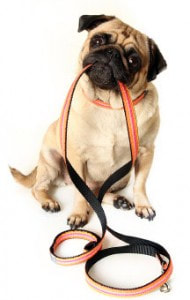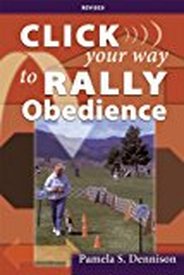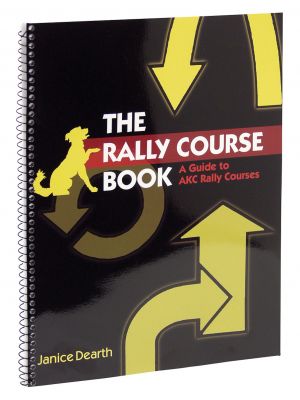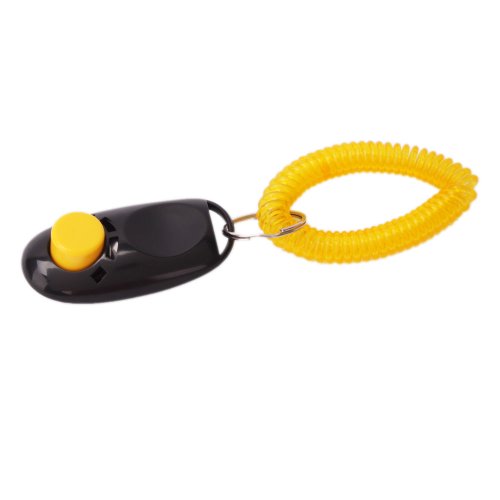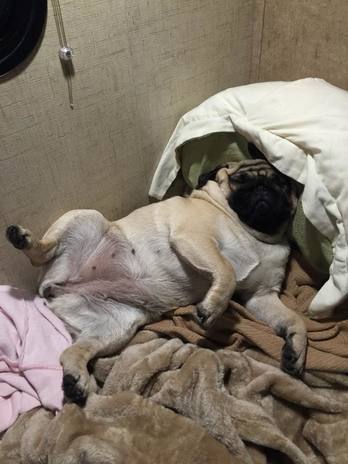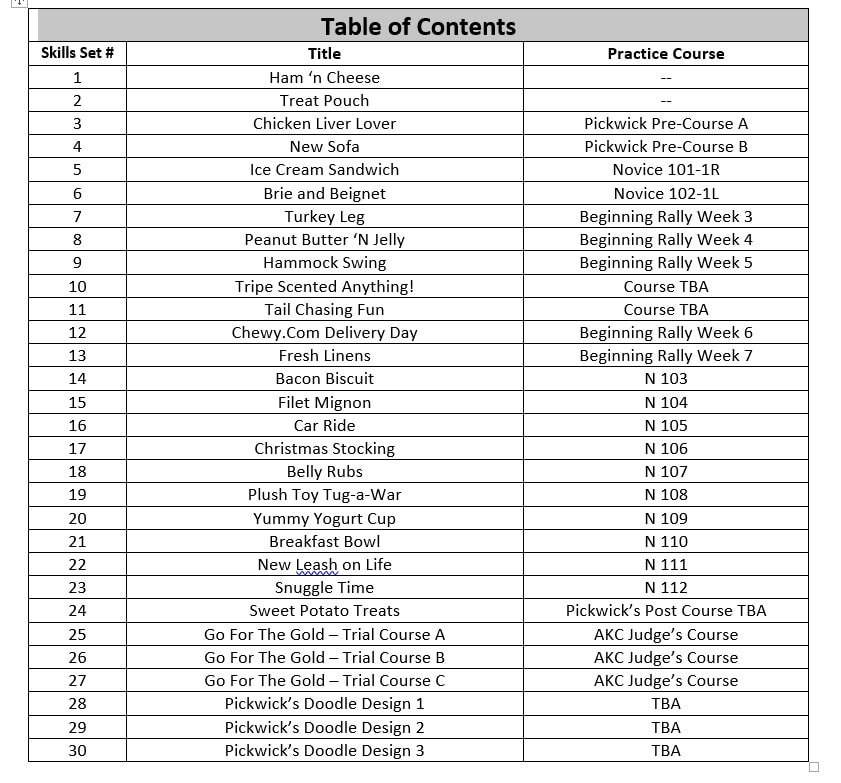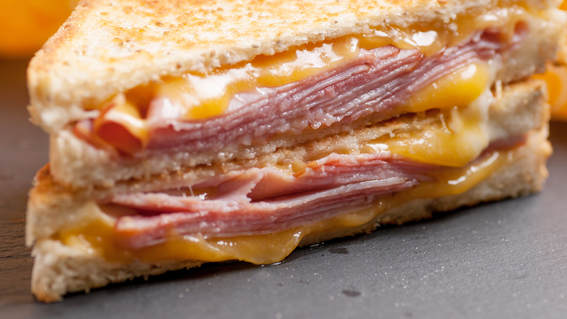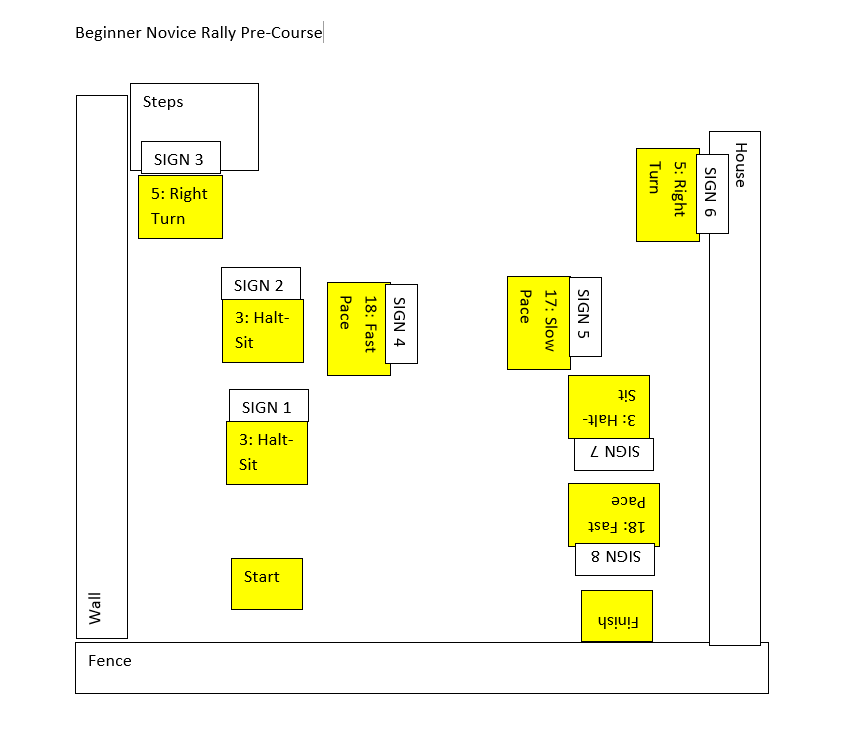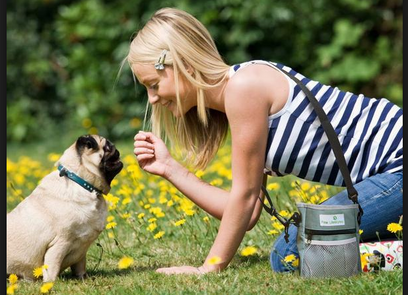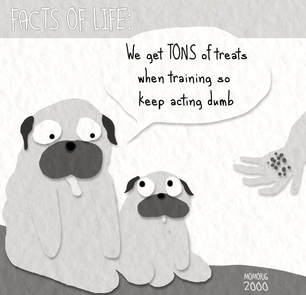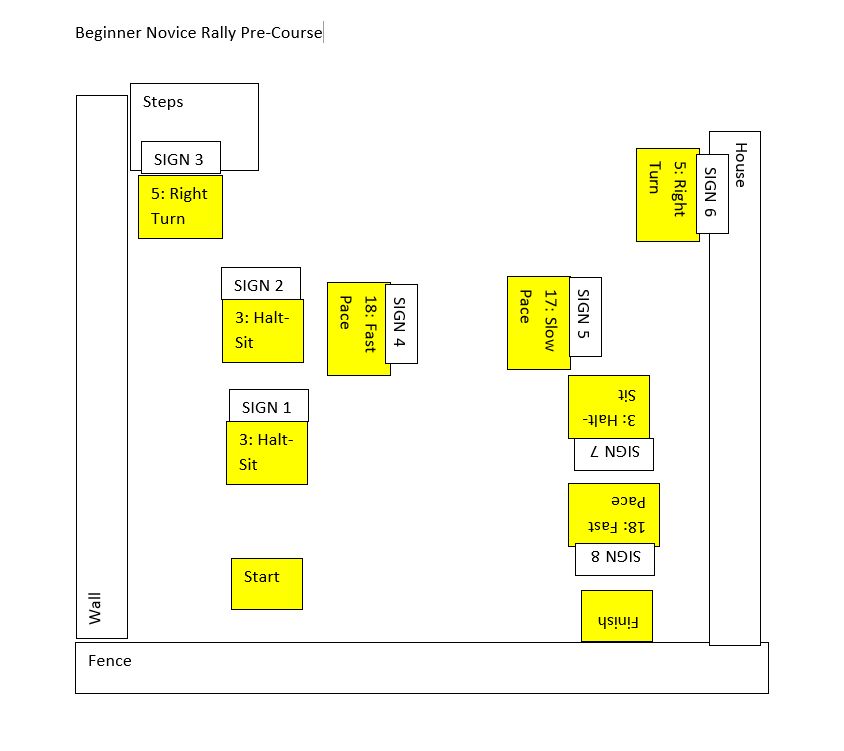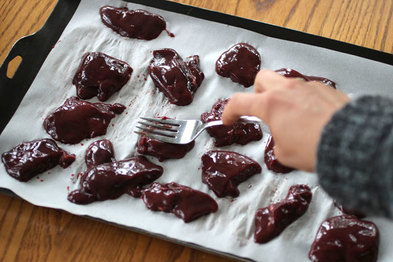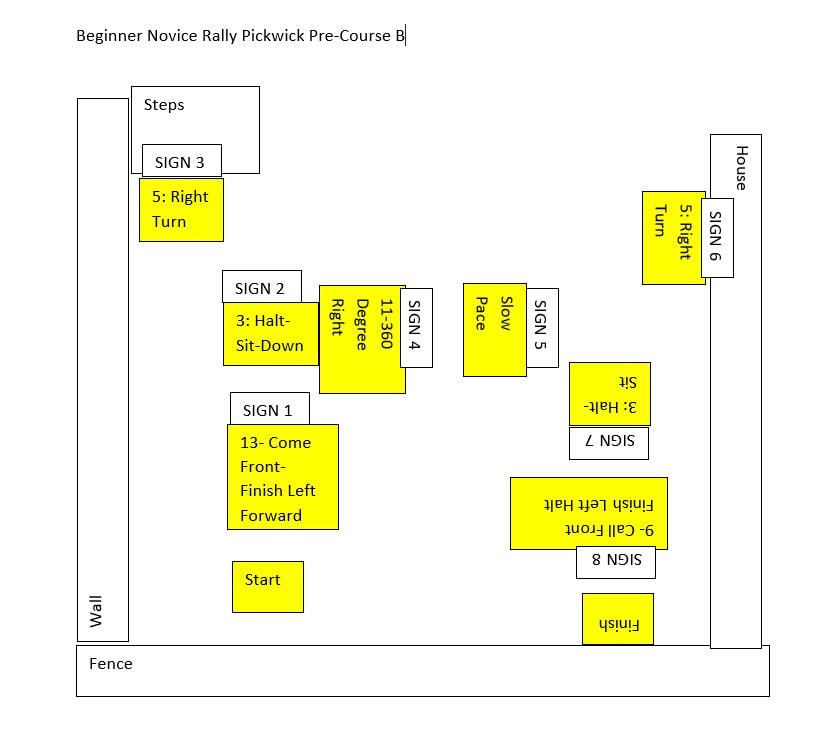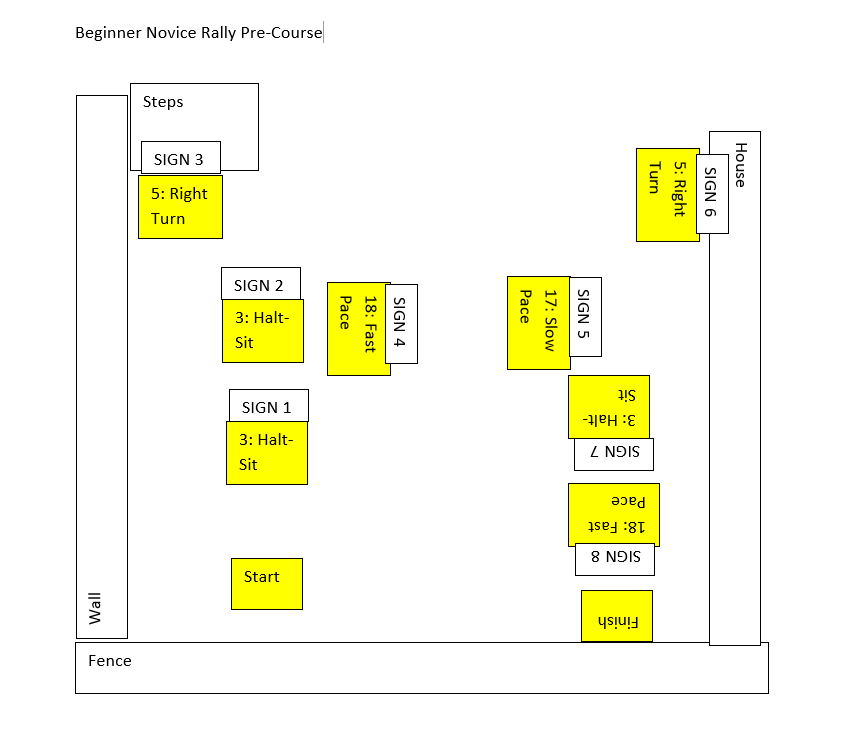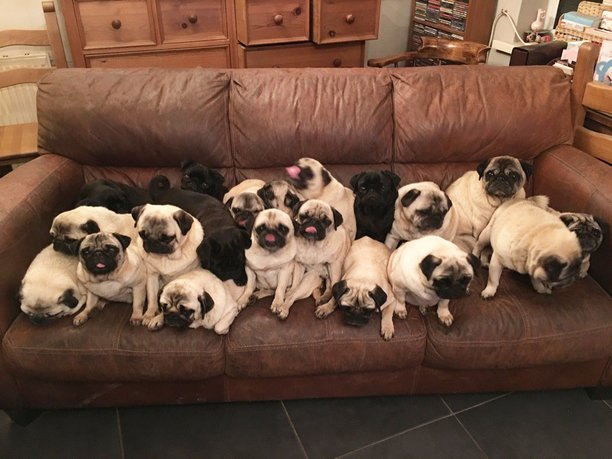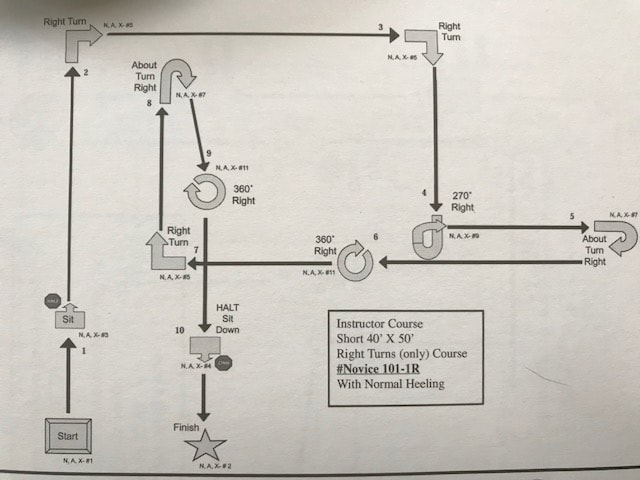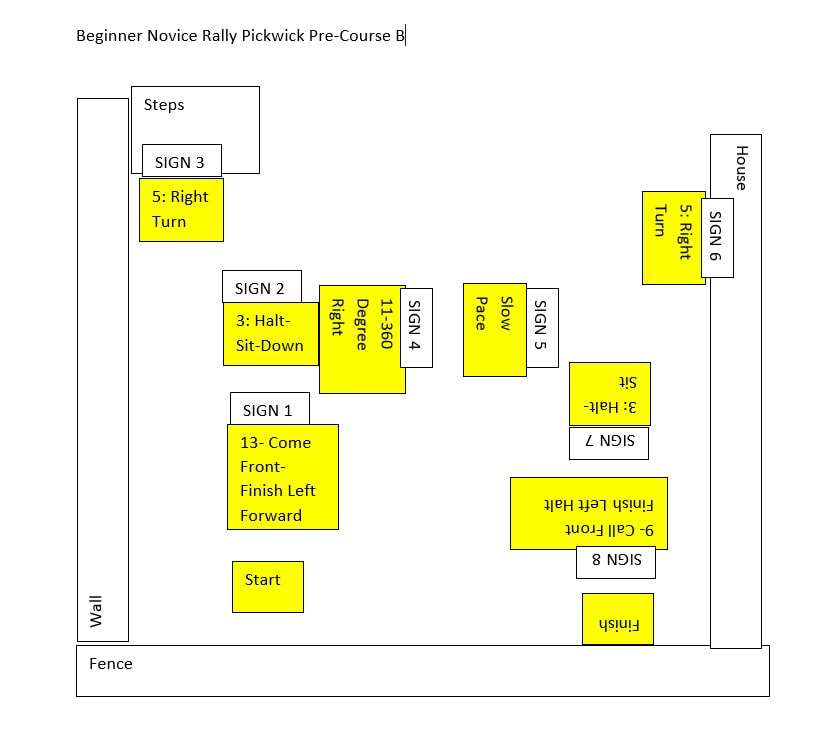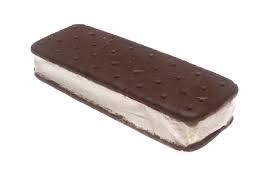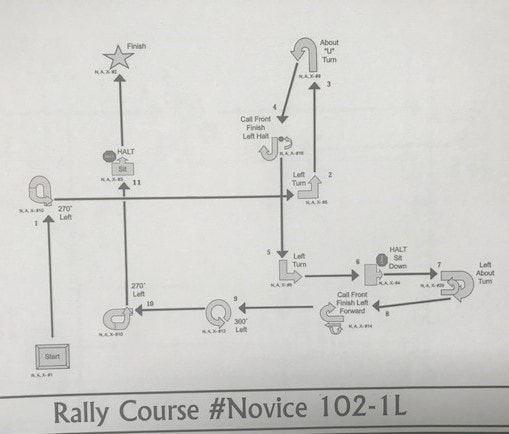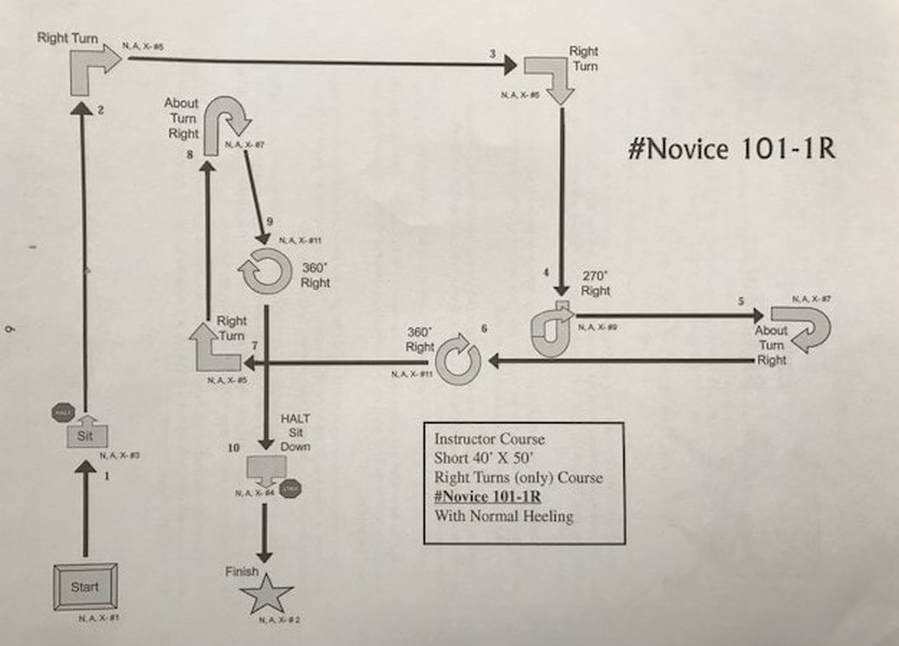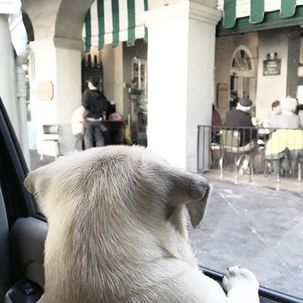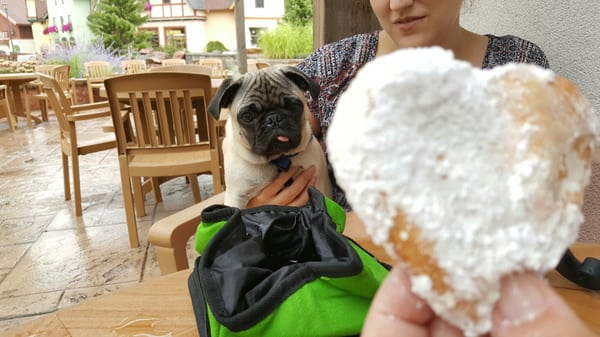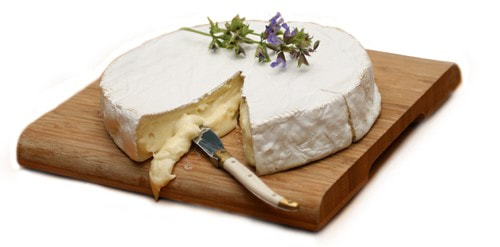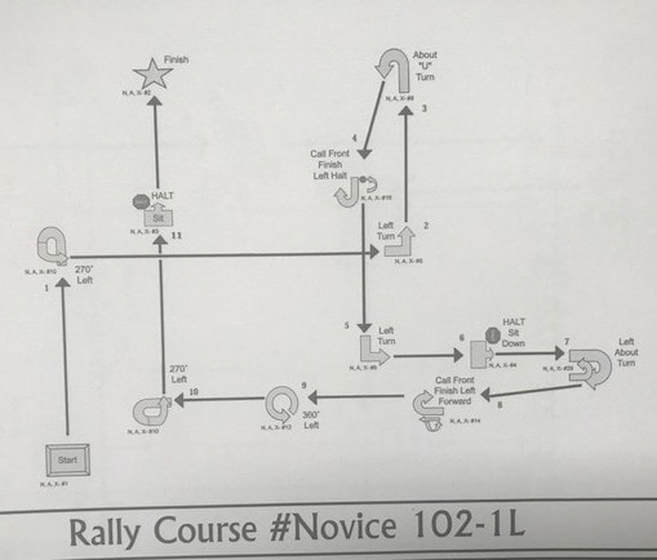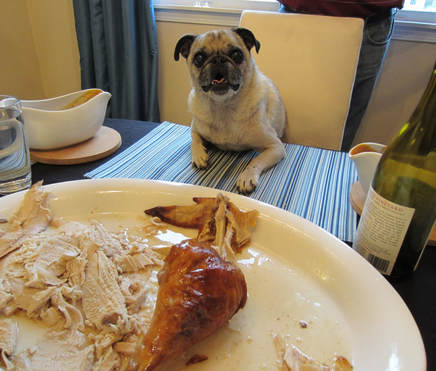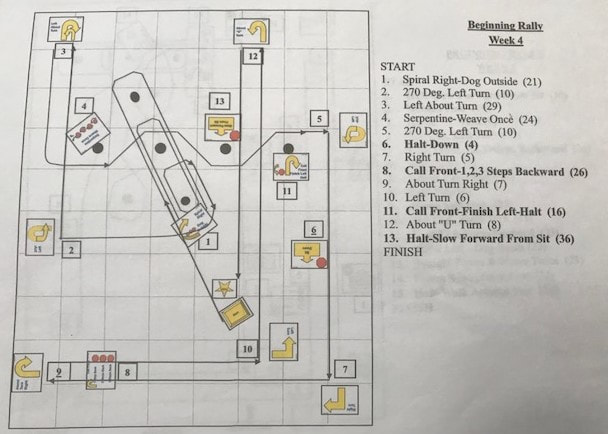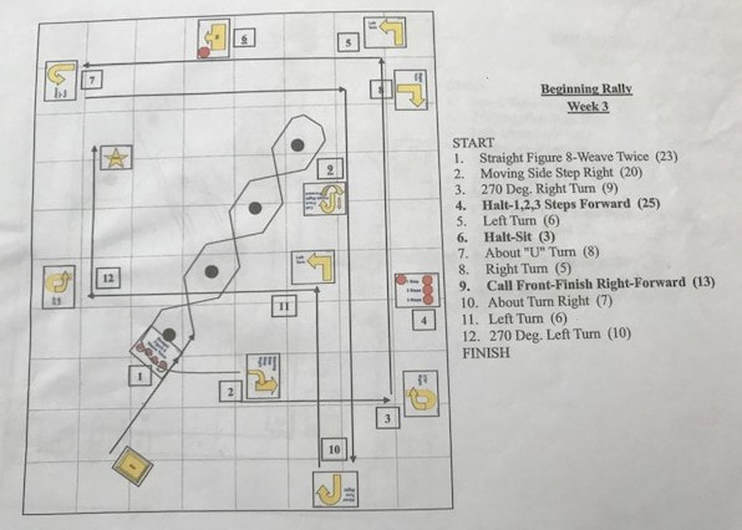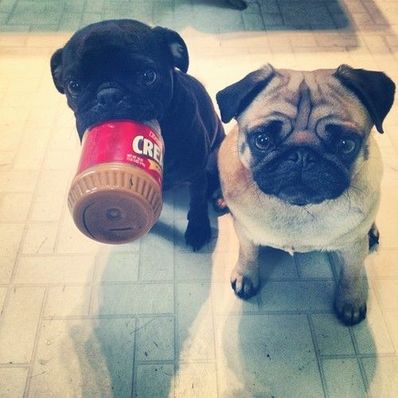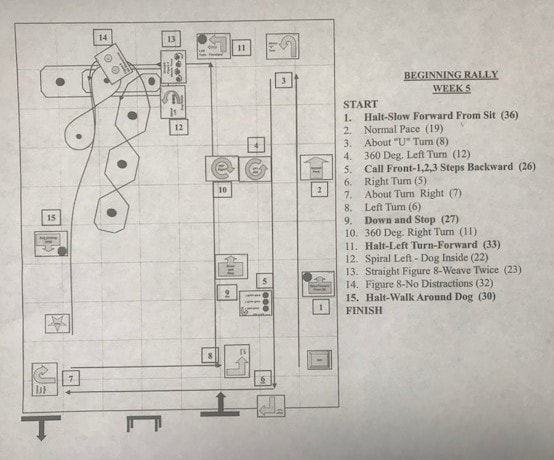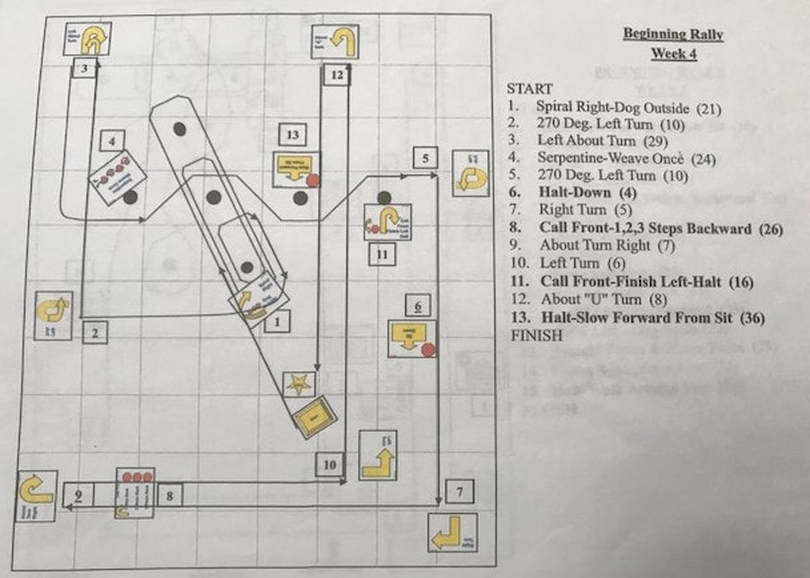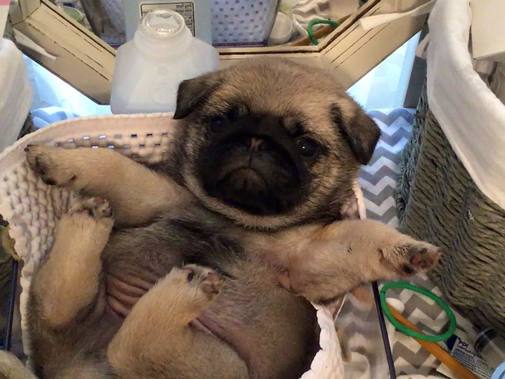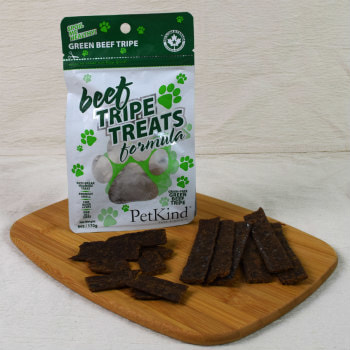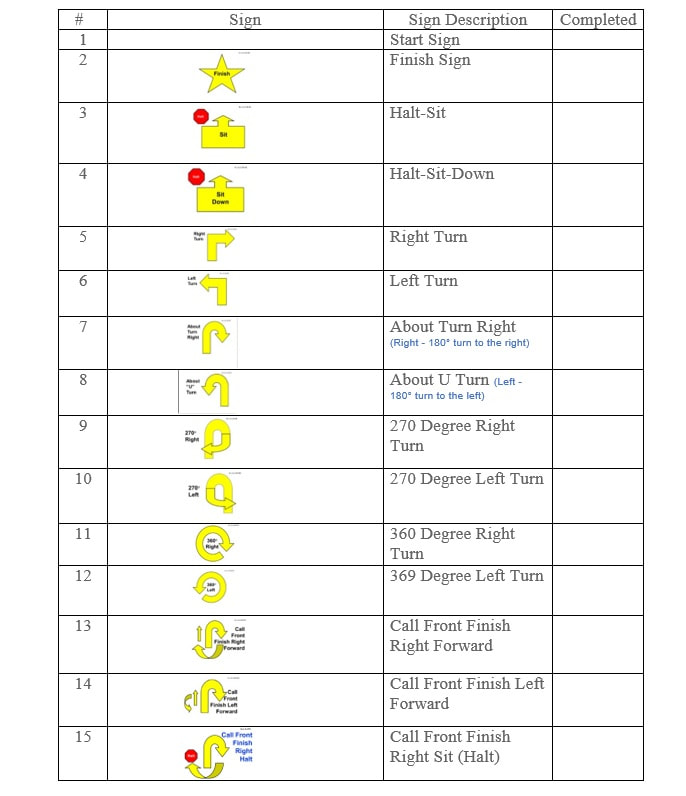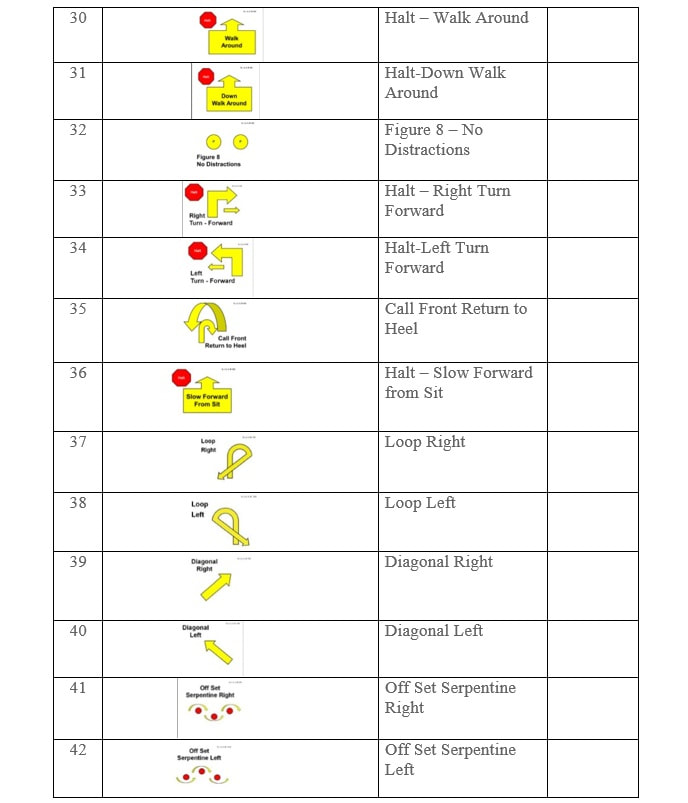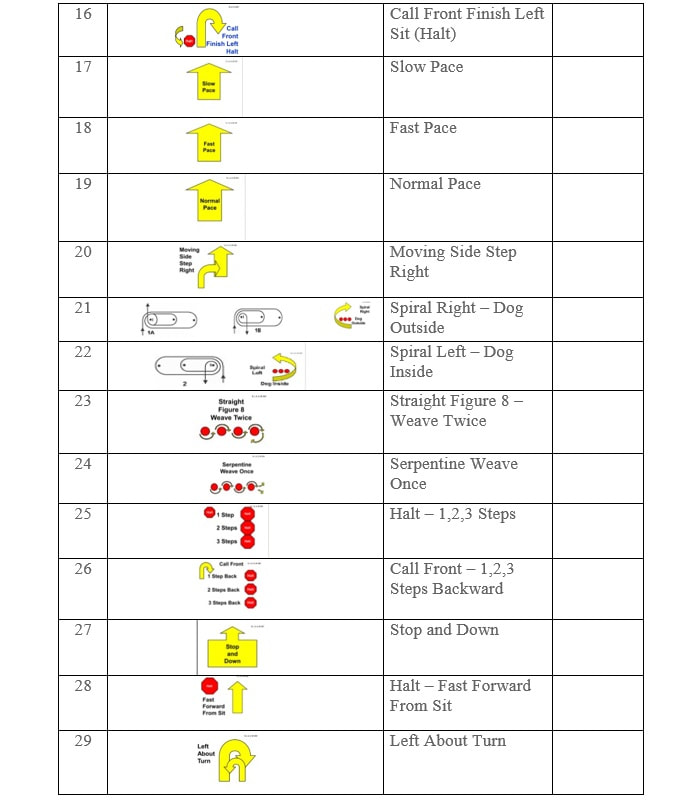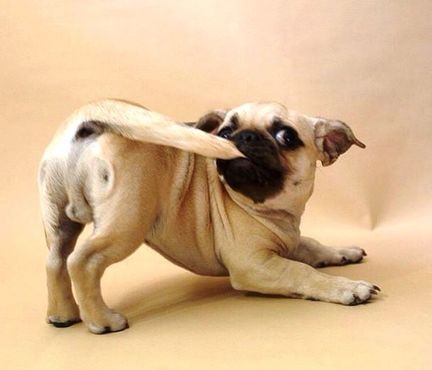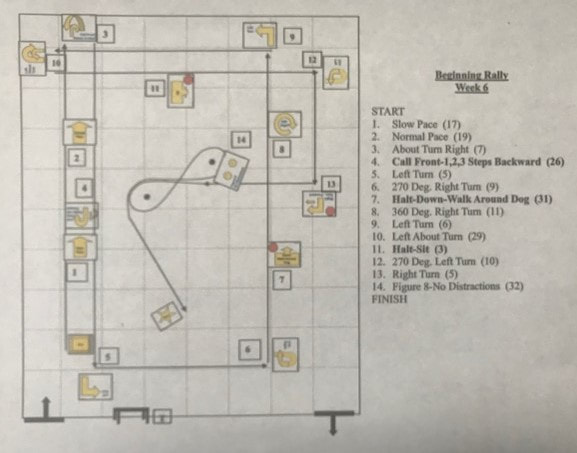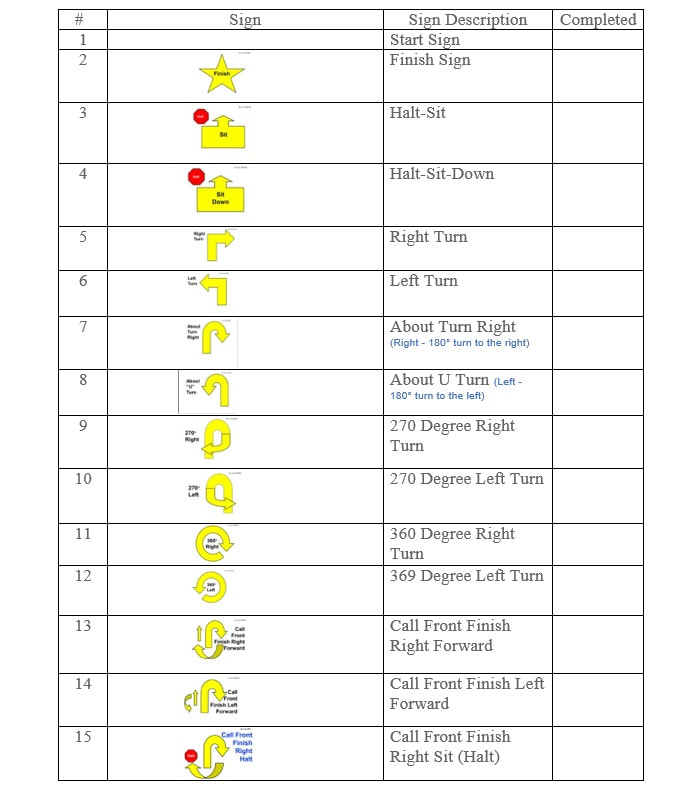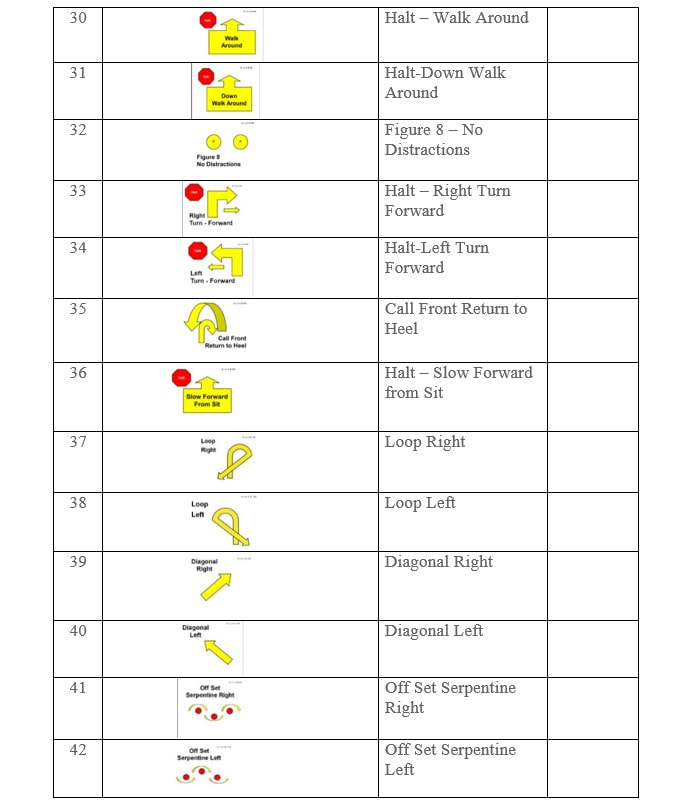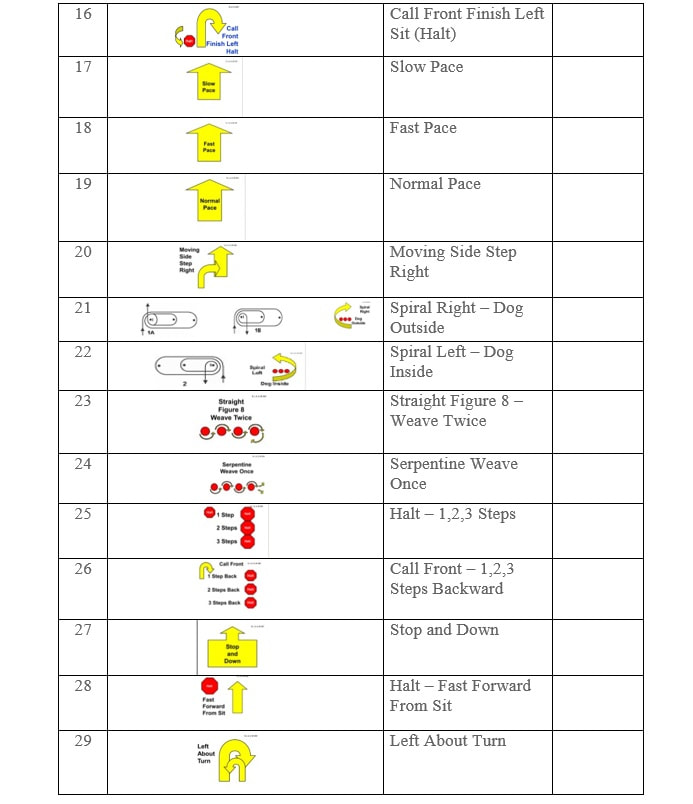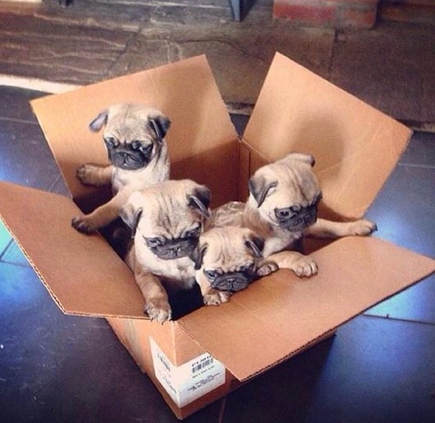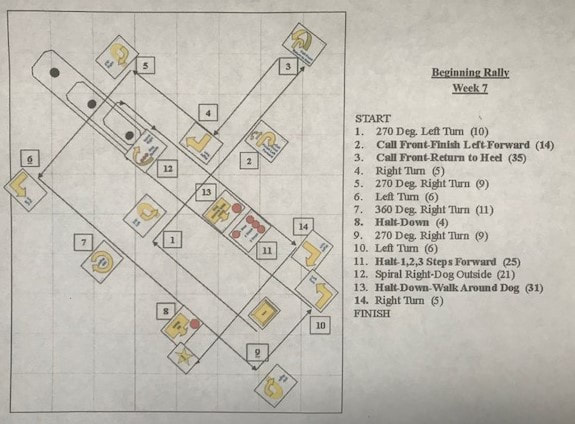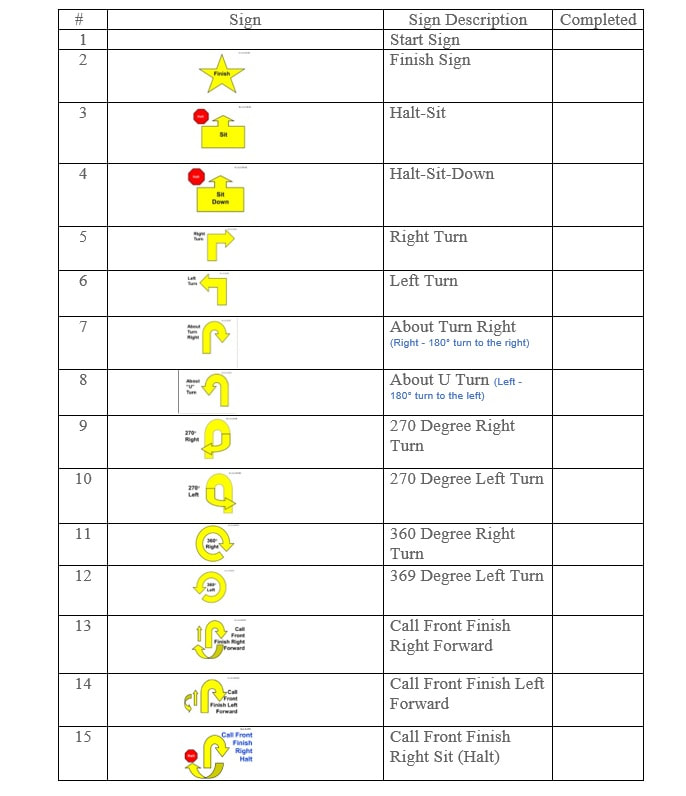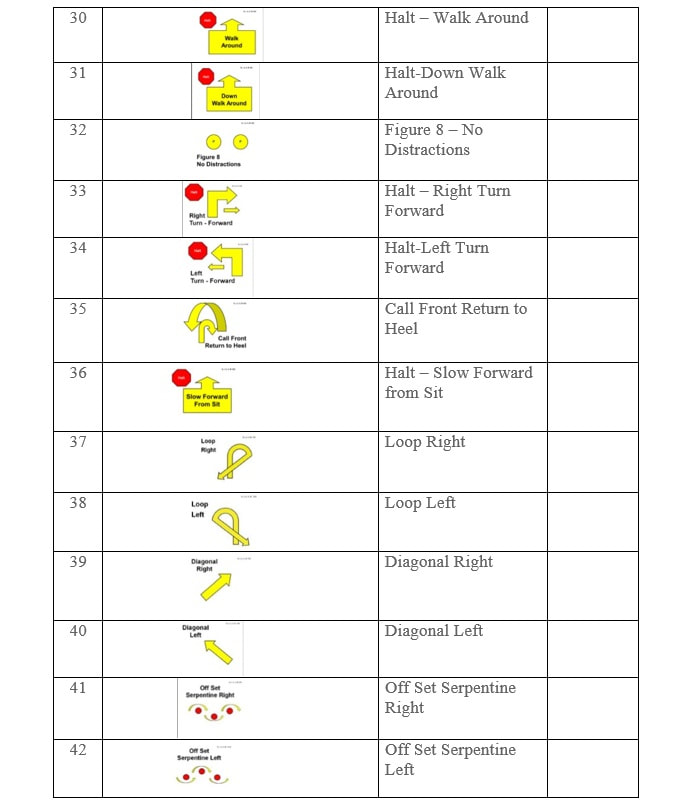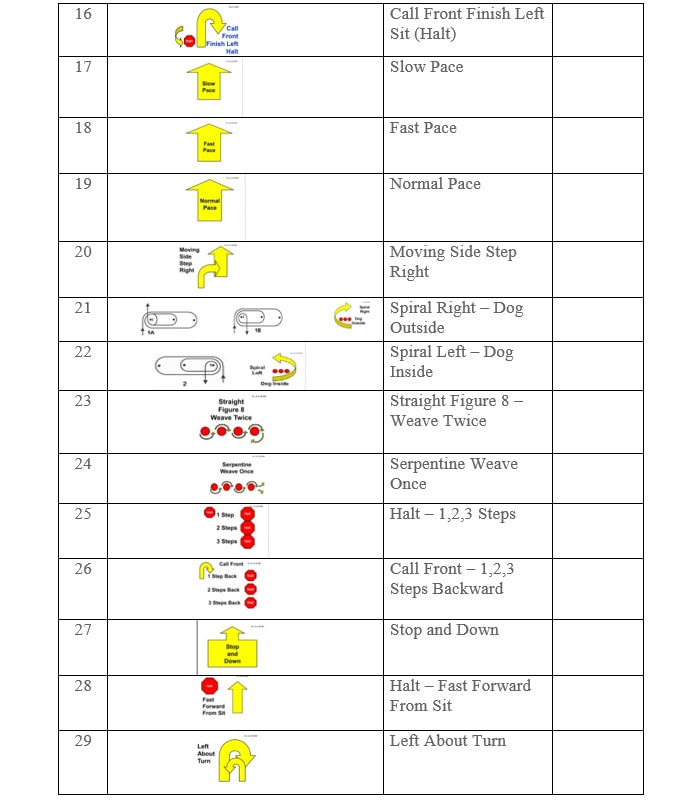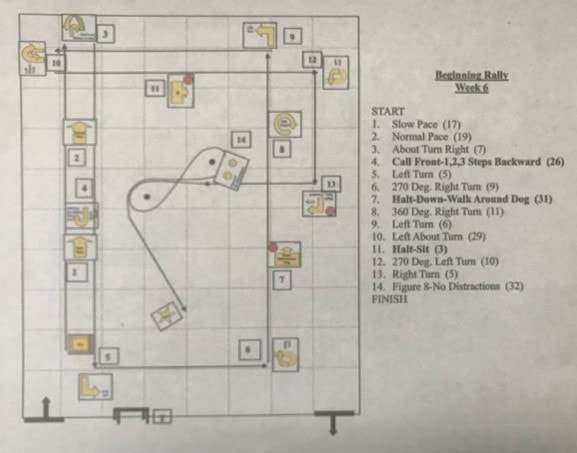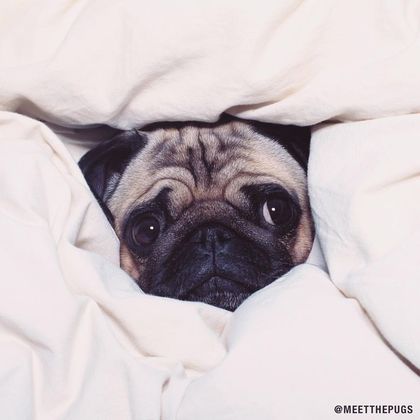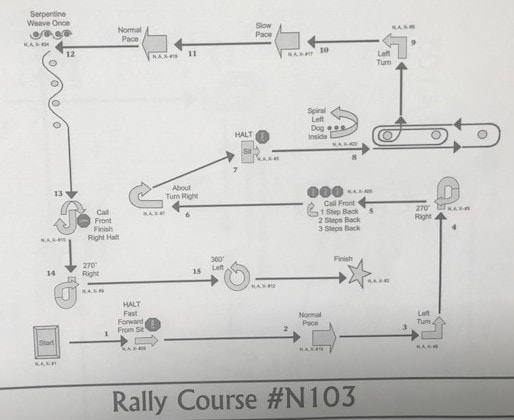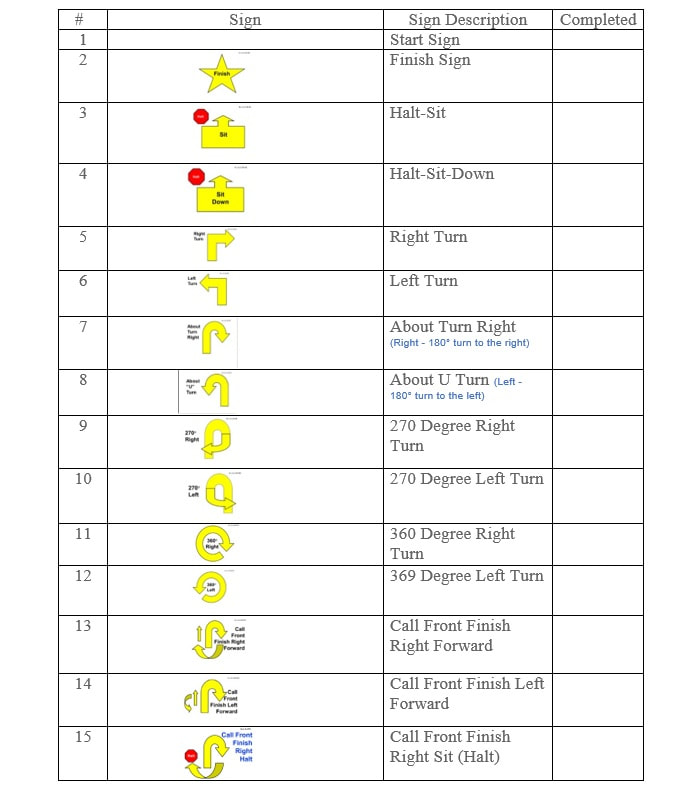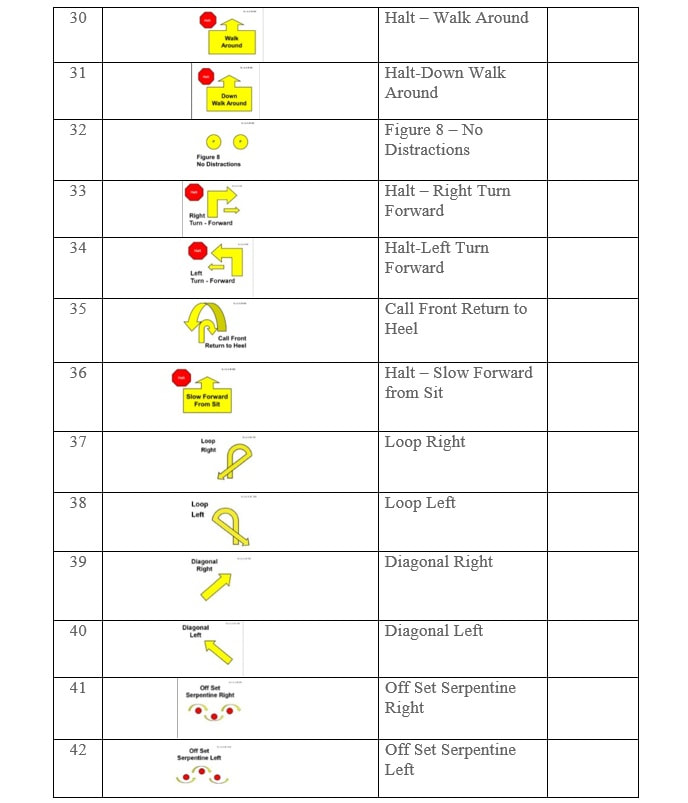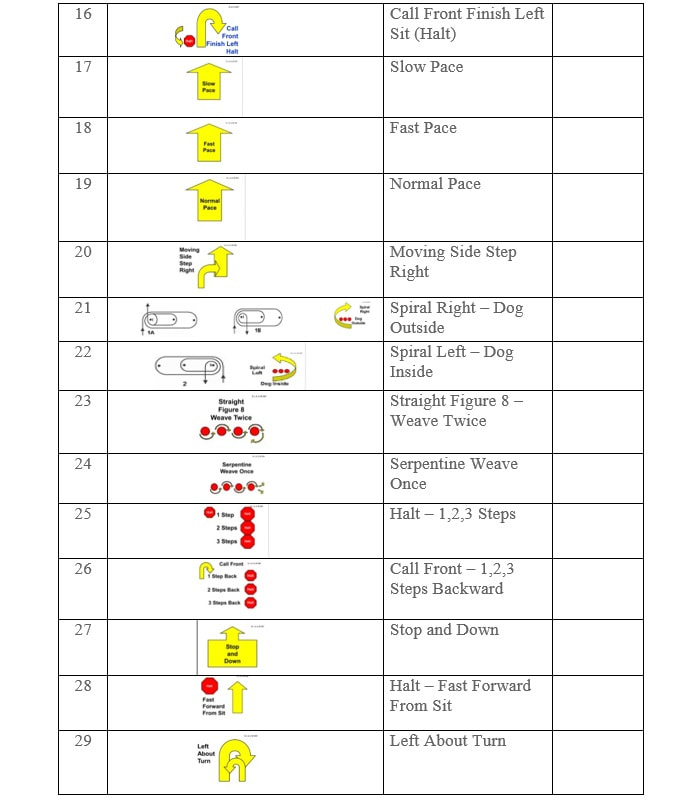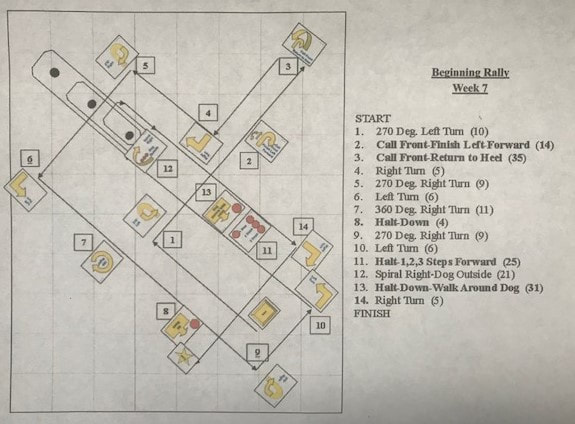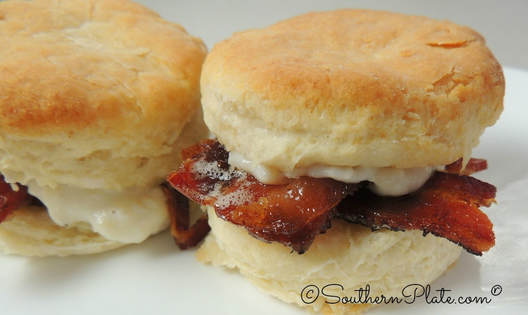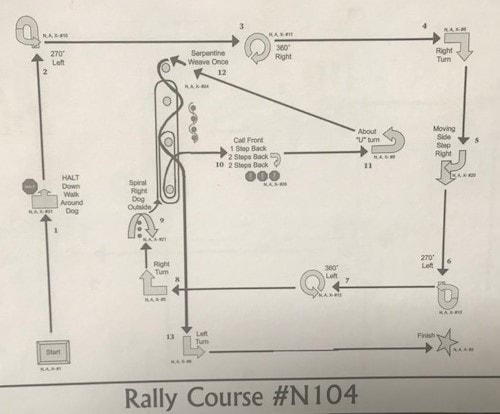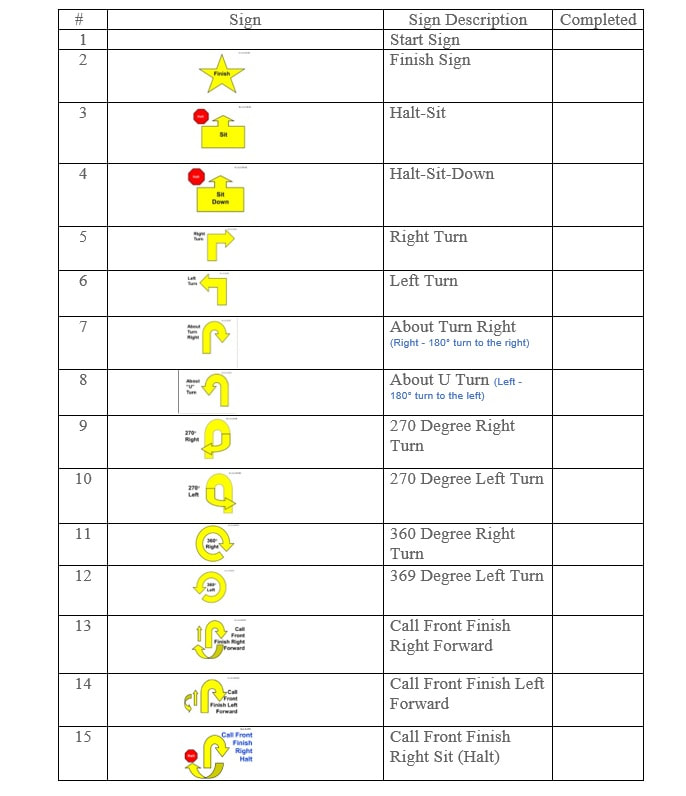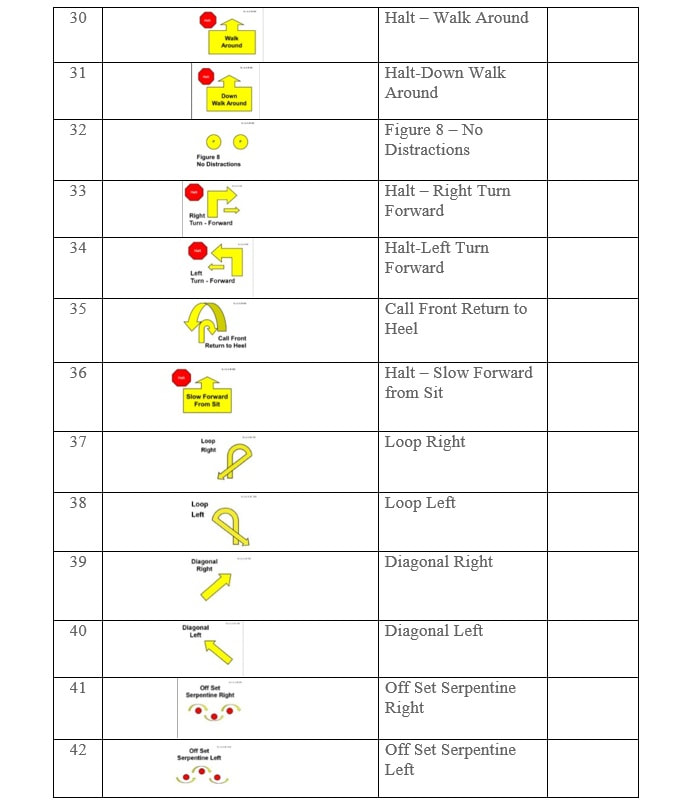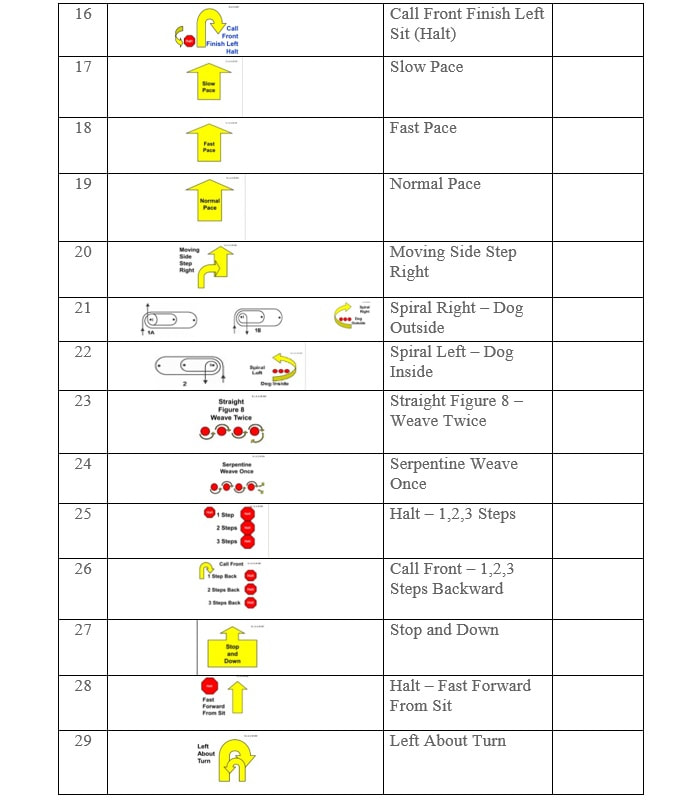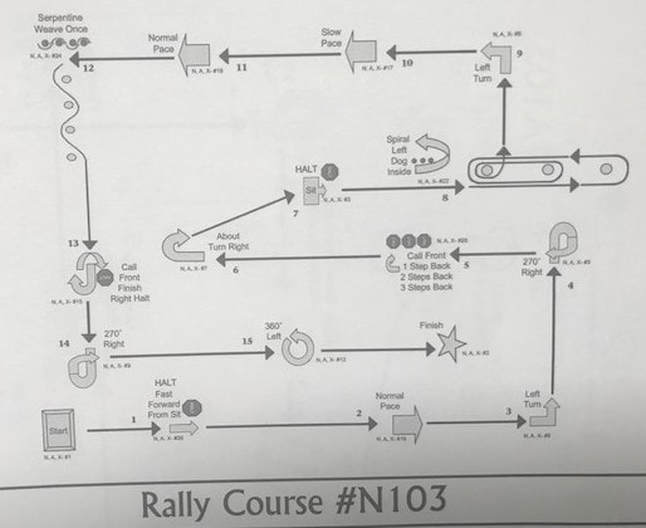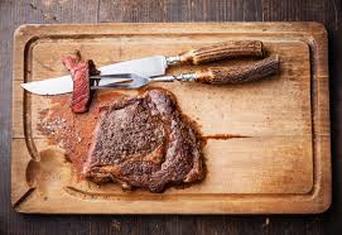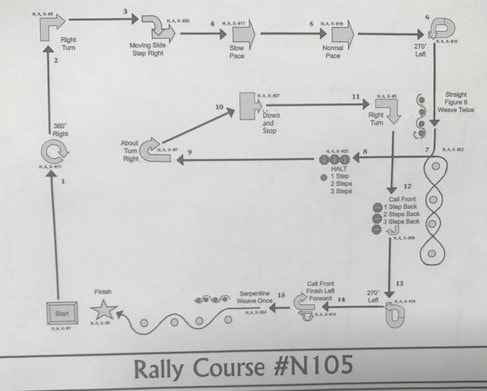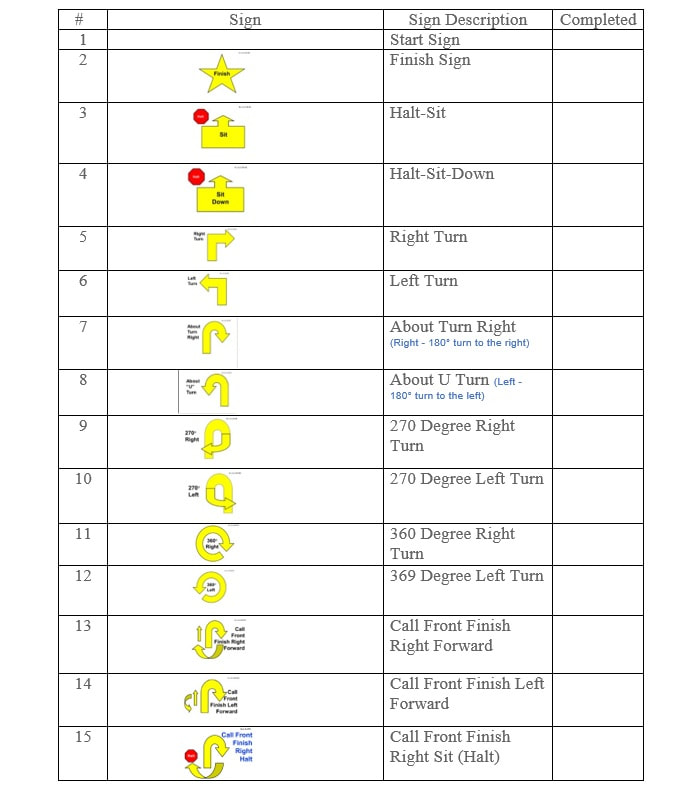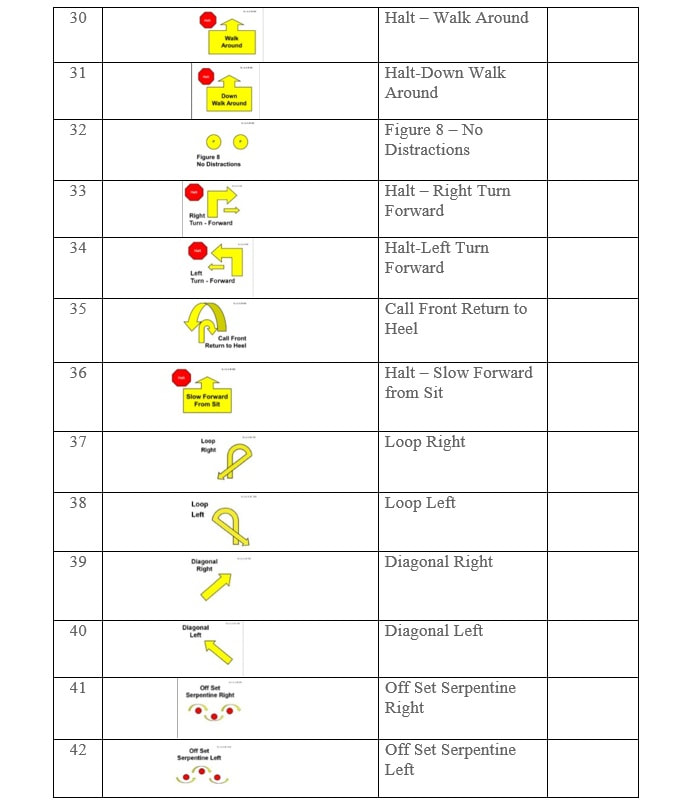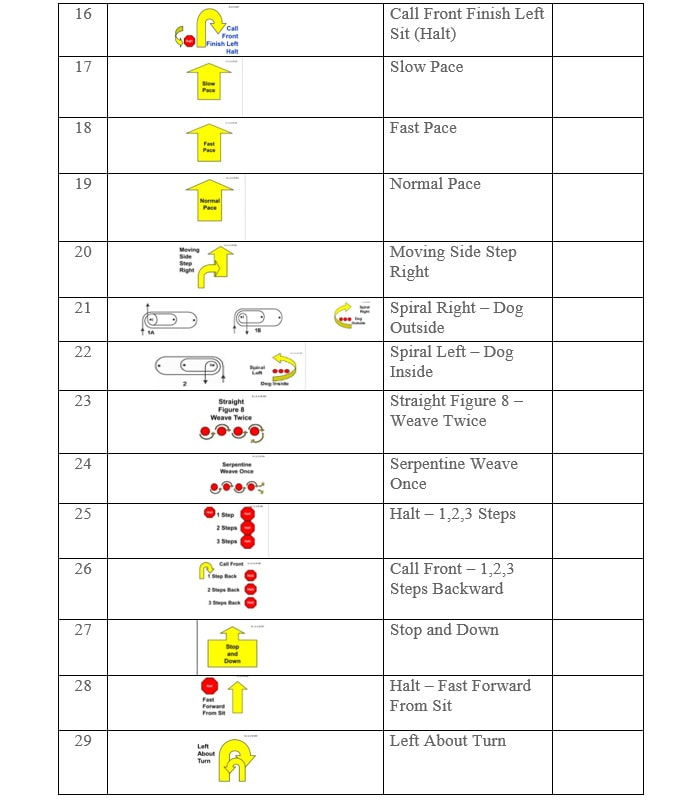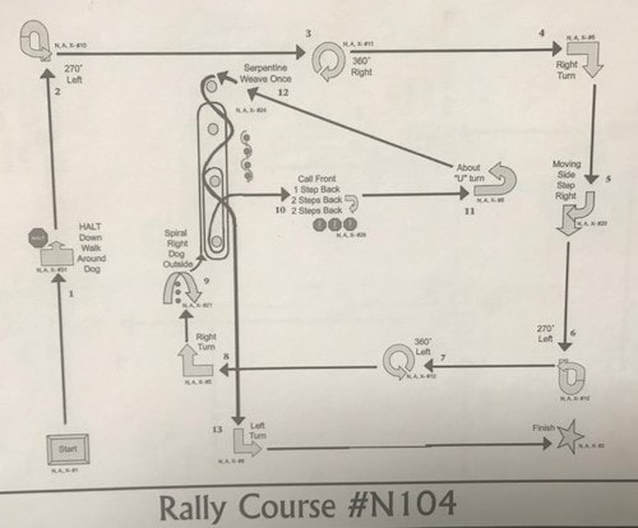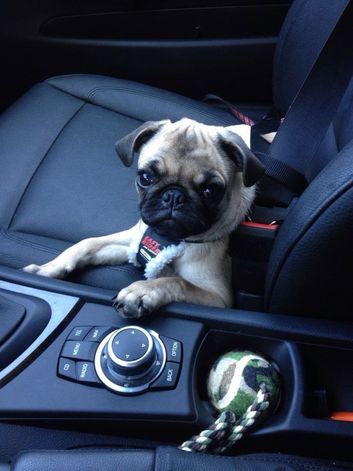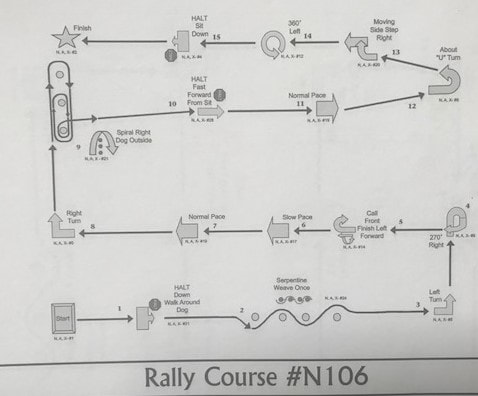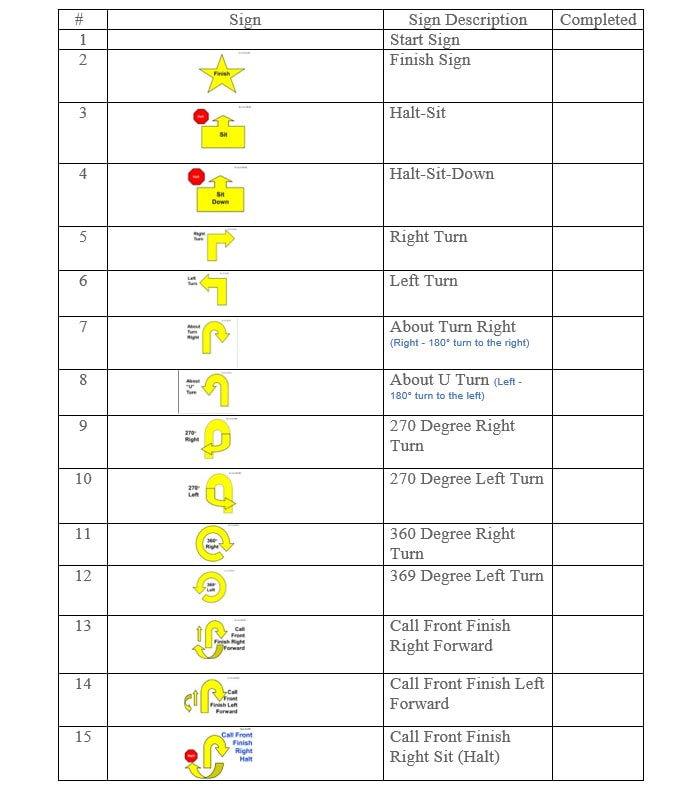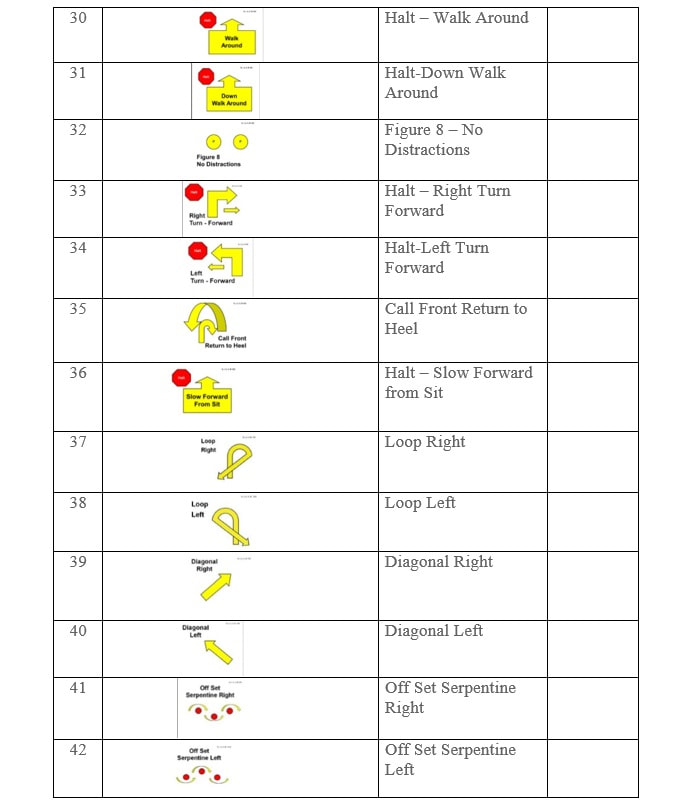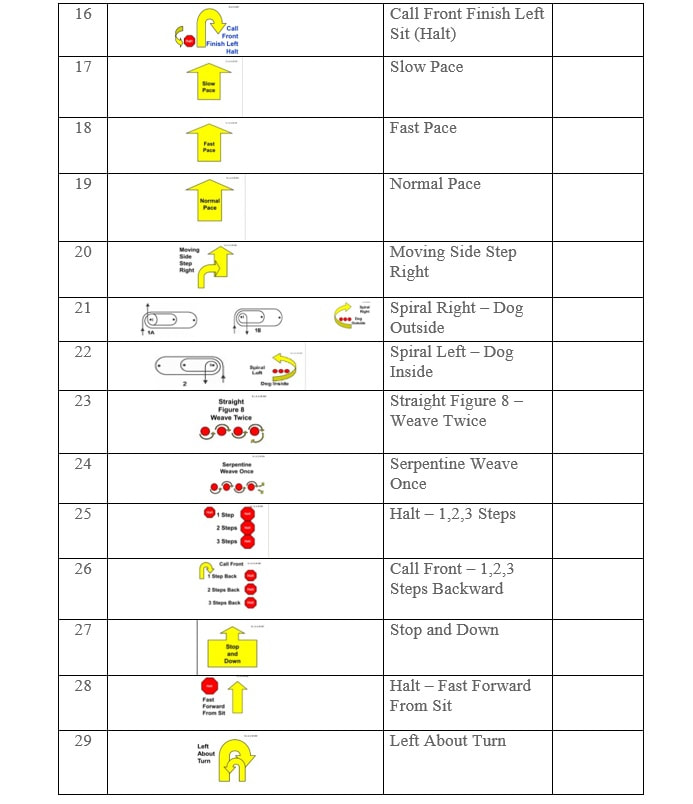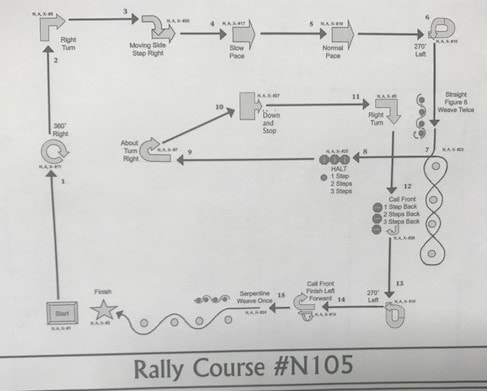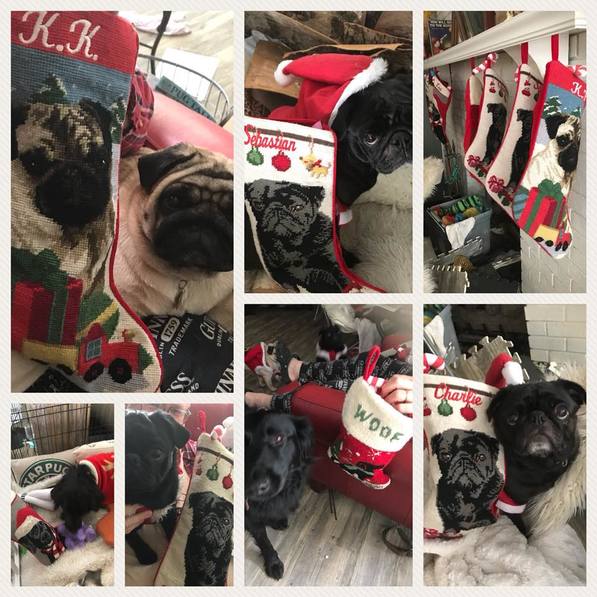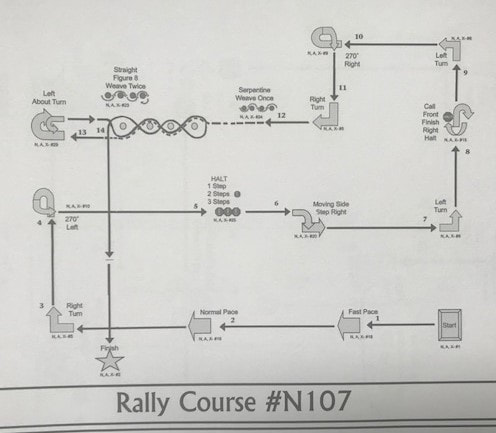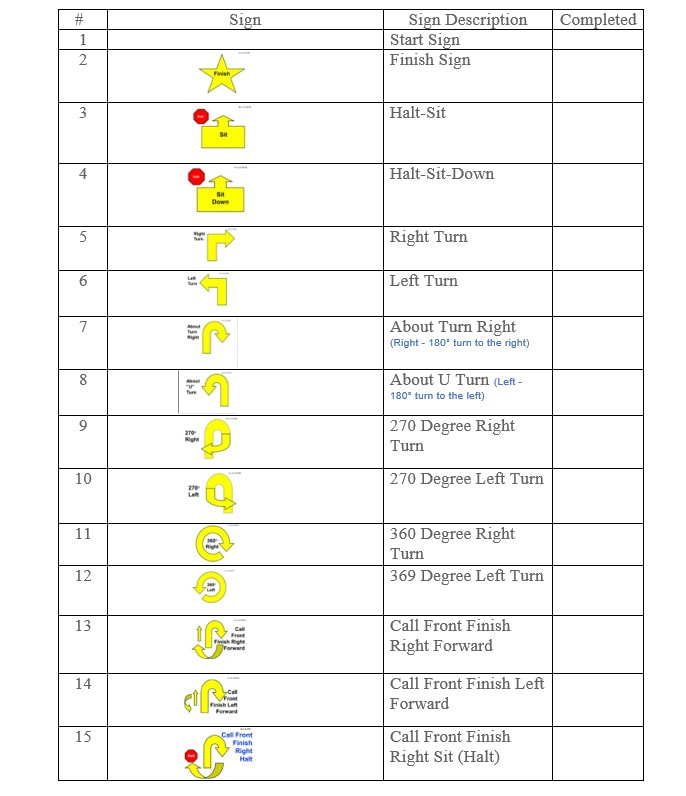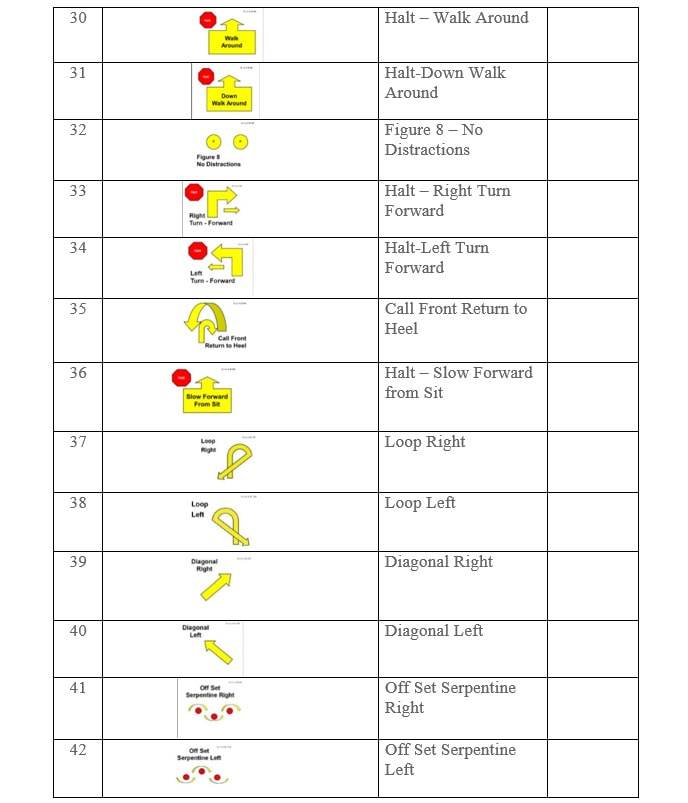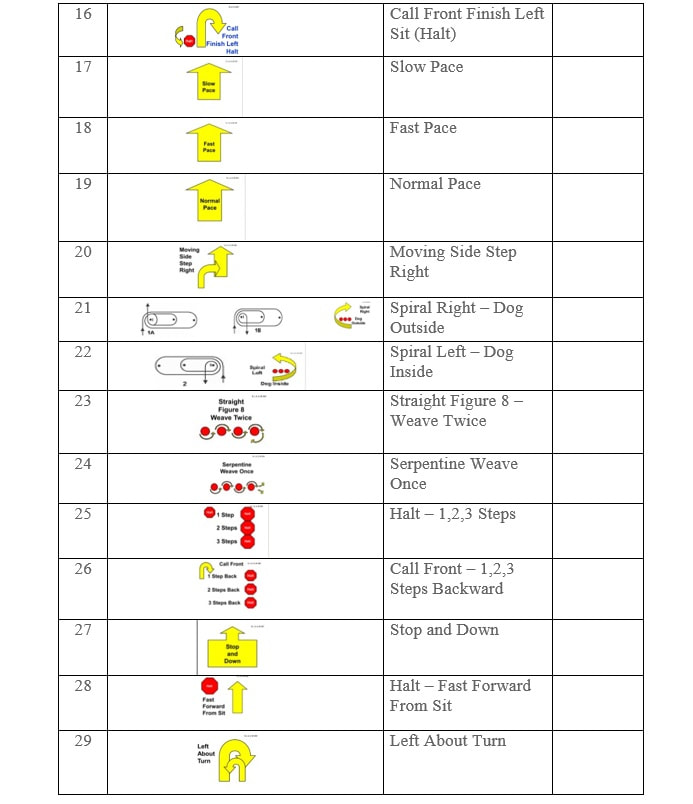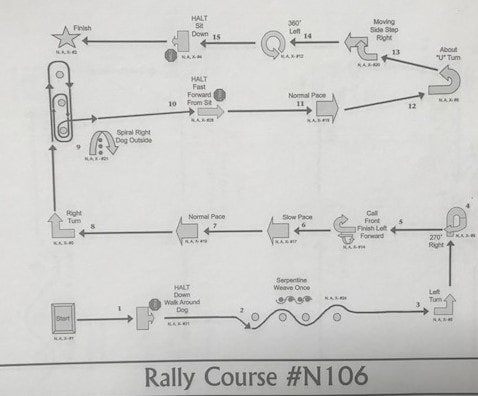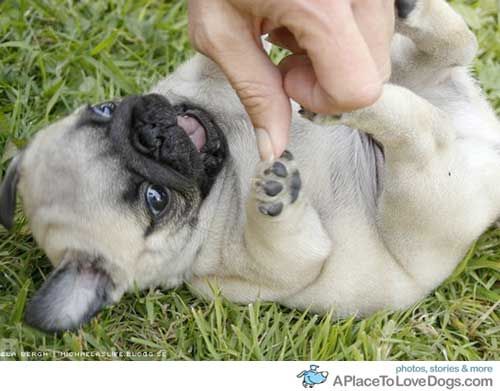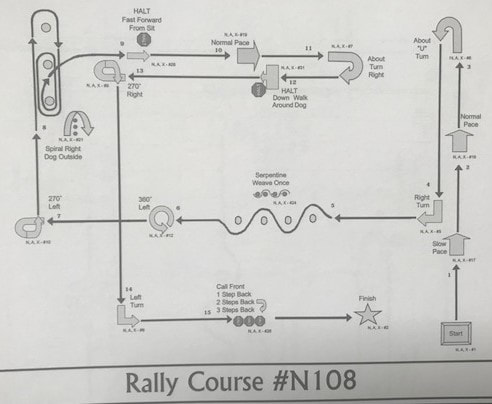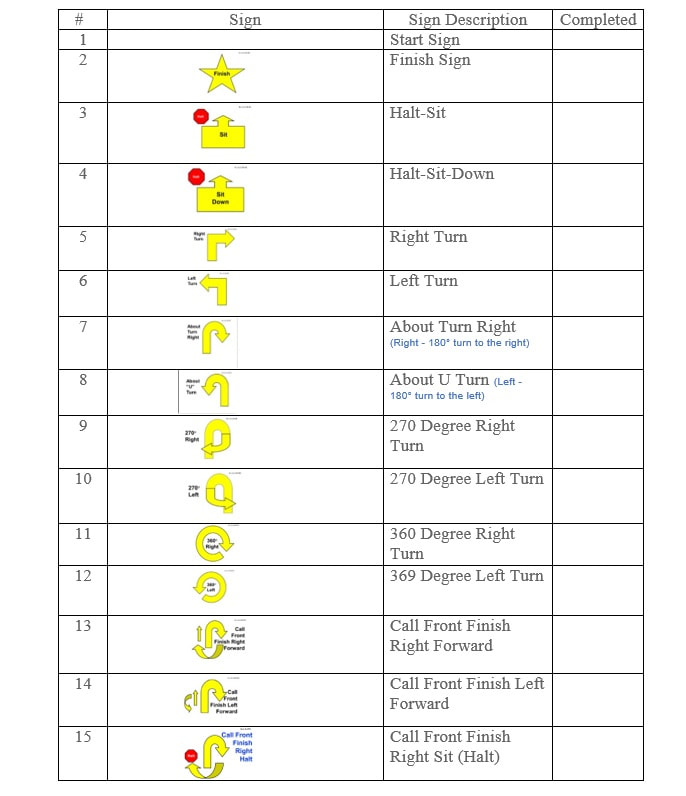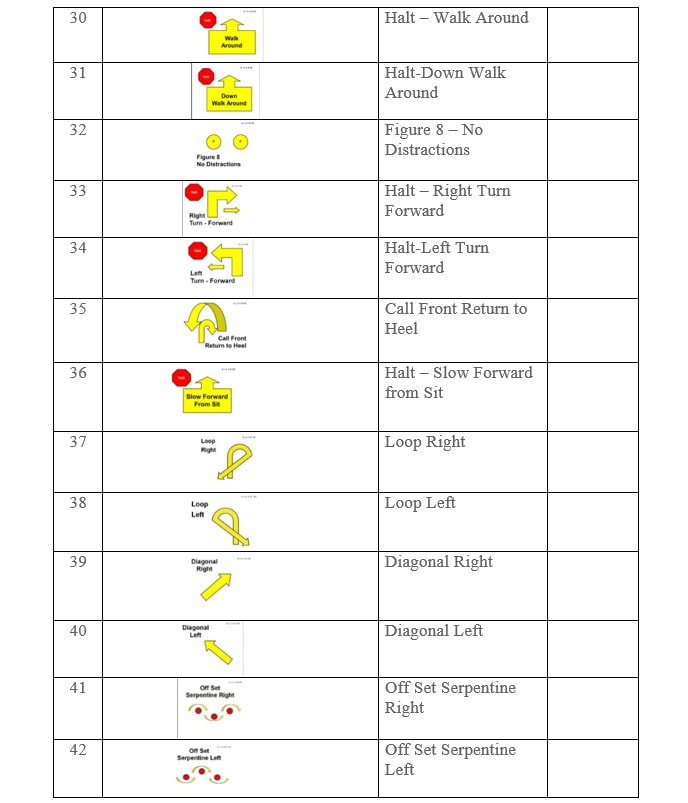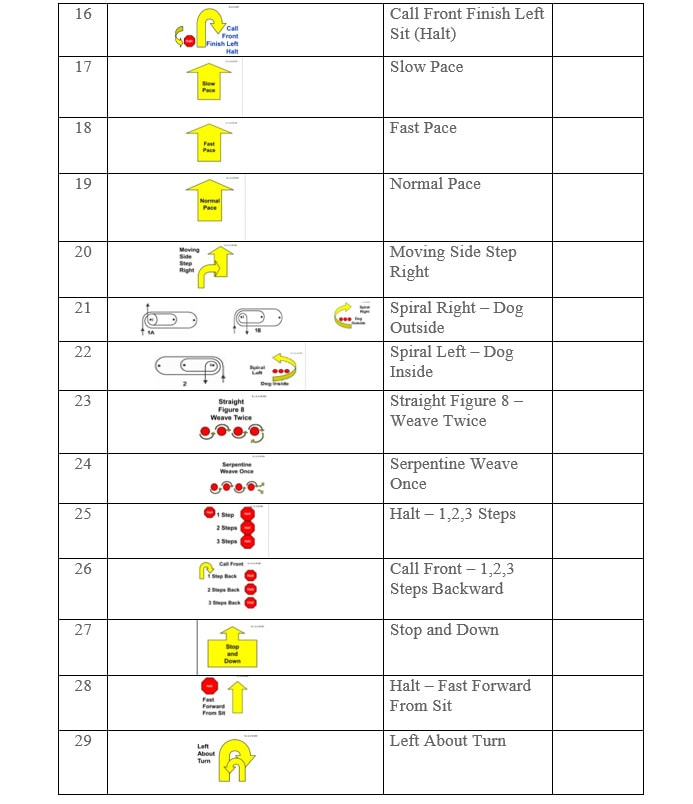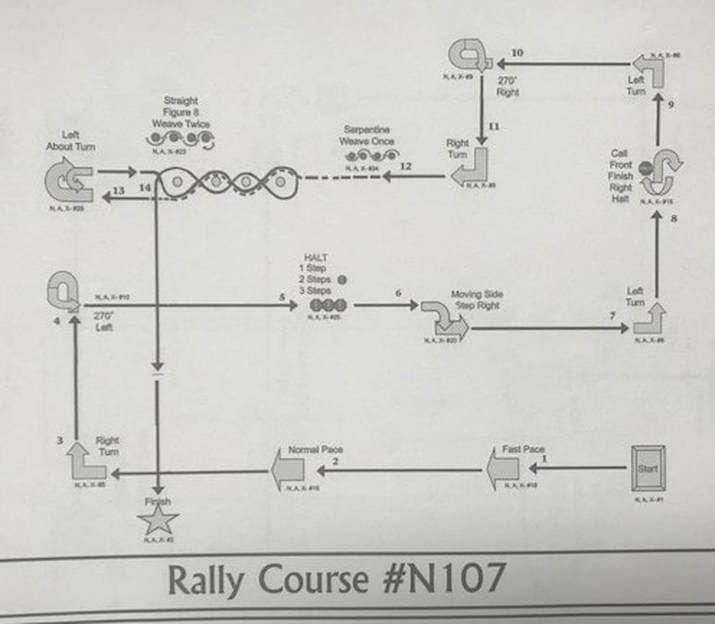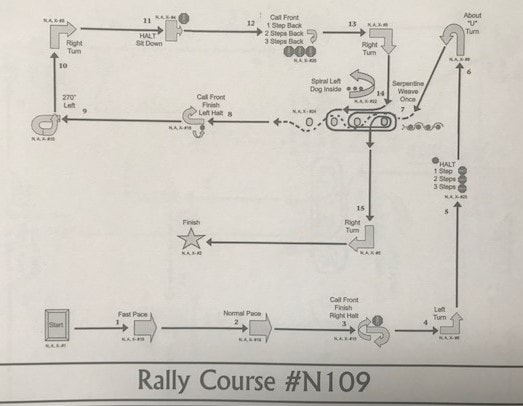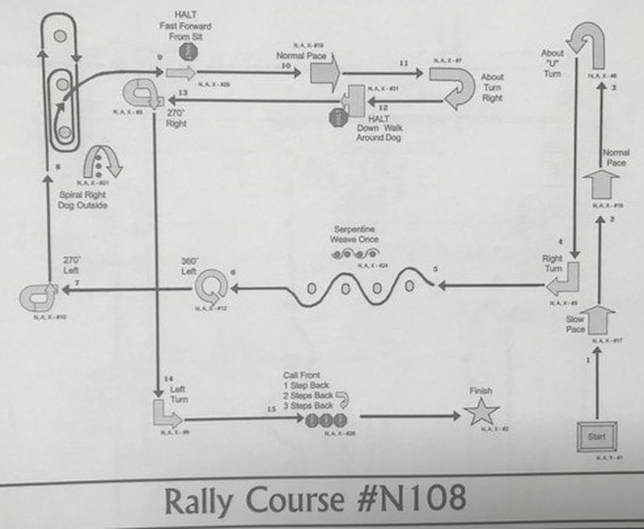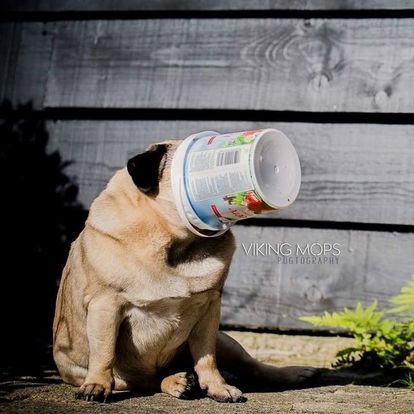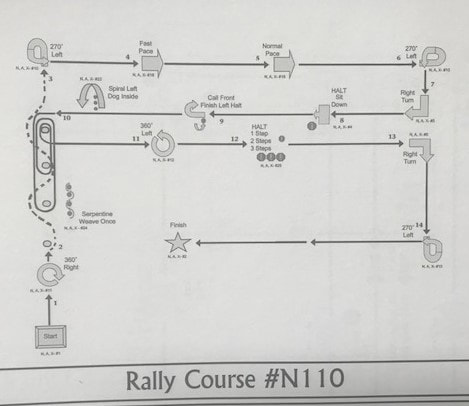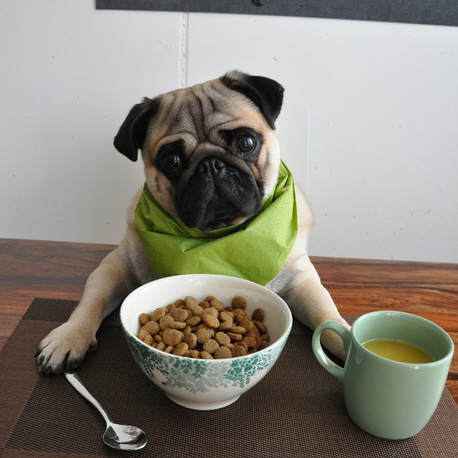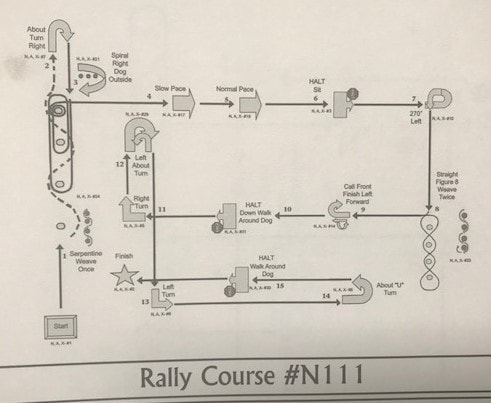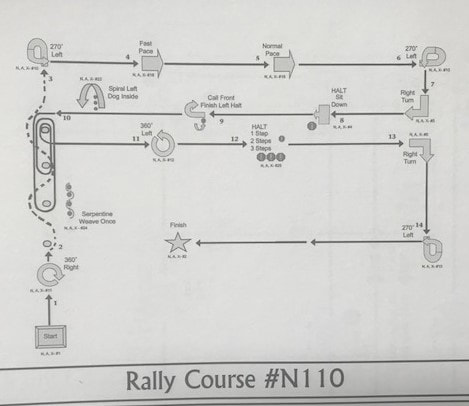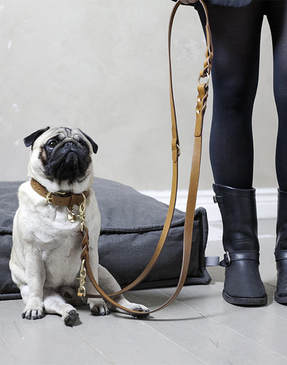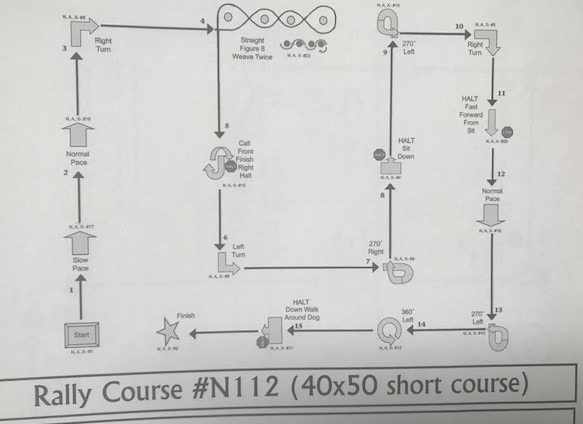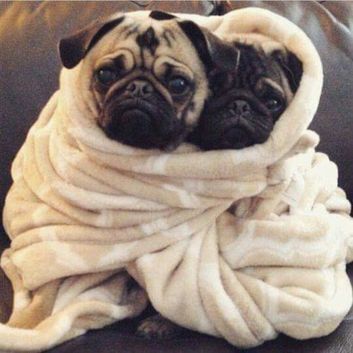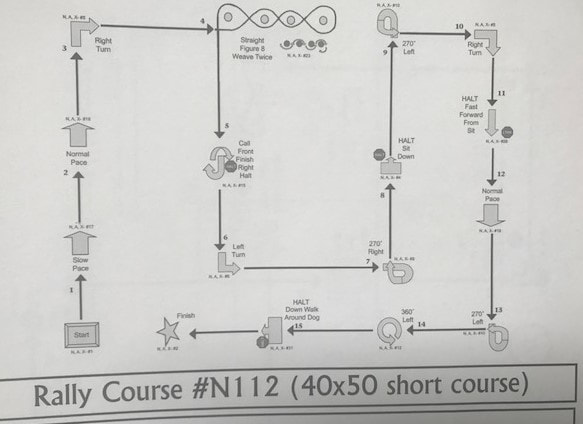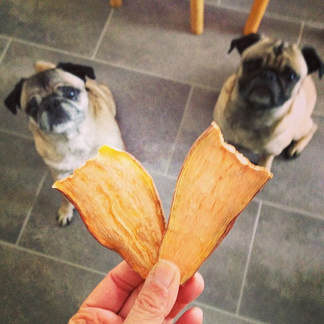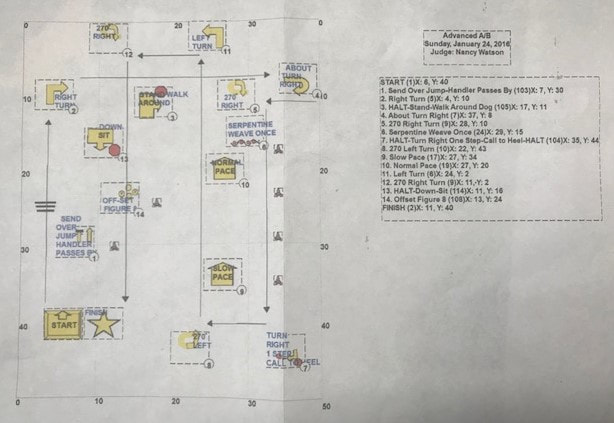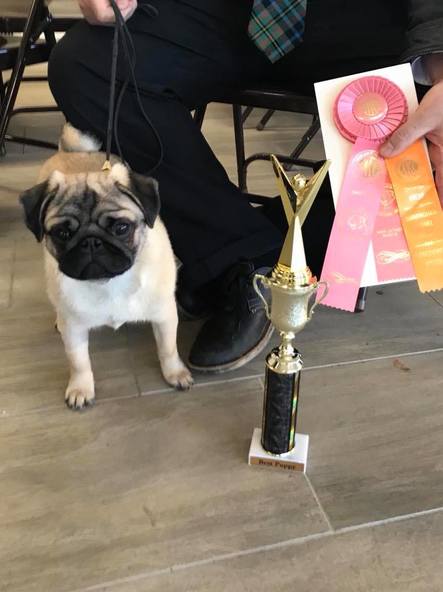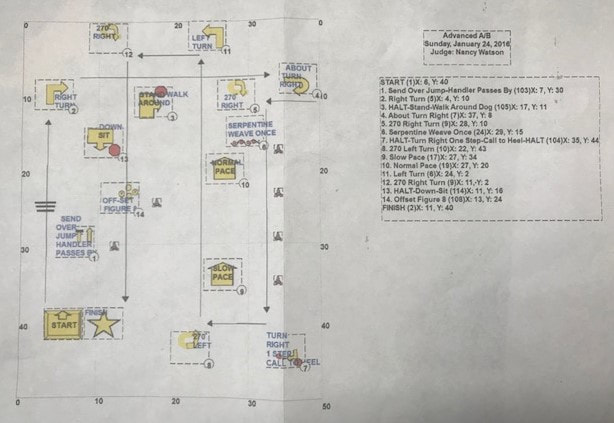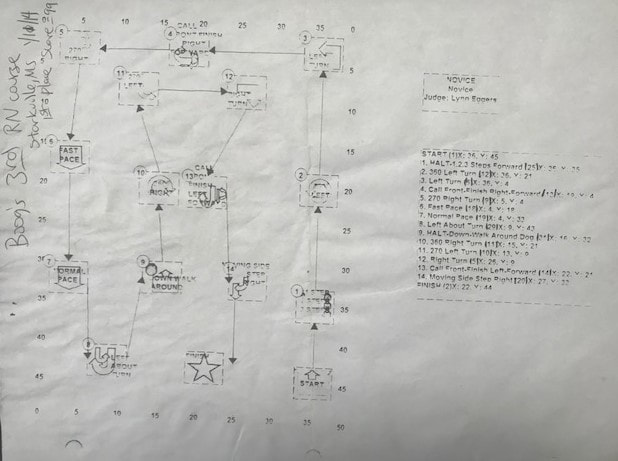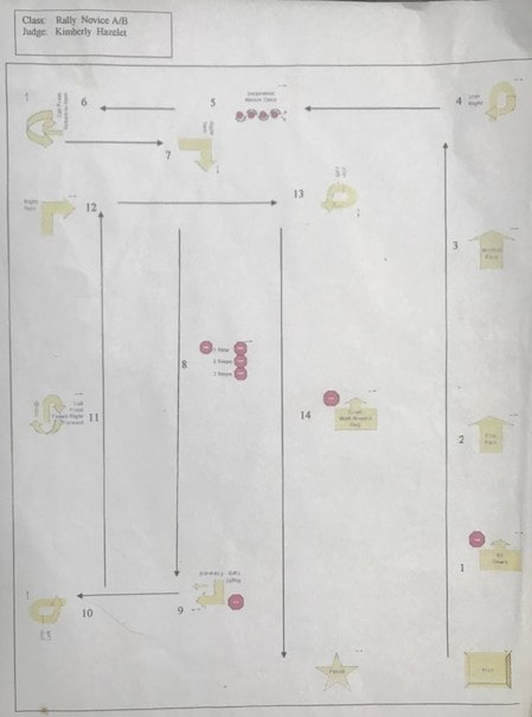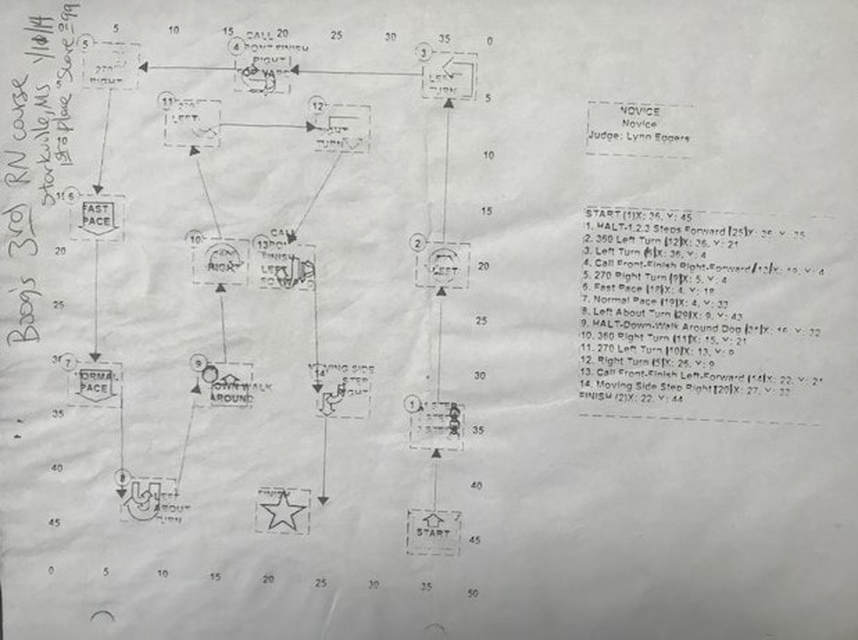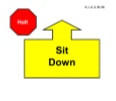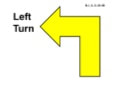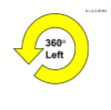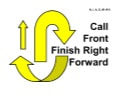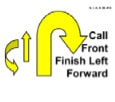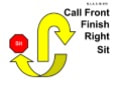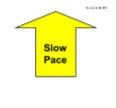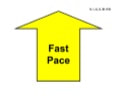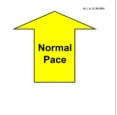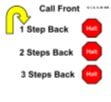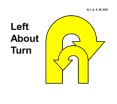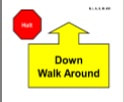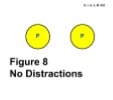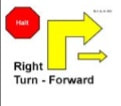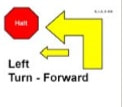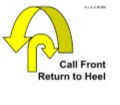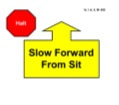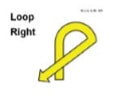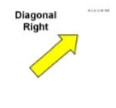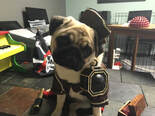
Musings of a bored, attention starved, couch potato pug: "Why do my owners always work so much? Why can't they spend more time with me? Do I really smell that bad? When will 2nd breakfast be served? But wait! Did my owners actually just enter me in a rally trial? What is a rally trial? Is this another word for 2nd breakfast? Did they forget that we only know things like "stop that" or "outside!" or "why can't you be more like your sister?!" Don't they remember that Robert destroyed the last of the clickers?
I guess they realize that the show is 30 days away. I also guess they realize that show entry $ is non-refundable. Oh well, if it means getting a little attention I'm all for anything! Bring it on!! 30 days is really more like 210 days to us dogs, right?"
Musings of an overworked owner of a grumble of pugs. "If only I could ever find a collar. Didn't I just buy like 20 clickers? Where do they all disappear to? OK, I've got to dig that pug out of the sofa. Call in for backup. Let's set some goals. We need to prevent another ring wise pug like Sir Sebastian and his sit strike in Atlanta. We need more diversity in rewarding. Also, don't forget to tryout that new trick of putting treats in an envelope attached to your Left Arm ... like it's your Trial #. Avoid the broken vending machine syndrome. Fade lures faster. Don't train when tired. (um). Did I seriously just enter a pug who knows nothing in a trial in 30 days? What was I thinking?"
I guess they realize that the show is 30 days away. I also guess they realize that show entry $ is non-refundable. Oh well, if it means getting a little attention I'm all for anything! Bring it on!! 30 days is really more like 210 days to us dogs, right?"
Musings of an overworked owner of a grumble of pugs. "If only I could ever find a collar. Didn't I just buy like 20 clickers? Where do they all disappear to? OK, I've got to dig that pug out of the sofa. Call in for backup. Let's set some goals. We need to prevent another ring wise pug like Sir Sebastian and his sit strike in Atlanta. We need more diversity in rewarding. Also, don't forget to tryout that new trick of putting treats in an envelope attached to your Left Arm ... like it's your Trial #. Avoid the broken vending machine syndrome. Fade lures faster. Don't train when tired. (um). Did I seriously just enter a pug who knows nothing in a trial in 30 days? What was I thinking?"
9 Week Boot Camp - 14+ Sessions (minimum 2 per week):
Preliminary Training Session
Training Session 1
Training Session 2
Training Session 3
Training Session 4
Training Session 5
Training Session 6
Training Session 7
Training Session 8
Training Session 9
Training Session 10
Training Session 11
Training Session 12
Training Session 13
Training Session 14
Training Session 1
Training Session 2
Training Session 3
Training Session 4
Training Session 5
Training Session 6
Training Session 7
Training Session 8
Training Session 9
Training Session 10
Training Session 11
Training Session 12
Training Session 13
Training Session 14
Here are the training videos we used for the most recent round of Rally Novice pugs. We also used these for review of our RI title holders as they refreshened skills getting ready for Rally Advanced.
In this case, 14 sessions, 2 per week, but ideally there would be more sessions involving proofing, adding distractions/duration and prevention of future "ring wise pugs" ;) We tried to keep each session around 15 minutes in length, but we often did reinforcement throughout the day of certain skills needing more work (when time allowed).
Some goals to keep in mind:
HAVE FUN while mastering Rally Novice moves. Always make it a game.
Improve precision in each session - increase criterion gradually yet steadily
Be precise with hand signals, verbal cues
Don't block the clicker
Fade the food lures quickly
Be very random in delivering treats (after skill is learned)
Utilize play, tricks, petting, tug a war, snuggles more
Use props (target pads, touch pad, target stick) more than food lures when possible
Don't train when tired, sick, stressed.
Break up sessions as needed throughout the day.
HAVE FUN while mastering Rally Novice moves. Always make it a game.
- Positive training - clicker - rewards (food AND OTHER play breaks etc.)
- Always END with play or snuggle time
- Don't get impatient or let dogs feel any frustration
Improve precision in each session - increase criterion gradually yet steadily
Be precise with hand signals, verbal cues
Don't block the clicker
Fade the food lures quickly
Be very random in delivering treats (after skill is learned)
Utilize play, tricks, petting, tug a war, snuggles more
Use props (target pads, touch pad, target stick) more than food lures when possible
Don't train when tired, sick, stressed.
Break up sessions as needed throughout the day.
Preliminary Training Session (for totally green pugs) .... repeat as necessary before progressing to Session 1.
Training Session 1:
Training Session 2:
Training Session 3:
Training Session 4:
Training Session 5:
Training Session 6:
Training Session 7:
Training Session 8:
Training Session 9:
Training Session 10:
Training Session 11:
Training Session 12:
Training Session 13:
Here's a blog of KK's cram boot camp. She got a perfect score. 2 titles later, at least we got it done, even if it's never a good idea to cram. Let's hope Marie Claire can live up to her mother's success.
Goals:
HAVE FUN while mastering Rally Novice moves. Always make it a game.
Improve precision in each session - increase criterion gradually yet steadily
Be precise with hand signals, verbal cues
Don't block the clicker
Fade the food lures quickly
Be very random in delivering treats (after skill is learned)
Utilize play, tricks, petting, tug a war, snuggles more
Use props (target pads, touch pad, target stick) more than food lures when possible
Don't train when tired, sick, stressed.
Break up sessions as needed throughout the day.
And do ALL THIS while we master the 42 Novice Rally signs/skills ...... in about a 1-2 month's time. Yep. After the signs listing (below) is a breakdown of the order of teaching and our plan-of-attack (a syllabus for each session ... which, of course is named after something pugs love) followed by a video with excerpts from each actual session. The syllabus might need to be changed according to the HOTC rally class we'll be attending on Sundays January-March. Sadly, after the 2nd vandalism of our Birmingham Obedience Training Club facility in CenterPoint, it looks like that building will not be available and the club will be looking for a new building or perhaps re-inventing itself.
HAVE FUN while mastering Rally Novice moves. Always make it a game.
- Positive training - clicker - rewards (food AND OTHER play breaks etc.)
- Always END with play or snuggle time
- Don't get impatient or let dogs feel any frustration
Improve precision in each session - increase criterion gradually yet steadily
Be precise with hand signals, verbal cues
Don't block the clicker
Fade the food lures quickly
Be very random in delivering treats (after skill is learned)
Utilize play, tricks, petting, tug a war, snuggles more
Use props (target pads, touch pad, target stick) more than food lures when possible
Don't train when tired, sick, stressed.
Break up sessions as needed throughout the day.
And do ALL THIS while we master the 42 Novice Rally signs/skills ...... in about a 1-2 month's time. Yep. After the signs listing (below) is a breakdown of the order of teaching and our plan-of-attack (a syllabus for each session ... which, of course is named after something pugs love) followed by a video with excerpts from each actual session. The syllabus might need to be changed according to the HOTC rally class we'll be attending on Sundays January-March. Sadly, after the 2nd vandalism of our Birmingham Obedience Training Club facility in CenterPoint, it looks like that building will not be available and the club will be looking for a new building or perhaps re-inventing itself.
NOVICE SIGNS:
SIGNS IN ORDER (#1-#42):
DAILY SKILLS COLLECTION
Each collection of skills/signs is named after something a pug (and perhaps even a pug owner/handler) loves and possibly dreams about. Alternate working ON and OFF lead. Be random when rewarding treats. Fade lures quickly. Divide sessions up or cut short as needed. Don't burn-out or overload. Keep fun!
Here is the breakdown for the 30 sessions (Table of Contents):
Each collection of skills/signs is named after something a pug (and perhaps even a pug owner/handler) loves and possibly dreams about. Alternate working ON and OFF lead. Be random when rewarding treats. Fade lures quickly. Divide sessions up or cut short as needed. Don't burn-out or overload. Keep fun!
Here is the breakdown for the 30 sessions (Table of Contents):
HAM&CHEESE - Skills Set #1:
And, for every "cram session" in KK's boot camp, Macintosh needs a cram session for his upcoming Conformation shows!
Here's his Mac 'n Cheese Session #1:
Here's his Mac 'n Cheese Session #1:
Set 1b (Huntsville Obedience Training Classes)
Class 1 - Worked on Finishes
Class 2 (video excerpts below) - The course included all of the turn signs and 4 of the new signs (loops, diagonals)
Today's class at HOTC included all of the turn signs (plus several change of paces) as well as 4 of the new signs (diagonals and loops). These new signs were quite odd as they throw you back into the course at an angle producing a feeling of discombobulation. We'll need to practice these new signs a lot! Also, I had forgotten that there is a bit of "pressure" as everyone watches you complete a course. It's a true solo performance for the handler since the human is ultimately responsible for the final results. (Although KK did read the "side step sign" before me, I think, since she was stepping into me. That was actually a bit weird! I guess she can read!) So, to develop "performance skills" it's really a good thing we were able to find a class to attend. KK is very in tune with her handler and truly wants to please, so she senses any hint of anxiety and responds in kind. Another important reason to attend class regularly! This is a full class with all sorts of dogs but, thankfully, the largest one (a border collie) is only about 35 pounds. Wouldn't want KK intimidating another Irish Wolfhound like she did at a conformation show once in Atlanta!
|
Warmups - The Basics - Daily Reviews
Rapt Attention ("watch me") - gradually add more and more distractions
Nose Targeting (and/or Target stick) -Hold clicker and treats in RH. Hold out your empty LH in an inviting manner (2 or 3 fingers straight to form a "target stick" of sorts). Most dogs will sniff it out of curiosity. Click and treat with your RH as soon as dog sniffs or touches your left hand. Repeat a bunch of times. Then switch hands. Make it into a fun game, holding your hand low to ground or high so dog has to jump. Say "touch". Use the target stick in the same way. (You can start to bring your LH back behind you in preparation for teaching the left finish, or your RH back behind you for the right finish.) VELCRO DOG (Teaching Heel): Train off leash. Walk around briskly, left arm on your stomach, elbow tucked in, head and shoulders straight. (Show your dog the 'right" picture). Don't say anything, just start walking. The instant your dog comes anywhere near heel position, click and treat and then change directions. Repeat this exercise for a few minutes at a time in many different locations for about 1-2 weeks. Run around - be silly. Once your dog is staying with you and you couldn't get rid of him eve if you tried, you may go onto the next step. Change of Pace (SIGNS #17-19) Slow, Fast, Normal, Slow pace: Slow means you move slowly enough that your dog is walking; Normal is when your dog is trotting comfortably; Fast means you jog so dog is running or at least trotting at a very fast pace. Practice heeling to a metronome. Make sure you are rolling your foot, standing in the correct posture, and that your stride is the same with each beat. For the slow pace, make your stride a little smaller and stand up a little straighter (and breathe slower!). For the fast pace, use a somewhat longer stride with your torso tilted a bit forward. No matter the pace, always do the hell/center/toe roll with your feet with left hand up at your waist, elbow tucked in. Come Front - Sit (use target pad in front) (will add the "finish" left or right later) - Deliver treat in between your knees to get a very straight and close front sit. You can also use your legs as a "chute" for training straight sits ...or other props. You can practice this also while sitting ... do this LOTS ... even while sitting on sofa watching t.v. etc. Eventually work on SIT position in front and at left side (heel position).
(Eventually raise criteria for all of these skills (make dog hold attention longer before click/treat; change venue and practice in parking lots, fields, schoolyards, parks, stores, downtown. Dog should be able to do pretty well after a couple of weeks of daily attention work but it is important to reinforce lifelong.) Review Skills:
End with playtime (fetch, tummy rub, brushing ?? |
This will be the course for the NEXT session:
Things to work on:
1. START SIGN 2. SIGN #3: Halt-Sit 3. SIGN #5: Right Turn 4. SIGNS #17-19: Change of Pace (Slow, Normal, Fast) More Tips:
|
Excerpts from Session 2 (special, because we went to Birmingham Obedience Training Club to train). Macintosh also got to experience the rings, rubber mats, and a large room environment. Many thanks to Denise and Joy for being "pretend judges" for his practice table examination. And many thanks to Jeff for being the pretend judge for the "down and back". Mac is going to ROCK this next weekend in S.C.!!
Beginner Novice Rally Pickwick Pre-Course A:
NEW SOFA - Skills Set #4:
|
Warmups - The Basics - Daily Reviews
Rapt Attention ("watch me") - gradually add more and more distractions
Nose Targeting (and/or Target stick) -Hold clicker and treats in RH. Hold out your empty LH in an inviting manner (2 or 3 fingers straight to form a "target stick" of sorts). Most dogs will sniff it out of curiosity. Click and treat with your RH as soon as dog sniffs or touches your left hand. Repeat a bunch of times. Then switch hands. Make it into a fun game, holding your hand low to ground or high so dog has to jump. Say "touch". Use the target stick in the same way. (You can start to bring your LH back behind you in preparation for teaching the left finish, or your RH back behind you for the right finish.) Target Pad/Board - "Magnetize" the target pad - click and treat anytime dog gets all 4 feet on target bad ...... position target pad/handler into "front" "side" "heel" ,,,, positions then give commands for stand/sit/down ..... work on puppy pushups ....-practice moving into positions (into finish or into front after sit/down stay and "come". You will use this to perfect stands, different types of downs and sits, to aide with positions (heel, side, front), for stays and all sorts of things. To be truly "magnetized" the dog will run to get on the target pad as soon as you drop it on the ground. VELCRO DOG (Teaching Heel): Train off leash. Walk around briskly, left arm on your stomach, elbow tucked in, head and shoulders straight. (Show your dog the 'right" picture). Don't say anything, just start walking. The instant your dog comes anywhere near heel position, click and treat and then change directions. Repeat this exercise for a few minutes at a time in many different locations for about 1-2 weeks. Run around - be silly. Once your dog is staying with you and you couldn't get rid of him eve if you tried, you may go onto the next step. Spector Salsa - random treats for heeling: Change of Pace (SIGNS #17-19) Slow, Fast, Normal, Slow pace: Slow means you move slowly enough that your dog is walking; Normal is when your dog is trotting comfortably; Fast means you jog so dog is running or at least trotting at a very fast pace. Practice heeling to a metronome. Make sure you are rolling your foot, standing in the correct posture, and that your stride is the same with each beat. For the slow pace, make your stride a little smaller and stand up a little straighter (and breathe slower!). For the fast pace, use a somewhat longer stride with your torso tilted a bit forward. No matter the pace, always do the heel/center/toe roll with your feet with left hand up at your waist, elbow tucked in.
Come Front - Sit (use target pad in front) (will add the "finish" left or right later) - Deliver treat in between your knees to get a very straight and close front sit. You can also use your legs as a "chute" for training straight sits ...or other props. You can practice this also while sitting ... do this LOTS ... even while sitting on sofa watching t.v. etc. Eventually work on SIT position in front and at left side (heel position).
Sit-Down in Heel (use target pad to left of handler -- use a wall/fence for straight sits) (Eventually raise criteria for all of these skills (make dog hold attention longer before click/treat; change venue and practice in parking lots, fields, schoolyards, parks, stores, downtown. Dog should be able to do pretty well after a couple of weeks of daily attention work but it is important to reinforce lifelong.) Sign Review: "5 New - 5 Review" 5 NEW: 1) SIGN #6: Left Turn - Since dog is on the "inside" of the turn, he will have to slow up or shorten stride to stay in heel position. Handler must BE CONSISTENT with footwork. Plant left foot, right foot will form a "T" then swing 90 degrees on left foot and step out with right foot. CUE by looking into the turn where you are headed, plus bring your left shoulder back slightly. This will slow your dog and make him think about swinging his rear end over. TIP: Put your leash behind your legs so that the leash runs from the dog's collar, behind your legs, and to your right hand. As you turn, the lead will act to lever your dog tightly around to the left. Make sure dog doesn't forge ahead or crash into your leg, or lag behind as you turn 2) SIGN #10: 270 Degree Left 3) SIGN #12: 360 Degree Left 4) SIGN #8: About "U" turn - Prepare for Left and About U turns. Teach the dog to move his hind end in as you turn. Do circles to the left (not too many reps in a row or else you'll get dizzy). Put treats in left hand to the left side of your dog's face, so he is actually looking away from you ...this will help keep his hind end in. Start with large left circles and gradually make them smaller and smaller. Click for hind end moving in.. Handler's head and shoulders should be looking to the left. If dog is bumping into you, handler should push left shoulder further back'
5 REVIEW: 1) SIGN #7: About Turn - (Right - 180° turn to the right) Like all the turn signs, this one will be in front of you. You will approach sign, turn to right to face back the way you just came. Turn your head to the right and bring your shoulders along with you. Pretend your neck and shoulders are fused together so they move in unison, while you turn your waist. At the same time, put your left foot in front of your right foot to make a "T". Bring your right foot up and put your heels together to look like an "L". Take a small step with your left foot, and then a regular sized step with your right foot. Continue to bring your entire body around, making sure you don't drag your left shoulder (which would push the dog back and make him lag). Don't dip your shoulder down (or else it will look like you are a plane that is banking). Look ahead where you are going (don't drag your head). Dog will be on "outside" of turn so he will need to hustle a bit to stay in the heel position. MAKE SURE TO LEAVE ROOM FOR DOG to fit b/w you an d sign as you turn. Handler footwork: Plant right foot, make a "T" with left foot, pivot around (180 degrees) with right foot, then move off briskly. In training, throw a tow or treat as you come ahead in the direction you will be heading. This encourages dog to hurry around and stay in heel position. ALSO, LOOK in the direction you will be turning and then going. CUE direction of turn by moving left shoulder forward a bit. Concentrate on pivoting your waist rather than bending. Once you have made the turn slowly and your dog is still with you, click and throw the treat ahead of you. (This will teach the dog to whip around you at a brisk pace. Be aware, though, that you don't want to throw the treat ahead to get him to move faster because this will just backfire and teach the dog to lag . If dog is lagging then move slower, setting him up to stay right next to you. FEED SOMETIMES IN POSITION and sometimes throw the treat ahead of you.) 2) SIGN #9: 270 Degree Right - (While heeling, the dog and handler make a tight 270° turn to the right) This is essentially a fancy left turn. It is not a tight pivot-like turn, but it should not go extremely wide. Use a hula hoop on ground to keep circle smaller. CUE with slight movement of left shoulder forward and possibly toss a toy or treat to get dog to hustle ahead and not lag. 3) SIGN #11: 360 Degree Right Turn - (While heeling, the dog and handler make a tight 360° turn to the right) Turn right and continue in a complete circle. It is not a tight pivot, but not a huge circle either. Work within a Hoola Hoop that is placed flat on floor to keep circle tighter. (This exercise is also sometimes called "circle right"). You will end up heading in the same direction you were moving going. DOG WILL NEED TO MOVE BRISKLY. CUE with your left shoulder moving forward just a bit. 4) SIGN #14: Call Front Finish Left Halt 5) SIGN #4: Halt-Sit-Down (You halt, dog sits, ask for down, then move onto next sign. You want your dog to down next to you, not in front of you. When you are training this, use your left hand to lure him into the down. If you use your right hand, he will have an inclination to lie down in front of you to get closer to your treat hand.)
|
This will be the course for the NEXT session:
Things to work on:
1. 360 Degree Right 2. About Turn Right 3 270 Degree Right 4. Halt-Sit 5. Halt-Sit-Down 6. About Turn Right 7. Right Turn (And in 2 sessions ....) 8. Left Turns 9. Call Front Finish Left Halt |
Course Practice: Rally Novice Pickwick Pre-Course B
End Session with PLAYTIME, belly rub, brush, other
End Session with PLAYTIME, belly rub, brush, other
ICE CREAM SANDWICH - Skills Set #5:
|
Warmups - The Basics - Daily Reviews
Rapt Attention ("watch me") - gradually add more and more distractions
Nose Targeting (and/or Target stick) -Hold clicker and treats in RH. Hold out your empty LH in an inviting manner (2 or 3 fingers straight to form a "target stick" of sorts). Most dogs will sniff it out of curiosity. Click and treat with your RH as soon as dog sniffs or touches your left hand. Repeat a bunch of times. Then switch hands. Make it into a fun game, holding your hand low to ground or high so dog has to jump. Say "touch". Use the target stick in the same way. (You can start to bring your LH back behind you in preparation for teaching the left finish, or your RH back behind you for the right finish.) Target Pad/Board - "Magnetize" the target pad - click and treat anytime dog gets all 4 feet on target bad ...... position target pad/handler into "front" "side" "heel" ,,,, positions then give commands for stand/sit/down ..... work on puppy pushups ....-practice moving into positions (into finish or into front after sit/down stay and "come". You will use this to perfect stands, different types of downs and sits, to aide with positions (heel, side, front), for stays and all sorts of things. To be truly "magnetized" the dog will run to get on the target pad as soon as you drop it on the ground. VELCRO DOG (Teaching Heel): Train off leash. Walk around briskly, left arm on your stomach, elbow tucked in, head and shoulders straight. (Show your dog the 'right" picture). Don't say anything, just start walking. The instant your dog comes anywhere near heel position, click and treat and then change directions. Repeat this exercise for a few minutes at a time in many different locations for about 1-2 weeks. Run around - be silly. Once your dog is staying with you and you couldn't get rid of him eve if you tried, you may go onto the next step. Change of Pace (SIGNS #17-19) Slow, Fast, Normal, Slow pace: Slow means you move slowly enough that your dog is walking; Normal is when your dog is trotting comfortably; Fast means you jog so dog is running or at least trotting at a very fast pace. Practice heeling to a metronome. Make sure you are rolling your foot, standing in the correct posture, and that your stride is the same with each beat. For the slow pace, make your stride a little smaller and stand up a little straighter (and breathe slower!). For the fast pace, use a somewhat longer stride with your torso tilted a bit forward. No matter the pace, always do the heel/center/toe roll with your feet with left hand up at your waist, elbow tucked in. Spector Salsa: Come Front - Sit (use target pad in front) (will add the "finish" left or right later) - Deliver treat in between your knees to get a very straight and close front sit. You can also use your legs as a "chute" for training straight sits ...or other props. You can practice this also while sitting ... do this LOTS ... even while sitting on sofa watching t.v. etc. Eventually work on SIT position in front and at left side (heel position).
Sit-Down in Heel (use target pad to left of handler -- use a wall/fence for straight sits) (Eventually raise criteria for all of these skills (make dog hold attention longer before click/treat; change venue and practice in parking lots, fields, schoolyards, parks, stores, downtown. Dog should be able to do pretty well after a couple of weeks of daily attention work but it is important to reinforce lifelong.) Sign Review: "5 New - 5 Review"
5 NEW: 1) SIGN #15: Call Front Finish Right Halt (Steps: Start training this off leash. STEP 1: Put a treat in each hand. With your dog in front of you and using your right hand, lure him back with your flat hand behind you and give your dog the treat (don't click here yet). Then reach around with your left hand and lure the dog forward and into heel position with your left hand. You may give an additional command -- verbal and hand cue -- to sit if necessary. Click and treat. Repeat about 5-10 times, then fade the treat but give same hand signal. STEP 2: When the dog is behind you looking for the treat, reach back with your left hand and bring him into heel position. Repeat about 5-10 times. STEP 3: Then stop reaching behind you and see if, with the same right hand signal, your dog will come all the way around to heel position. You may have to lure him to help sit perfectly straight the first few times. DON'T NAME "Left and Right" finishes until they are PERFECT. Most common verbal command for Finish Right = "Around" (or swing). STEP 4: ADDING THE LEASH. The dog will be in front of you. Put leash in your right hand BEFORE giving the RH signal. (If you switch the leash after you give the signal, your dog will get confused and not do the finish.) Give your RH signal. Once your dog commits to going behind you, reach back with your left hand and grab the leash. You may want to practice this a few times without your dog so that it's a smooth movement. 2) SIGN #29: Left About Turn (Repeat - master leash) - This is sometimes called the "Schutzhund about turn (because it is the about turn used in the sport of Schutzhund.) It looks really hard but is very easy to train and fun to do. You can add this move AFTER mastering the Right finish. Steps: Walk slowly, turn in to the dog (staying in place), giving your "around" (right finish) cue (verbally or with right hand signal) at the same time. Then stand still for a second and wait for your dog's nose to appear on your left. Once you see his nose, click and throw the treat ahead of you. Don't throw the treat to get your dog to be in heel position -- click and throw the treat ahead of you because he is in heel position. As with the right about turn, feed sometimes in heel position and sometimes throw the treat ahead of you. (When negotiating Leash: before you give your around signal, put the leash in your right hand. Then give your signal. As you are turning in to your dog and he goes around you, reach behind you and pick up the leash with your left hand.) Say "forward" and step out with Left Foot as dog/handler move forward together 3) SIGN #25: Halt-1,2,3 Steps Forward 4) SIGN #23: Straight Figure 8 - Weave Twice 5) SIGN #20: Moving Side Step Right 5 REVIEW: 1) SIGN #8: About "U" turn (4 Chairs in a Row; 4 Chairs in a Box Games) 2) SIGN #4 Halt-Sit-Down 3) SIGN #7: About Turn - (Right - 180° turn to the right) Like all the turn signs, this one will be in front of you. You will approach sign, turn to right to face back the way you just came. Turn your head to the right and bring your shoulders along with you. Pretend your neck and shoulders are fused together so they move in unison, while you turn your waist. At the same time, put your left foot in front of your right foot to make a "T". Bring your right foot up and put your heels together to look like an "L". Take a small step with your left foot, and then a regular sized step with your right foot. Continue to bring your entire body around, making sure you don't drag your left shoulder (which would push the dog back and make him lag). Don't dip your shoulder down (or else it will look like you are a plane that is banking). Look ahead where you are going (don't drag your head). Dog will be on "outside" of turn so he will need to hustle a bit to stay in the heel position. MAKE SURE TO LEAVE ROOM FOR DOG to fit b/w you an d sign as you turn. Handler footwork: Plant right foot, make a "T" with left foot, pivot around (180 degrees) with right foot, then move off briskly. In training, throw a tow or treat as you come ahead in the direction you will be heading. This encourages dog to hurry around and stay in heel position. ALSO, LOOK in the direction you will be turning and then going. CUE direction of turn by moving left shoulder forward a bit. Concentrate on pivoting your waist rather than bending. Once you have made the turn slowly and your dog is still with you, click and throw the treat ahead of you. (This will teach the dog to whip around you at a brisk pace. Be aware, though, that you don't want to throw the treat ahead to get him to move faster because this will just backfire and teach the dog to lag. If dog is lagging then move slower, setting him up to stay right next to you. FEED SOMETIMES IN POSITION and sometimes throw the treat ahead of you.) 4) SIGN #14: Call Front Finish Left Halt 5) SIGN #9: 270 Degree Left |
This will be the course for the NEXT session:
Things to work on:
1. Start Sign 2. Circus Dog - Pivot Left - Getting into Heel Position 3. 270 Degree Left 4. Left Turn 5. About "U" turn 6. Call Front Finish Left Halt 7. Call Front Finish Left Forward 8, 360 Degree Left 9. Halt-Sit-Down 10. Left About Turn 10. Slow, Normal, Fast Pace TIPS: The key to left l and About U Turns is to teach the dog to move his hind end as you turn. The best way to start this is to do circles to the lft |
|
START - Sign 1
1. Halt, Sit - Sign 3 2. Right Turn - Sign 5 3. Right Turn - Sign 5 4. 270 Degree Right - Sign 9 5. About Turn Right - Sign 7 6. 360 Degree Right - Sign 11 7. Right Turn - Sign 5 8. About Turn Right - Sign 7 9. 360 Degree Right - Sign 11 10. HALT, Sit Down - Sign 4 FINISH - Sign 2 End with playtime (fetch, tummy rub, brushing ??) |
|
Warmups - The Basics - Daily Reviews
Rapt Attention ("watch me") - gradually add more and more distractions
Nose Targeting (and/or Target stick) -Hold clicker and treats ir empty LH in an inviting manner (2 or 3 fingers straight to form a "target stick" of sorts). Most dogs will sniff it out of curiosity. Click and treat with your RH as soon as dog sniffs or touches your left hand. Repeat a bunch of times. Then switch hands. Make it into a fun game, holding your hand low to ground or high so dog has to jump. Say "touch". Use the target stick in the same way. (You can start to bring your LH back behind you in preparation for teaching the left finish, or your RH back behind you for the right finish.) Target Pad/Board - "Magnetize" the target pad - click and treat anytime dog gets all 4 feet on target bad ...... position target pad/handler into "front" "side" "heel" ,,,, positions then give commands for stand/sit/down ..... work on puppy pushups ....-practice moving into positions (into finish or into front after sit/down stay and "come". You will use this to perfect stands, different types of downs and sits, to aide with positions (heel, side, front), for stays and all sorts of things. To be truly "magnetized" the dog will run to get on the target pad as soon as you drop it on the ground. VELCRO DOG (Teaching Heel): Train off leash. Walk around briskly, left arm on your stomach, elbow tucked in, head and shoulders straight. (Show your dog the 'right" picture). Don't say anything, just start walking. The instant your dog comes anywhere near heel position, click and treat and then change directions. Repeat this exercise for a few minutes at a time in many different locations for about 1-2 weeks. Run around - be silly. Once your dog is staying with you and you couldn't get rid of him eve if you tried, you may go onto the next step. Change of Pace (SIGNS #17-19) Slow, Fast, Normal, Slow pace: Slow means you move slowly enough that your dog is walking; Normal is when your dog is trotting comfortably; Fast means you jog so dog is running or at least trotting at a very fast pace. Practice heeling to a metronome. Make sure you are rolling your foot, standing in the correct posture, and that your stride is the same with each beat. For the slow pace, make your stride a little smaller and stand up a little straighter (and breathe slower!). For the fast pace, use a somewhat longer stride with your torso tilted a bit forward. No matter the pace, always do the heel/center/toe roll with your feet with left hand up at your waist, elbow tucked in. Spector Salsa: |
|
-
Come Front - Sit (use target pad in front) (will add the "finish" left or right later) - Deliver treat in between your knees to get a very straight and close front sit. You can also use your legs as a "chute" for training straight sits ...or other props. You can practice this also while sitting ... do this LOTS ... even while sitting on sofa watching t.v. etc. Eventually work on SIT position in front and at left side (heel position).
Sit-Down in Heel (use target pad to left of handler -- use a wall/fence for straight sits) (Eventually raise criteria for all of these skills (make dog hold attention longer before click/treat; change venue and practice in parking lots, fields, schoolyards, parks, stores, downtown. Dog should be able to do pretty well after a couple of weeks of daily attention work but it is important to reinforce lifelong.) Sign Review: "5 New - 5 Review" 5 New: 1) SIGN #21: Spiral Right-Dog Outside 2) SIGN #26: Call Front 1-2-3- Steps Backward 3) SIGN #36: Halt-Slow Forward From Sit 4) SIGN #24: Serpentine Weave Once 5) SIGN #14: Call Front Finish Left Forward (and compare with SIGN #16: Call Front Finish Left Halt) SIGN #14: Call Front Finish left Forward - (While heeling, the handler stops forward motion and calls the dog to front. The handler may take several steps backward. The dog must come and sit in front. Without the handler moving their feet, the dog must finish to the left. As the dog clears the handler’s path, the handler will heel forward before the dog returns to heel position) 5 REVIEW: 1) SIGN #23: Straight Figure 8 - Weave Twice 2) SIGN #20: Moving Side Step Right 3) SIGN #25: Halt-1,2,3 Steps Forward 4) SIGN #15: Call Front Finish Right HALT - (While heeling, the handler halts and the dog sits in heel position. The handler takes one step forward, halts and the dog sits in heel position. The handler takes two steps forward, halts and the dog sits in heel position and then three steps forward, halts and the dog sits in heel position. The dog moves with the handler each time.) 5) SIGN #29: Left About Turn - This is sometimes called the "Schutzhund about turn (because it is the about turn used in the sport of Schutzhund.) It looks really hard but is very easy to train and fun to do. You can add this move AFTER mastering the Right finish. Steps: Walk slowly, turn in to the dog (staying in place), giving your "around" (right finish) cue (verbally or with right hand signal) at the same time. Then stand still for a second and wait for your dog's nose to appear on your left. Once you see his nose, click and throw the treat ahead of you. Don't throw the treat to get your dog to be in heel position -- click and throw the treat ahead of you because he is in heel position. As with the right about turn, feed sometimes in heel position and sometimes throw the treat ahead of you. (When negotiating Leash: before you give your around signal, put the leash in your right hand. Then give your signal. As you are turning in to your dog and he goes around you, reach behind you and pick up the leash with your left hand.) Say "forward" and step out with Left Foot as dog/handler move forward together. |
Course for NEXT session:
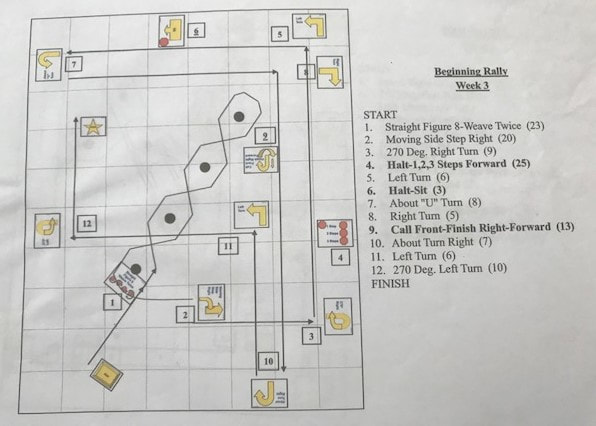
Things to work on:
1. SIGN #23: Straight Figure 8 - Weave Twice 2. SIGN #20: Moving Side Step Right 3. SIGN #9: 270 Degree Right 4. SIGN #25: Halt-1,2,3 Steps Forward 5. SIGN #3: Halt Sit 6. SIGN #8: About "U" Turn 7. SIGN #5: Right Turn 8. CHANGE from SIGN #13 to #15: Call Front Finish Right HALT (not Forward) 9. SIGN #7: About Turn Right 10. SIGN #6: Left Turn 11. SIGN #10: 270 Degree Left |
New Skills: Course Practice:
Right Turn Rally Course #101-1R - repeat - 2nd try (see Session 2 for course)
End with playtime (fetch, tummy rub, brushing ??)
Right Turn Rally Course #101-1R - repeat - 2nd try (see Session 2 for course)
End with playtime (fetch, tummy rub, brushing ??)
|
START SIGN
1. SIGN 10 - 270 Degree Left 2. SIGN #6 - Left Turn 3. SIGN #8 - About "U" Turn 4. SIGN #13 - Call Front Finish Left Halt 5. SIGN #6 - Left Turn 6. SIGN #4 - Halt-Sit-Down 7. SIGN #29 - Left About Turn 8. SIGN #12 - Call Front Finish Left Forward 9. SIGN #11 - 360 Degree Left 10. SIGN #10 - 270 Degree Left 11. SIGN #3 - Halt Sit FINISH SIGN |
TURKEY LEG - Skills Set #7:
|
Warmups - The Basics - Daily Reviews
Rapt Attention ("watch me") - gradually add more and more distractions
Nose Targeting (and/or Target stick) -Hold clicker and treats in RH. Hold out your empty LH in an inviting manner (2 or 3 fingers straight to form a "target stick" of sorts). Most dogs will sniff it out of curiosity. Click and treat with your RH as soon as dog sniffs or touches your left hand. Repeat a bunch of times. Then switch hands. Make it into a fun game, holding your hand low to ground or high so dog has to jump. Say "touch". Use the target stick in the same way. (You can start to bring your LH back behind you in preparation for teaching the left finish, or your RH back behind you for the right finish.) Target Pad/Board - "Magnetize" the target pad - click and treat anytime dog gets all 4 feet on target bad ...... position target pad/handler into "front" "side" "heel" ,,,, positions then give commands for stand/sit/down ..... work on puppy pushups ....-practice moving into positions (into finish or into front after sit/down stay and "come". You will use this to perfect stands, different types of downs and sits, to aide with positions (heel, side, front), for stays and all sorts of things. To be truly "magnetized" the dog will run to get on the target pad as soon as you drop it on the ground. VELCRO DOG (Teaching Heel): Train off leash. Walk around briskly, left arm on your stomach, elbow tucked in, head and shoulders straight. (Show your dog the 'right" picture). Don't say anything, just start walking. The instant your dog comes anywhere near heel position, click and treat and then change directions. Repeat this exercise for a few minutes at a time in many different locations for about 1-2 weeks. Run around - be silly. Once your dog is staying with you and you couldn't get rid of him eve if you tried, you may go onto the next step. Change of Pace (SIGNS #17-19) Slow, Fast, Normal, Slow pace: Slow means you move slowly enough that your dog is walking; Normal is when your dog is trotting comfortably; Fast means you jog so dog is running or at least trotting at a very fast pace. Practice heeling to a metronome. Make sure you are rolling your foot, standing in the correct posture, and that your stride is the same with each beat. For the slow pace, make your stride a little smaller and stand up a little straighter (and breathe slower!). For the fast pace, use a somewhat longer stride with your torso tilted a bit forward. No matter the pace, always do the heel/center/toe roll with your feet with left hand up at your waist, elbow tucked in. Spector Salsa: Fronts and Finishes: Call Front Finish Left Halt; Call Front Finish Right Halt; Call Front Finish Left Forward. Can still include Recall Games for fun - optional:
Down STAY in Heel Position (use target pad to left of handler -- use a wall/fence for straight sits ... gradually increase duration of down before click/treat. Start to take a step or 2 - goal = "walk around") (Eventually raise criteria for all of these skills (make dog hold attention longer before click/treat; change venue and practice in parking lots, fields, schoolyards, parks, stores, downtown. Dog should be able to do pretty well after a couple of weeks of daily attention work but it is important to reinforce lifelong.) Signs: "5 New - 5 review" 5 NEW: 1) Sign #34: Halt-Left Turn-Forward 2) Sign #22: Spiral Left - Dog Inside 3) Clarify Sign #23: Straight Figure 8-Weave Twice and SIGN #24: Serpentine Weave Once 4) Sign #32: Figure 8- No Distractions 5) Sign #30: Halt-Walk Around Dog 5 REVIEW: 1. SIGN #21: Spiral Right-Dog Outside 2. SIGN #20 : Moving Side Step 3. SIGN #26: Call Front 1-2-3 Steps Backward 4. SIGN # SIGN #25: Halt-1,2,3 Steps Forward 5. SIGN #4: Halt-Down
End with playtime and lots of attention |
Course for NEXT session:
Things to work on:
1.SIGN #21: Spiral Right-Dog Outside 2. SIGN#10: 270 Degree Left 3. SIGN #29: Left About Turn 4. SIGN #24: Serpentine Weave Once 5. SIGN #4: Halt-Down (Halt-Sit-Down?) 6. SIGN#5: Right Turn 7. SIGN #26: Call Front 1-2-3- Steps Backward 8. SIGN #6: Left Turn 9. SIGN #16: Call Front Finish Left Halt 10. SIGN #8: About "U" Turn 11. SIGN #26: Halt-Slow Forward From Sit |
|
1. SIGN #23: Straight Figure 8 - Weave Twice
2. SIGN #20: Moving Side Step Right 3. SIGN #9: 270 Degree Right 4. SIGN #25: Halt-1,2,3 Steps Forward 5. SIGN #3: Halt Sit 6. SIGN #8: About "U" Turn 7. SIGN #5: Right Turn 8. CHANGE from SIGN #13 to #15: Call Front Finish Right HALT (not Forward) 9. SIGN #7: About Turn Right 10. SIGN #6: Left Turn 11. SIGN #10: 270 Degree Left |
PEANUT BUTTER 'N JELLY - Skills Set #8:
|
Warmups - The Basics - Daily Reviews Rapt Attention ("watch me") - gradually add more and more distractions
Nose Targeting (and/or Target stick) -Hold clicker and treats in RH. Hold out your empty LH in an inviting manner (2 or 3 fingers straight to form a "target stick" of sorts). Most dogs will sniff it out of curiosity. Click and treat with your RH as soon as dog sniffs or touches your left hand. Repeat a bunch of times. Then switch hands. Make it into a fun game, holding your hand low to ground or high so dog has to jump. Say "touch". Use the target stick in the same way. (You can start to bring your LH back behind you in preparation for teaching the left finish, or your RH back behind you for the right finish.) Target Pad/Board - "Magnetize" the target pad - click and treat anytime dog gets all 4 feet on target bad ...... position target pad/handler into "front" "side" "heel" ,,,, positions then give commands for stand/sit/down ..... work on puppy pushups ....-practice moving into positions (into finish or into front after sit/down stay and "come". You will use this to perfect stands, different types of downs and sits, to aide with positions (heel, side, front), for stays and all sorts of things. To be truly "magnetized" the dog will run to get on the target pad as soon as you drop it on the ground. VELCRO DOG (Teaching Heel): Train off leash. Walk around briskly, left arm on your stomach, elbow tucked in, head and shoulders straight. (Show your dog the 'right" picture). Don't say anything, just start walking. The instant your dog comes anywhere near heel position, click and treat and then change directions. Repeat this exercise for a few minutes at a time in many different locations for about 1-2 weeks. Run around - be silly. Once your dog is staying with you and you couldn't get rid of him eve if you tried, you may go onto the next step. Change of Pace (SIGNS #17-19) Slow, Fast, Normal, Slow pace: Slow means you move slowly enough that your dog is walking; Normal is when your dog is trotting comfortably; Fast means you jog so dog is running or at least trotting at a very fast pace. Practice heeling to a metronome. Make sure you are rolling your foot, standing in the correct posture, and that your stride is the same with each beat. For the slow pace, make your stride a little smaller and stand up a little straighter (and breathe slower!). For the fast pace, use a somewhat longer stride with your torso tilted a bit forward. No matter the pace, always do the heel/center/toe roll with your feet with left hand up at your waist, elbow tucked in. Spector Salsa: Fronts and Finishes: Call Front Finish Left Halt; Call Front Finish Right Halt; Call Front Finish Left Forward. Can still include Recall Games for fun - optional:
Down STAY in Heel Position (use target pad to left of handler -- use a wall/fence for straight sits ... gradually increase duration of down before click/treat. Start to take a step or 2 - goal = "walk around") (Eventually raise criteria for all of these skills (make dog hold attention longer before click/treat; change venue and practice in parking lots, fields, schoolyards, parks, stores, downtown. Dog should be able to do pretty well after a couple of weeks of daily attention work but it is important to reinforce lifelong.) Signs: "5 New - 5 review" 5 New Signs: 1. SIGN #28: Halt - Fast Forward From Sit 2. SIGN #13: Call Front Finish Right Forward 3. SIGN 42: Offset Serpentine Left - (This sign requires three pylons. The center pylon will be offset to the left by 3-4 feet with the other two spaced approximately 6-8 feet apart. The dog and handler will enter into the weave with the first pylon on their left side. They must complete the entire serpentine together) 4. SIGN 41: Offset Serpentine Right - (This sign requires three pylons. The center pylon will be offset to the left by 3-4 feet with the other two spaced approximately 6-8 feet apart. The dog and handler will enter into the weave with the first pylon on their right side. They must complete the entire serpentine together) 5. SIGN 40: Diagonal Left – (While heeling, the dog and handler make an open angle turn to the left. The dog must move with the handler. This sign will be placed directly in line of the team’s path) 5 Review Signs: 1. SIGN #21: Spiral Right-Dog Outside 2. SIGNS #13 and #15: Call Front Finish Right Forward and Call Front Finish Right Halt 3. SIGN #26: Call Front 1-2-3- Steps Backward 4. SIGN #36: Halt-Slow Forward From Sit 5. SIGN #29: Left About Turn Course: Beginning Rally Week 4 End with playtime and lots of attention |
Course for NEXT Session:
1. Sign #36: Halt-Slow Forward From Sit
2. Sign #19: Normal Pace 3. Sign #8: About "U" Turn 4. Sign #12: 360 Degree Left Turn 5. Sign #26: Call Front - 1,2,3 Steps Backward 6. Sign #5: Right Turn 7. Sign #7: About Turn Right 8. Sign #6: Left Turn 9. Sign #27: Down and Stop 10. Sign #11: 360 Degree Right Turn 11. Sign #33: Halt-Left Turn-Forward 12. Sign #22: Spiral Left - Dog Inside 13. Sign #23: Straight Figure 8-Weave Twice 14. Sign #32: Figure 8- No Distractions 15. Sign #30: Halt-Walk Around Dog |
HAMMOCK SWING (Incorporating some of the NEW signs) - Skills Set #9
|
Warmups - The Basics - Daily Reviews
Rapt Attention ("watch me") - gradually add more and more distractions
Nose Targeting (and/or Target stick) -Hold clicker and treats in RH. Hold out your empty LH in an inviting manner (2 or 3 fingers straight to form a "target stick" of sorts). Most dogs will sniff it out of curiosity. Click and treat with your RH as soon as dog sniffs or touches your left hand. Repeat a bunch of times. Then switch hands. Make it into a fun game, holding your hand low to ground or high so dog has to jump. Say "touch". Use the target stick in the same way. (You can start to bring your LH back behind you in preparation for teaching the left finish, or your RH back behind you for the right finish.) Target Pad/Board - "Magnetize" the target pad - click and treat anytime dog gets all 4 feet on target bad ...... position target pad/handler into "front" "side" "heel" ,,,, positions then give commands for stand/sit/down ..... work on puppy pushups ....-practice moving into positions (into finish or into front after sit/down stay and "come". You will use this to perfect stands, different types of downs and sits, to aide with positions (heel, side, front), for stays and all sorts of things. To be truly "magnetized" the dog will run to get on the target pad as soon as you drop it on the ground. VELCRO DOG (Teaching Heel): Train off leash. Walk around briskly, left arm on your stomach, elbow tucked in, head and shoulders straight. (Show your dog the 'right" picture). Don't say anything, just start walking. The instant your dog comes anywhere near heel position, click and treat and then change directions. Repeat this exercise for a few minutes at a time in many different locations for about 1-2 weeks. Run around - be silly. Once your dog is staying with you and you couldn't get rid of him eve if you tried, you may go onto the next step. Change of Pace (SIGNS #17-19) Slow, Fast, Normal, Slow pace: Slow means you move slowly enough that your dog is walking; Normal is when your dog is trotting comfortably; Fast means you jog so dog is running or at least trotting at a very fast pace. Practice heeling to a metronome. Make sure you are rolling your foot, standing in the correct posture, and that your stride is the same with each beat. For the slow pace, make your stride a little smaller and stand up a little straighter (and breathe slower!). For the fast pace, use a somewhat longer stride with your torso tilted a bit forward. No matter the pace, always do the heel/center/toe roll with your feet with left hand up at your waist, elbow tucked in. Spector Salsa: Fronts and Finishes: Call Front Finish Left Halt; Call Front Finish Right Halt; Call Front Finish Left Forward. Can still include Recall Games for fun - optional:
Sit STAY in Heel Position (use target pad to left of handler -- use a wall/fence for straight sits ... gradually increase duration of sit before click/treat. Start to take a step or 2 - goal = "walk around") Down STAY in Heel Position (use target pad to left of handler -- use a wall/fence for straight sits ... gradually increase duration of down before click/treat. Start to take a step or 2 - goal = "walk around") (Eventually raise criteria for all of these skills (make dog hold attention longer before click/treat; change venue and practice in parking lots, fields, schoolyards, parks, stores, downtown. Dog should be able to do pretty well after a couple of weeks of daily attention work but it is important to reinforce lifelong.) Signs: "5 New - 5 review" 5 New Signs: 1) SIGN #37: Loop Right (While heeling, the dog and handler loop right crossing over the original path.) 2) SIGN #38: Loop Left (While heeling, the dog and handler loop left crossing over the original path.) 3) SIGN #39: Diagonal Right (While heeling, the dog and handler make an open angle turn to the right. The dog must move with the handler. This sign will be placed directly in line of the team’s path) 4) SIGN #31: Halt Down Walk Around Dog 5) SIGN #33: Halt - Right Turn Forward 5 Review Signs: 1. SIGN #41: Offset Serpentine Right 2. SIGN #42: Offset Serpentine Left 3. SIGN #40: Diagonal Left 4. SIGN #13: Call Front Finish Right Forward 5. SIGN #29: Left About Turn Practice Course: Beginning Rally Week 5 End session with playtime or cuddle! |

Next session's course TBA - Doodle by Pickwick Design will incorporate new signs:
coming soon ....
but will include these signs: 42) Offset Serpentine Left - (This sign requires three pylons. The center pylon will be offset to the left by 3-4 feet with the other two spaced approximately 6-8 feet apart. The dog and handler will enter into the weave with the first pylon on their left side. They must complete the entire serpentine together) 41) Offset Serpentine Right - (This sign requires three pylons. The center pylon will be offset to the left by 3-4 feet with the other two spaced approximately 6-8 feet apart. The dog and handler will enter into the weave with the first pylon on their right side. They must complete the entire serpentine together) TBA) skills needing to be addressed at this point, individual to dog |
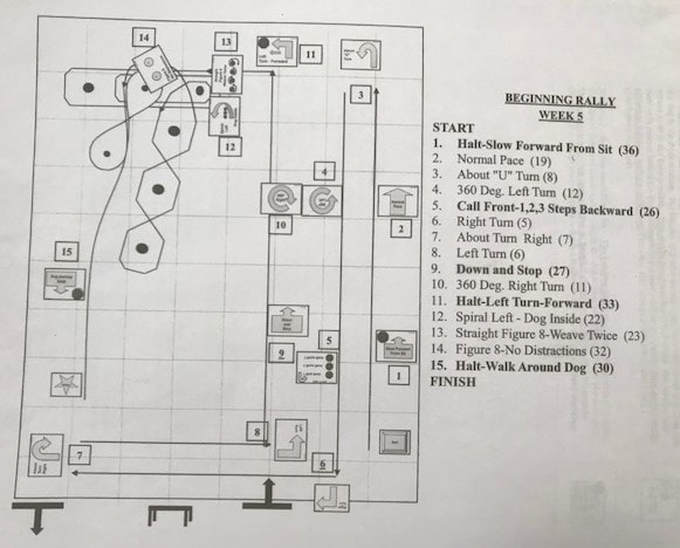
1. Sign #36: Halt-Slow Forward From Sit
2. Sign #19: Normal Pace
3. Sign #8: About "U" Turn
4. Sign #12: 360 Degree Left Turn
5. Sign #26: Call Front - 1,2,3 Steps Backward
6. Sign #5: Right Turn
7. Sign #7: About Turn Right
8. Sign #6: Left Turn
9. Sign #27: Down and Stop
10. Sign #11: 360 Degree Right Turn
11. Sign #33: Halt-Left Turn-Forward
12. Sign #22: Spiral Left - Dog Inside
13. Sign #23: Straight Figure 8-Weave Twice
14. Sign #32: Figure 8- No Distractions
15. Sign #30: Halt-Walk Around
2. Sign #19: Normal Pace
3. Sign #8: About "U" Turn
4. Sign #12: 360 Degree Left Turn
5. Sign #26: Call Front - 1,2,3 Steps Backward
6. Sign #5: Right Turn
7. Sign #7: About Turn Right
8. Sign #6: Left Turn
9. Sign #27: Down and Stop
10. Sign #11: 360 Degree Right Turn
11. Sign #33: Halt-Left Turn-Forward
12. Sign #22: Spiral Left - Dog Inside
13. Sign #23: Straight Figure 8-Weave Twice
14. Sign #32: Figure 8- No Distractions
15. Sign #30: Halt-Walk Around
Tripe Scented Anything! - Skills Set #10:
|
Warmups - The Basics - Daily Reviews
Rapt Attention ("watch me") - gradually add more and more distractions
Nose Targeting (and/or Target stick) -Hold clicker and treats in RH. Hold out your empty LH in an inviting manner (2 or 3 fingers straight to form a "target stick" of sorts). Most dogs will sniff it out of curiosity. Click and treat with your RH as soon as dog sniffs or touches your left hand. Repeat a bunch of times. Then switch hands. Make it into a fun game, holding your hand low to ground or high so dog has to jump. Say "touch". Use the target stick in the same way. (You can start to bring your LH back behind you in preparation for teaching the left finish, or your RH back behind you for the right finish.) Target Pad/Board - "Magnetize" the target pad - click and treat anytime dog gets all 4 feet on target bad ...... position target pad/handler into "front" "side" "heel" ,,,, positions then give commands for stand/sit/down ..... work on puppy pushups ....-practice moving into positions (into finish or into front after sit/down stay and "come". You will use this to perfect stands, different types of downs and sits, to aide with positions (heel, side, front), for stays and all sorts of things. To be truly "magnetized" the dog will run to get on the target pad as soon as you drop it on the ground. VELCRO DOG (Teaching Heel): Train off leash. Walk around briskly, left arm on your stomach, elbow tucked in, head and shoulders straight. (Show your dog the 'right" picture). Don't say anything, just start walking. The instant your dog comes anywhere near heel position, click and treat and then change directions. Repeat this exercise for a few minutes at a time in many different locations for about 1-2 weeks. Run around - be silly. Once your dog is staying with you and you couldn't get rid of him eve if you tried, you may go onto the next step. Change of Pace (SIGNS #17-19) Slow, Fast, Normal, Slow pace: Slow means you move slowly enough that your dog is walking; Normal is when your dog is trotting comfortably; Fast means you jog so dog is running or at least trotting at a very fast pace. Practice heeling to a metronome. Make sure you are rolling your foot, standing in the correct posture, and that your stride is the same with each beat. For the slow pace, make your stride a little smaller and stand up a little straighter (and breathe slower!). For the fast pace, use a somewhat longer stride with your torso tilted a bit forward. No matter the pace, always do the heel/center/toe roll with your feet with left hand up at your waist, elbow tucked in. Spector Salsa: Fronts and Finishes: Call Front Finish Left Halt; Call Front Finish Right Halt; Call Front Finish Left Forward. Can still include Recall Games for fun - optional
Sit STAY in Heel Position (use target pad to left of handler -- use a wall/fence for straight sits ... gradually increase duration of sit before click/treat. Start to take a step or 2 - goal = "walk around") Down STAY in Heel Position (use target pad to left of handler -- use a wall/fence for straight sits ... gradually increase duration of down before click/treat. Start to take a step or 2 - goal = "walk around") (Eventually raise criteria for all of these skills (make dog hold attention longer before click/treat; change venue and practice in parking lots, fields, schoolyards, parks, stores, downtown. Dog should be able to do pretty well after a couple of weeks of daily attention work but it is important to reinforce lifelong.) Signs: "5 New - 5 review" 5 New Signs: 1. SIGN #35: Call Front Return to Heel 2. Clarify SIGNS #28 and 36: Halt Slow (or Fast) Forward from Sit 4. Clarify SIGNS #22 and 24: (Spiral Left Dog Inside; Serpentine Weave Once) 5. SIGN #27: Stop and Down 5 Review Signs:
(OR choose as needed from): |
Next session's course TBA - Doodle by Pickwick Design will incorporate new signs:
coming soon . . . . But will include: 40) Diagonal Left – (While heeling, the dog and handler make an open angle turn to the left. The dog must move with the handler. This sign will be placed directly in line of the team’s path) 39) Diagonal Right – (While heeling, the dog and handler make an open angle turn to the right. The dog must move with the handler. This sign will be placed directly in line of the team’s path) 38) Loop Left - (While heeling, the dog and handler loop left crossing over the original path.) 37) Loop Right - (While heeling, the dog and handler loop right crossing over the original path.) TBA) skills needing to be addressed at this point, individual to dog |
Practice Course (TBA) Coming Soon . . . . . . . .
End session with playtime or cuddle!
End session with playtime or cuddle!
Tail Chasing Fun! - Skills Set #11:
|
Warmups - The Basics - Daily Reviews
Rapt Attention ("watch me") - gradually add more and more distractions
Nose Targeting (and/or Target stick) -Hold clicker and treats in RH. Hold out your empty LH in an inviting manner (2 or 3 fingers straight to form a "target stick" of sorts). Most dogs will sniff it out of curiosity. Click and treat with your RH as soon as dog sniffs or touches your left hand. Repeat a bunch of times. Then switch hands. Make it into a fun game, holding your hand low to ground or high so dog has to jump. Say "touch". Use the target stick in the same way. (You can start to bring your LH back behind you in preparation for teaching the left finish, or your RH back behind you for the right finish.) Target Pad/Board - "Magnetize" the target pad - click and treat anytime dog gets all 4 feet on target bad ...... position target pad/handler into "front" "side" "heel" ,,,, positions then give commands for stand/sit/down ..... work on puppy pushups ....-practice moving into positions (into finish or into front after sit/down stay and "come". You will use this to perfect stands, different types of downs and sits, to aide with positions (heel, side, front), for stays and all sorts of things. To be truly "magnetized" the dog will run to get on the target pad as soon as you drop it on the ground. VELCRO DOG (Teaching Heel): Train off leash. Walk around briskly, left arm on your stomach, elbow tucked in, head and shoulders straight. (Show your dog the 'right" picture). Don't say anything, just start walking. The instant your dog comes anywhere near heel position, click and treat and then change directions. Repeat this exercise for a few minutes at a time in many different locations for about 1-2 weeks. Run around - be silly. Once your dog is staying with you and you couldn't get rid of him eve if you tried, you may go onto the next step. Change of Pace (SIGNS #17-19) Slow, Fast, Normal, Slow pace: Slow means you move slowly enough that your dog is walking; Normal is when your dog is trotting comfortably; Fast means you jog so dog is running or at least trotting at a very fast pace. Practice heeling to a metronome. Make sure you are rolling your foot, standing in the correct posture, and that your stride is the same with each beat. For the slow pace, make your stride a little smaller and stand up a little straighter (and breathe slower!). For the fast pace, use a somewhat longer stride with your torso tilted a bit forward. No matter the pace, always do the heel/center/toe roll with your feet with left hand up at your waist, elbow tucked in. Fronts and Finishes: Call Front Finish Left Halt; Call Front Finish Right Halt; Call Front Finish Left Forward. Can still include Recall Games for fun - optional Sit STAY in Heel Position (use target pad to left of handler -- use a wall/fence for straight sits ... gradually increase duration of sit before click/treat. Start to take a step or 2 - goal = "walk around") Down STAY in Heel Position (use target pad to left of handler -- use a wall/fence for straight sits ... gradually increase duration of down before click/treat. Start to take a step or 2 - goal = "walk around") (Eventually raise criteria for all of these skills (make dog hold attention longer before click/treat; change venue and practice in parking lots, fields, schoolyards, parks, stores, downtown. Dog should be able to do pretty well after a couple of weeks of daily attention work but it is important to reinforce lifelong.) Signs: "5 New - 5 review" Upcoming Signs - Choose 5 1. SIGN #17 - Slow Pace 2. SIGN #19 - Normal Pace 3. SIGN #7 - About Turn Right 4. SIGN #26 - Call Front - 1,2,3 Steps Backward 5. SIGN #5 -Left Turn 6. SIGN #9 - 270 Degree Right Turn 7. SIGN #31: Halt-Down-Walk Around Dog 8. SIGN #11: 360 Degree Right Turn 9. SIGN #5: Left Turn 10. SIGN #29: Left About Turn 11. SIGN #5: Halt-Sit 12. SIGN #10: 270 Degree Left Turn 13. SIGN #5: Right Turn 14. SIGN #32: Figure 8 -No Distractions Other Review Signs - choose 5 from: |
Course for NEXT Session - Beginning Rally Week 6
1. SIGN #17: Slow Pace
2. SIGN #19: Normal Pace 3. SIGN #7: About Turn Right 4. SIGN #26: Call Front 1,2,3, Steps Backward 5. SIGN #5: Left Turn 6. SIGN #9: 270 Degree Right Turn 7. SIGN #31: Halt-Down Walk Around Dog 8. SIGN #11: 360 Degree Right Turn 9. SIGN #6: Left Turn 10. SIGN #29: Left About Turn 11. SIGN #3: Halt-Sit 12. SIGN #10: 270 Degree Left Turn 13. SIGN #5: Right Turn 14. SIGN #32: Figure 8 - No Distractions |
Course TBA Coming Soon . . . .
CHEWY.COM DELIVERY DAY - Skills Set #12:
|
Warmups - The Basics - Daily Reviews
Rapt Attention ("watch me") - gradually add more and more distractions
Nose Targeting (and/or Target stick) -Hold clicker and treats in RH. Hold out your empty LH in an inviting manner (2 or 3 fingers straight to form a "target stick" of sorts). Most dogs will sniff it out of curiosity. Click and treat with your RH as soon as dog sniffs or touches your left hand. Repeat a bunch of times. Then switch hands. Make it into a fun game, holding your hand low to ground or high so dog has to jump. Say "touch". Use the target stick in the same way. (You can start to bring your LH back behind you in preparation for teaching the left finish, or your RH back behind you for the right finish.) Target Pad/Board - "Magnetize" the target pad - click and treat anytime dog gets all 4 feet on target bad ...... position target pad/handler into "front" "side" "heel" ,,,, positions then give commands for stand/sit/down ..... work on puppy pushups ....-practice moving into positions (into finish or into front after sit/down stay and "come". You will use this to perfect stands, different types of downs and sits, to aide with positions (heel, side, front), for stays and all sorts of things. To be truly "magnetized" the dog will run to get on the target pad as soon as you drop it on the ground. VELCRO DOG (Teaching Heel): Train off leash. Walk around briskly, left arm on your stomach, elbow tucked in, head and shoulders straight. (Show your dog the 'right" picture). Don't say anything, just start walking. The instant your dog comes anywhere near heel position, click and treat and then change directions. Repeat this exercise for a few minutes at a time in many different locations for about 1-2 weeks. Run around - be silly. Once your dog is staying with you and you couldn't get rid of him eve if you tried, you may go onto the next step. Change of Pace (SIGNS #17-19) Slow, Fast, Normal, Slow pace: Slow means you move slowly enough that your dog is walking; Normal is when your dog is trotting comfortably; Fast means you jog so dog is running or at least trotting at a very fast pace. Practice heeling to a metronome. Make sure you are rolling your foot, standing in the correct posture, and that your stride is the same with each beat. For the slow pace, make your stride a little smaller and stand up a little straighter (and breathe slower!). For the fast pace, use a somewhat longer stride with your torso tilted a bit forward. No matter the pace, always do the heel/center/toe roll with your feet with left hand up at your waist, elbow tucked in. Fronts and Finishes: Call Front Finish Left Halt; Call Front Finish Right Halt; Call Front Finish Left Forward. Can still include Recall Games for fun - optional Sit STAY in Heel Position (use target pad to left of handler -- use a wall/fence for straight sits ... gradually increase duration of sit before click/treat. Start to take a step or 2 - goal = "walk around") Down STAY in Heel Position (use target pad to left of handler -- use a wall/fence for straight sits ... gradually increase duration of down before click/treat. Start to take a step or 2 - goal = "walk around") (Eventually raise criteria for all of these skills (make dog hold attention longer before click/treat; change venue and practice in parking lots, fields, schoolyards, parks, stores, downtown. Dog should be able to do pretty well after a couple of weeks of daily attention work but it is important to reinforce lifelong.) Signs: "5 New - 5 review" Upcoming Signs - Choose 5 1. SIGN #17 - Slow Pace 2. SIGN #19 - Normal Pace 3. SIGN #7 - About Turn Right 4. SIGN #26 - Call Front - 1,2,3 Steps Backward 5. SIGN #5 -Left Turn 6. SIGN #9 - 270 Degree Right Turn 7. SIGN #31: Halt-Down-Walk Around Dog 8. SIGN #11: 360 Degree Right Turn 9. SIGN #5: Left Turn 10. SIGN #29: Left About Turn 11. SIGN #5: Halt-Sit 12. SIGN #10: 270 Degree Left Turn 13. SIGN #5: Right Turn 14. SIGN #32: Figure 8 -No Distractions Other Review Signs - choose 5 from: |
Course for NEXT Session - Beginning Rally Week 7
1. SIGN #10: 270 Degree Left Turn
2. SIGN #14: Call Front-Finish Left Forward 3. SIGN #35: Call Front Return to Heel 4. SIGN #5: Right Turn 5. SIGN #9: 270 Degree Right Turn 6. SIGN #6: Left Turn 7. SIGN #11: 360 Degree Right Turn 8. SIGN #4: Halt Down 9. SIGN #9: 270 Degree Right Turn 10. SIGN #6: Left Turn 11. SIGN #25: Halt 1,2,3 Steps Forward 12. SIGN #21: Spiral Right-Dog Outside 13. SIGN #31: Halt Down, Walk Around Dog 14. SIGN #5: Right Turn |
|
1. SIGN #17: Slow Pace
2. SIGN #19: Normal Pace 3. SIGN #7: About Turn Right 4. SIGN #26: Call Front 1,2,3, Steps Backward 5. SIGN #5: Left Turn 6. SIGN #9: 270 Degree Right Turn 7. SIGN #31: Halt-Down Walk Around Dog 8. SIGN #11: 360 Degree Right Turn 9. SIGN #6: Left Turn 10. SIGN #29: Left About Turn 11. SIGN #3: Halt-Sit 12. SIGN #10: 270 Degree Left Turn 13. SIGN #5: Right Turn 14. SIGN #32: Figure 8 - No Distractions |
FRESH LINENS - Skills Set #13:
|
Warmups - The Basics - Daily Reviews
Rapt Attention ("watch me") - gradually add more and more distractions
Nose Targeting (and/or Target stick) -Hold clicker and treats in RH. Hold out your empty LH in an inviting manner (2 or 3 fingers straight to form a "target stick" of sorts). Most dogs will sniff it out of curiosity. Click and treat with your RH as soon as dog sniffs or touches your left hand. Repeat a bunch of times. Then switch hands. Make it into a fun game, holding your hand low to ground or high so dog has to jump. Say "touch". Use the target stick in the same way. (You can start to bring your LH back behind you in preparation for teaching the left finish, or your RH back behind you for the right finish.) Target Pad/Board - "Magnetize" the target pad - click and treat anytime dog gets all 4 feet on target bad ...... position target pad/handler into "front" "side" "heel" ,,,, positions then give commands for stand/sit/down ..... work on puppy pushups ....-practice moving into positions (into finish or into front after sit/down stay and "come". You will use this to perfect stands, different types of downs and sits, to aide with positions (heel, side, front), for stays and all sorts of things. To be truly "magnetized" the dog will run to get on the target pad as soon as you drop it on the ground. VELCRO DOG (Teaching Heel): Train off leash. Walk around briskly, left arm on your stomach, elbow tucked in, head and shoulders straight. (Show your dog the 'right" picture). Don't say anything, just start walking. The instant your dog comes anywhere near heel position, click and treat and then change directions. Repeat this exercise for a few minutes at a time in many different locations for about 1-2 weeks. Run around - be silly. Once your dog is staying with you and you couldn't get rid of him eve if you tried, you may go onto the next step. Change of Pace (SIGNS #17-19) Slow, Fast, Normal, Slow pace: Slow means you move slowly enough that your dog is walking; Normal is when your dog is trotting comfortably; Fast means you jog so dog is running or at least trotting at a very fast pace. Practice heeling to a metronome. Make sure you are rolling your foot, standing in the correct posture, and that your stride is the same with each beat. For the slow pace, make your stride a little smaller and stand up a little straighter (and breathe slower!). For the fast pace, use a somewhat longer stride with your torso tilted a bit forward. No matter the pace, always do the heel/center/toe roll with your feet with left hand up at your waist, elbow tucked in. Fronts and Finishes: Call Front Finish Left Halt; Call Front Finish Right Halt; Call Front Finish Left Forward. Can still include Recall Games for fun - optional: Sit STAY in Heel Position (use target pad to left of handler -- use a wall/fence for straight sits ... gradually increase duration of sit before click/treat. Start to take a step or 2 - goal = "walk around") Down STAY in Heel Position (use target pad to left of handler -- use a wall/fence for straight sits ... gradually increase duration of down before click/treat. Start to take a step or 2 - goal = "walk around") (Eventually raise criterin for all of these skills (make dog hold attention longer before click/treat; change venue and practice in parking lots, fields, schoolyards, parks, stores, downtown. Dog should be able to do pretty well after a couple of weeks of daily attention work but it is important to reinforce lifelong.) Signs: "5 New - 5 review" Upcoming Signs - Choose 5 1. Halt-Fast Forward From Sit 2. Normal Pace 3. Left Turn 4. 270 Degree Right Turn 5. Call Front 1,2,3 Steps Back 6. About Turn Right 7. Halt-Sit 8. Spiral Left Dog Inside 9. Left Turn 10. Slow Pacea11. Normal Pace 12. Serpentine Weave Once 13. Call Front Finish Right Halt 14. 270 Degree Right 15. 360 Degree Left Other Review Signs - choose 5 from: |
Course for NEXT Session:
1. Halt-Fast Forward From Sit
2. Normal Pace 3. Left Turn 4. 270 Degree Right Turn 5. Call Front 1,2,3 Steps Back 6. About Turn Right 7. Halt-Sit 8. Spiral Left Dog Inside 9. Left Turn 10. Slow Pace 11. Normal Pace 12. Serpentine Weave Once 13. Call Front Finish Right Halt 14. 270 Degree Right 15. 360 Degree Left |
|
1. SIGN #10: 270 Degree Left Turn
2. SIGN #14: Call Front-Finish Left Forward 3. SIGN #35: Call Front Return to Heel 4. SIGN #5: Right Turn 5. SIGN #9: 270 Degree Right Turn 6. SIGN #6: Left Turn 7. SIGN #11: 360 Degree Right Turn 8. SIGN #4: Halt Down 9. SIGN #9: 270 Degree Right Turn 10. SIGN #6: Left Turn 11. SIGN #25: Halt 1,2,3 Steps Forward 12. SIGN #21: Spiral Right-Dog Outside 13. SIGN #31: Halt Down, Walk Around Dog 14. SIGN #5: Right Turn |
BACON BISCUIT - Skills Set #14:
|
Warmups - The Basics - Daily Reviews
Rapt Attention ("watch me") - gradually add more and more distractions
Nose Targeting (and/or Target stick) -Hold clicker and treats in RH. Hold out your empty LH in an inviting manner (2 or 3 fingers straight to form a "target stick" of sorts). Most dogs will sniff it out of curiosity. Click and treat with your RH as soon as dog sniffs or touches your left hand. Repeat a bunch of times. Then switch hands. Make it into a fun game, holding your hand low to ground or high so dog has to jump. Say "touch". Use the target stick in the same way. (You can start to bring your LH back behind you in preparation for teaching the left finish, or your RH back behind you for the right finish.) Target Pad/Board - "Magnetize" the target pad - click and treat anytime dog gets all 4 feet on target bad ...... position target pad/handler into "front" "side" "heel" ,,,, positions then give commands for stand/sit/down ..... work on puppy pushups ....-practice moving into positions (into finish or into front after sit/down stay and "come". You will use this to perfect stands, different types of downs and sits, to aide with positions (heel, side, front), for stays and all sorts of things. To be truly "magnetized" the dog will run to get on the target pad as soon as you drop it on the ground. VELCRO DOG (Teaching Heel): Train off leash. Walk around briskly, left arm on your stomach, elbow tucked in, head and shoulders straight. (Show your dog the 'right" picture). Don't say anything, just start walking. The instant your dog comes anywhere near heel position, click and treat and then change directions. Repeat this exercise for a few minutes at a time in many different locations for about 1-2 weeks. Run around - be silly. Once your dog is staying with you and you couldn't get rid of him eve if you tried, you may go onto the next step. Change of Pace (SIGNS #17-19) Slow, Fast, Normal, Slow pace: Slow means you move slowly enough that your dog is walking; Normal is when your dog is trotting comfortably; Fast means you jog so dog is running or at least trotting at a very fast pace. Practice heeling to a metronome. Make sure you are rolling your foot, standing in the correct posture, and that your stride is the same with each beat. For the slow pace, make your stride a little smaller and stand up a little straighter (and breathe slower!). For the fast pace, use a somewhat longer stride with your torso tilted a bit forward. No matter the pace, always do the heel/center/toe roll with your feet with left hand up at your waist, elbow tucked in. Fronts and Finishes: Call Front Finish Left Halt; Call Front Finish Right Halt; Call Front Finish Left Forward. Can still include Recall Games for fun - optional: Sit STAY in Heel Position (use target pad to left of handler -- use a wall/fence for straight sits ... gradually increase duration of sit before click/treat. Start to take a step or 2 - goal = "walk around") Down STAY in Heel Position (use target pad to left of handler -- use a wall/fence for straight sits ... gradually increase duration of down before click/treat. Start to take a step or 2 - goal = "walk around") (Eventually raise criteria for all of these skills (make dog hold attention longer before click/treat; change venue and practice in parking lots, fields, schoolyards, parks, stores, downtown. Dog should be able to do pretty well after a couple of weeks of daily attention work but it is important to reinforce lifelong.) Signs: "5 New - 5 review" 5 New Signs (upcoming-choose 5): 1. Halt-Down Walk Around 2. 270 Degree Left Turn 3. 360 Degree Right Turn 4. Right Turn 5. Moving Side Step Right 6. 270 Degree Left Turn 7. 360 Degree Left 8. Right Turn 9. Spiral Right - Dog Outside 10. Call Front 1,2,3 Steps Back 11. About "U" Turn 12. Serpentine Weave once 13. Left Turn 5 Review Signs - Choose 5 from: |
Course for NEXT Session:
1. Halt-Down Walk Around
2. 270 Degree Left Turn 3. 360 Degree Right Turn 4. Right Turn 5. Moving Side Step Right 6. 270 Degree Left Turn 7. 360 Degree Left 8. Right Turn 9. Spiral Right - Dog Outside 10. Call Front 1,2,3 Steps Back 11. About "U" Turn 12. Serpentine Weave once 13. Left Turn |
|
1. Halt-Fast Forward From Sit
2. Normal Pace 3. Left Turn 4. 270 Degree Right Turn 5. Call Front 1,2,3 Steps Back 6. About Turn Right 7. Halt-Sit 8. Spiral Left Dog Inside 9. Left Turn 10. Slow Pace 11. Normal Pace 12. Serpentine Weave Once 13. Call Front Finish Right Halt 14. 270 Degree Right 15. 360 Degree Left |
FILET MIGNON - Skills Set #15:
|
Warmups - The Basics - Daily Reviews
Rapt Attention ("watch me") - gradually add more and more distractions
Nose Targeting (and/or Target stick) -Hold clicker and treats in RH. Hold out your empty LH in an inviting manner (2 or 3 fingers straight to form a "target stick" of sorts). Most dogs will sniff it out of curiosity. Click and treat with your RH as soon as dog sniffs or touches your left hand. Repeat a bunch of times. Then switch hands. Make it into a fun game, holding your hand low to ground or high so dog has to jump. Say "touch". Use the target stick in the same way. (You can start to bring your LH back behind you in preparation for teaching the left finish, or your RH back behind you for the right finish.) Target Pad/Board - "Magnetize" the target pad - click and treat anytime dog gets all 4 feet on target bad ...... position target pad/handler into "front" "side" "heel" ,,,, positions then give commands for stand/sit/down ..... work on puppy pushups ....-practice moving into positions (into finish or into front after sit/down stay and "come". You will use this to perfect stands, different types of downs and sits, to aide with positions (heel, side, front), for stays and all sorts of things. To be truly "magnetized" the dog will run to get on the target pad as soon as you drop it on the ground. VELCRO DOG (Teaching Heel): Train off leash. Walk around briskly, left arm on your stomach, elbow tucked in, head and shoulders straight. (Show your dog the 'right" picture). Don't say anything, just start walking. The instant your dog comes anywhere near heel position, click and treat and then change directions. Repeat this exercise for a few minutes at a time in many different locations for about 1-2 weeks. Run around - be silly. Once your dog is staying with you and you couldn't get rid of him eve if you tried, you may go onto the next step. Change of Pace (SIGNS #17-19) Slow, Fast, Normal, Slow pace: Slow means you move slowly enough that your dog is walking; Normal is when your dog is trotting comfortably; Fast means you jog so dog is running or at least trotting at a very fast pace. Practice heeling to a metronome. Make sure you are rolling your foot, standing in the correct posture, and that your stride is the same with each beat. For the slow pace, make your stride a little smaller and stand up a little straighter (and breathe slower!). For the fast pace, use a somewhat longer stride with your torso tilted a bit forward. No matter the pace, always do the heel/center/toe roll with your feet with left hand up at your waist, elbow tucked in. Fronts and Finishes: Call Front Finish Left Halt; Call Front Finish Right Halt; Call Front Finish Left Forward. Can still include Recall Games for fun - optional: Sit STAY in Heel Position (use target pad to left of handler -- use a wall/fence for straight sits ... gradually increase duration of sit before click/treat. Start to take a step or 2 - goal = "walk around") Down STAY in Heel Position (use target pad to left of handler -- use a wall/fence for straight sits ... gradually increase duration of down before click/treat. Start to take a step or 2 - goal = "walk around") (Eventually raise criteria for all of these skills (make dog hold attention longer before click/treat; change venue and practice in parking lots, fields, schoolyards, parks, stores, downtown. Dog should be able to do pretty well after a couple of weeks of daily attention work but it is important to reinforce lifelong.) Signs: "5 New - 5 review" Upcoming Signs - Choose 5: 1. 360 Degree Right 2. Right Turn 3. Moving Side Step Right 4. Slow Place 5. Normal Pace 6. 270 Degree Left 7. Straight Figure 8 Weave Twice 8. Halt, 1,2,3 Steps Forward 9. About Turn Right 10. Down and Stop 11. Right Turn 12. Call Front - 1,2,3 Steps Backward 13. 270 Degree Left 14. Call Front Finish Left Forward 15. Serpentine Weave Once Choose 5 More Review Signs: |
Course for NEXT Session:
1. 360 Degree Right
2. Right Turn 3. Moving Side Step Right 4. Slow Place 5. Normal Pace 6. 270 Degree Left 7. Straight Figure 8 Weave Twice 8. Halt, 1,2,3 Steps Forward 9. About Turn Right 10. Down and Stop 11. Right Turn 12. Call Front - 1,2,3 Steps Backward 13. 270 Degree Left 14. Call Front Finish Left Forward 15. Serpentine Weave Once |
|
1. Halt-Down Walk Around
2. 270 Degree Left Turn 3. 360 Degree Right Turn 4. Right Turn 5. Moving Side Step Right 6. 270 Degree Left Turn 7. 360 Degree Left 8. Right Turn 9. Spiral Right - Dog Outside 10. Call Front 1,2,3 Steps Back 11. About "U" Turn 12. Serpentine Weave once 13. Left Turn |
CAR RIDE! Skills Set #13:
|
Warmups - The Basics - Daily Reviews
Rapt Attention ("watch me") - gradually add more and more distractions
Nose Targeting (and/or Target stick) -Hold clicker and treats in RH. Hold out your empty LH in an inviting manner (2 or 3 fingers straight to form a "target stick" of sorts). Most dogs will sniff it out of curiosity. Click and treat with your RH as soon as dog sniffs or touches your left hand. Repeat a bunch of times. Then switch hands. Make it into a fun game, holding your hand low to ground or high so dog has to jump. Say "touch". Use the target stick in the same way. (You can start to bring your LH back behind you in preparation for teaching the left finish, or your RH back behind you for the right finish.) Target Pad/Board - "Magnetize" the target pad - click and treat anytime dog gets all 4 feet on target bad ...... position target pad/handler into "front" "side" "heel" ,,,, positions then give commands for stand/sit/down ..... work on puppy pushups ....-practice moving into positions (into finish or into front after sit/down stay and "come". You will use this to perfect stands, different types of downs and sits, to aide with positions (heel, side, front), for stays and all sorts of things. To be truly "magnetized" the dog will run to get on the target pad as soon as you drop it on the ground. VELCRO DOG (Teaching Heel): Train off leash. Walk around briskly, left arm on your stomach, elbow tucked in, head and shoulders straight. (Show your dog the 'right" picture). Don't say anything, just start walking. The instant your dog comes anywhere near heel position, click and treat and then change directions. Repeat this exercise for a few minutes at a time in many different locations for about 1-2 weeks. Run around - be silly. Once your dog is staying with you and you couldn't get rid of him eve if you tried, you may go onto the next step. Change of Pace (SIGNS #17-19) Slow, Fast, Normal, Slow pace: Slow means you move slowly enough that your dog is walking; Normal is when your dog is trotting comfortably; Fast means you jog so dog is running or at least trotting at a very fast pace. Practice heeling to a metronome. Make sure you are rolling your foot, standing in the correct posture, and that your stride is the same with each beat. For the slow pace, make your stride a little smaller and stand up a little straighter (and breathe slower!). For the fast pace, use a somewhat longer stride with your torso tilted a bit forward. No matter the pace, always do the heel/center/toe roll with your feet with left hand up at your waist, elbow tucked in. Fronts and Finishes: Call Front Finish Left Halt; Call Front Finish Right Halt; Call Front Finish Left Forward. Can still include Recall Games for fun - optional: Sit STAY in Heel Position (use target pad to left of handler -- use a wall/fence for straight sits ... gradually increase duration of sit before click/treat. Start to take a step or 2 - goal = "walk around") Down STAY in Heel Position (use target pad to left of handler -- use a wall/fence for straight sits ... gradually increase duration of down before click/treat. Start to take a step or 2 - goal = "walk around") (Eventually raise criteria for all of these skills (make dog hold attention longer before click/treat; change venue and practice in parking lots, fields, schoolyards, parks, stores, downtown. Dog should be able to do pretty well after a couple of weeks of daily attention work but it is important to reinforce lifelong.) Signs: "5 New - 5 review" Upcoming Signs - Choose 5: 1, Halt Down Walk Around Dog 2. Serpentine Weave Once 3. Left Turn 4. 270 Degree Right 5. Call Front Finish Left Forward 6. Slow Pace 7. Normal Pace 8. Right Turn 9. Spiral Right Dog Outside 10. Halt - Fast Forward From Sit 11. Normal Pace 12. About "U" Turn 13. Moving Side Step Right 14. 360 Degree Left 15. Halt Sit Down Choose 5 Additional Review Signs: |
Course for NEXT Session:
1, Halt Down Walk Around Dog
2. Serpentine Weave Once 3. Left Turn 4. 270 Degree Right 5. Call Front Finish Left Forward 6. Slow Pace 7. Normal Pace 8. Right Turn 9. Spiral Right Dog Outside 10. Halt - Fast Forward From Sit 11. Normal Pace 12. About "U" Turn 13. Moving Side Step Right 14. 360 Degree Left 15. Halt Sit Down |
1. 360 Degree Right
2. Right Turn
3. Moving Side Step Right
4. Slow Place
5. Normal Pace
6. 270 Degree Left
7. Straight Figure 8 Weave Twice
8. Halt, 1,2,3 Steps Forward
9. About Turn Right
10. Down and Stop
11. Right Turn
12. Call Front - 1,2,3 Steps Backward
13. 270 Degree Left
14. Call Front Finish Left Forward
15. Serpentine Weave Once
2. Right Turn
3. Moving Side Step Right
4. Slow Place
5. Normal Pace
6. 270 Degree Left
7. Straight Figure 8 Weave Twice
8. Halt, 1,2,3 Steps Forward
9. About Turn Right
10. Down and Stop
11. Right Turn
12. Call Front - 1,2,3 Steps Backward
13. 270 Degree Left
14. Call Front Finish Left Forward
15. Serpentine Weave Once
CHRISTMAS STOCKING - Skills Set #17:
|
Warmups - The Basics - Daily Reviews Rapt Attention ("watch me") - gradually add more and more distractions
Upcoming Signs - Choose 5: 1, Fast Pace 2. Normal Pace 3. Right Turn 4. 270 Degree Left 5. Halt 1,2,3 Steps 6. Moving Side Step Right 7. Left Turn 8. Call Front Finish Right Halt 9. Left Turn 10. 270 Degree Right 11. Right Turn 12. Serpentine Weave Once 13. Straight Figure 8 Weave Twice 14. Left About Turn Choose 5 Additional Review Signs: |
Course for NEXT Session:
1, Fast Pace
2. Normal Pace 3. Right Turn 4. 270 Degree Left 5. Halt 1,2,3 Steps 6. Moving Side Step Right 7. Left Turn 8. Call Front Finish Right Halt 9. Left Turn 10. 270 Degree Right 11. Right Turn 12. Serpentine Weave Once 13. Straight Figure 8 Weave Twice 14. Left About Turn |
1, Halt Down Walk Around Dog
2. Serpentine Weave Once
3. Left Turn
4. 270 Degree Right
5. Call Front Finish Left Forward
6. Slow Pace
7. Normal Pace
8. Right Turn
9. Spiral Right Dog Outside
10. Halt - Fast Forward From Sit
11. Normal Pace
12. About "U" Turn
13. Moving Side Step Right
14. 360 Degree Left
15. Halt Sit Down
2. Serpentine Weave Once
3. Left Turn
4. 270 Degree Right
5. Call Front Finish Left Forward
6. Slow Pace
7. Normal Pace
8. Right Turn
9. Spiral Right Dog Outside
10. Halt - Fast Forward From Sit
11. Normal Pace
12. About "U" Turn
13. Moving Side Step Right
14. 360 Degree Left
15. Halt Sit Down
BELLY RUBS - Skills Set #18:
|
Warmups - The Basics - Daily Reviews
Rapt Attention ("watch me") - gradually add more and more distractions
Nose Targeting (and/or Target stick) -Hold clicker and treats in RH. Hold out your empty LH in an inviting manner (2 or 3 fingers straight to form a "target stick" of sorts). Most dogs will sniff it out of curiosity. Click and treat with your RH as soon as dog sniffs or touches your left hand. Repeat a bunch of times. Then switch hands. Make it into a fun game, holding your hand low to ground or high so dog has to jump. Say "touch". Use the target stick in the same way. (You can start to bring your LH back behind you in preparation for teaching the left finish, or your RH back behind you for the right finish.) Target Pad/Board - "Magnetize" the target pad - click and treat anytime dog gets all 4 feet on target bad ...... position target pad/handler into "front" "side" "heel" ,,,, positions then give commands for stand/sit/down ..... work on puppy pushups ....-practice moving into positions (into finish or into front after sit/down stay and "come". You will use this to perfect stands, different types of downs and sits, to aide with positions (heel, side, front), for stays and all sorts of things. To be truly "magnetized" the dog will run to get on the target pad as soon as you drop it on the ground. VELCRO DOG (Teaching Heel): Train off leash. Walk around briskly, left arm on your stomach, elbow tucked in, head and shoulders straight. (Show your dog the 'right" picture). Don't say anything, just start walking. The instant your dog comes anywhere near heel position, click and treat and then change directions. Repeat this exercise for a few minutes at a time in many different locations for about 1-2 weeks. Run around - be silly. Once your dog is staying with you and you couldn't get rid of him eve if you tried, you may go onto the next step. Change of Pace (SIGNS #17-19) Slow, Fast, Normal, Slow pace: Slow means you move slowly enough that your dog is walking; Normal is when your dog is trotting comfortably; Fast means you jog so dog is running or at least trotting at a very fast pace. Practice heeling to a metronome. Make sure you are rolling your foot, standing in the correct posture, and that your stride is the same with each beat. For the slow pace, make your stride a little smaller and stand up a little straighter (and breathe slower!). For the fast pace, use a somewhat longer stride with your torso tilted a bit forward. No matter the pace, always do the heel/center/toe roll with your feet with left hand up at your waist, elbow tucked in. Spector Salsa: Fronts and Finishes: Call Front Finish Left Halt; Call Front Finish Right Halt; Call Front Finish Left Forward. Can still include Recall Games for fun - optional:
Sit STAY in Heel Position (use target pad to left of handler -- use a wall/fence for straight sits ... gradually increase duration of sit before click/treat. Start to take a step or 2 - goal = "walk around") Down STAY in Heel Position (use target pad to left of handler -- use a wall/fence for straight sits ... gradually increase duration of down before click/treat. Start to take a step or 2 - goal = "walk around") Signs: "5 New - 5 review" Upcoming Signs - Choose 5: 1. Slow Pace 2. Normal Pace 3. About "U" Turn 4. Right Turn 5. Serpentine Weave Once 6. 360 Degree Left 7. 270 Degree Left 8. Spiral Right Dog Outside 9. Halt - Fast Forward from Sit 10. Normal Pace 11. About Turn Right 12. Halt Down Walk Around Dog 13. 270 Degree Right 14. Left Turn 15. Call Front 1,2,3 Steps Back Choose 5 Additional Review Signs: |
Course for NEXT Session:
1. Slow Pace
2. Normal Pace 3. About "U" Turn 4. Right Turn 5. Serpentine Weave Once 6. 360 Degree Left 7. 270 Degree Left 8. Spiral Right Dog Outside 9. Halt - Fast Forward from Sit 10. Normal Pace 11. About Turn Right 12. Halt Down Walk Around Dog 13. 270 Degree Right 14. Left Turn 15. Call Front 1,2,3 Steps Back |
1, Fast Pace
2. Normal Pace
3. Right Turn
4. 270 Degree Left
5. Halt 1,2,3 Steps
6. Moving Side Step Right
7. Left Turn
8. Call Front Finish Right Halt
9. Left Turn
10. 270 Degree Right
11. Right Turn
12. Serpentine Weave Once
13. Straight Figure 8 Weave Twice
14. Left About Turn
2. Normal Pace
3. Right Turn
4. 270 Degree Left
5. Halt 1,2,3 Steps
6. Moving Side Step Right
7. Left Turn
8. Call Front Finish Right Halt
9. Left Turn
10. 270 Degree Right
11. Right Turn
12. Serpentine Weave Once
13. Straight Figure 8 Weave Twice
14. Left About Turn
PLUSH TOY TUG-A-WAR! - Skills Set #19:
|
Warmups - The Basics - Daily Reviews
Rapt Attention ("watch me") - gradually add more and more distractions
Nose Targeting (and/or Target stick) -Hold clicker and treats in RH. Hold out your empty LH in an inviting manner (2 or 3 fingers straight to form a "target stick" of sorts). Most dogs will sniff it out of curiosity. Click and treat with your RH as soon as dog sniffs or touches your left hand. Repeat a bunch of times. Then switch hands. Make it into a fun game, holding your hand low to ground or high so dog has to jump. Say "touch". Use the target stick in the same way. (You can start to bring your LH back behind you in preparation for teaching the left finish, or your RH back behind you for the right finish.) Target Pad/Board - "Magnetize" the target pad - click and treat anytime dog gets all 4 feet on target bad ...... position target pad/handler into "front" "side" "heel" ,,,, positions then give commands for stand/sit/down ..... work on puppy pushups ....-practice moving into positions (into finish or into front after sit/down stay and "come". You will use this to perfect stands, different types of downs and sits, to aide with positions (heel, side, front), for stays and all sorts of things. To be truly "magnetized" the dog will run to get on the target pad as soon as you drop it on the ground. VELCRO DOG (Teaching Heel): Train off leash. Walk around briskly, left arm on your stomach, elbow tucked in, head and shoulders straight. (Show your dog the 'right" picture). Don't say anything, just start walking. The instant your dog comes anywhere near heel position, click and treat and then change directions. Repeat this exercise for a few minutes at a time in many different locations for about 1-2 weeks. Run around - be silly. Once your dog is staying with you and you couldn't get rid of him eve if you tried, you may go onto the next step. Change of Pace (SIGNS #17-19) Slow, Fast, Normal, Slow pace: Slow means you move slowly enough that your dog is walking; Normal is when your dog is trotting comfortably; Fast means you jog so dog is running or at least trotting at a very fast pace. Practice heeling to a metronome. Make sure you are rolling your foot, standing in the correct posture, and that your stride is the same with each beat. For the slow pace, make your stride a little smaller and stand up a little straighter (and breathe slower!). For the fast pace, use a somewhat longer stride with your torso tilted a bit forward. No matter the pace, always do the heel/center/toe roll with your feet with left hand up at your waist, elbow tucked in. Spector Salsa: Fronts and Finishes: Call Front Finish Left Halt; Call Front Finish Right Halt; Call Front Finish Left Forward. Can still include Recall Games for fun - optional:
Sit STAY in Heel Position (use target pad to left of handler -- use a wall/fence for straight sits ... gradually increase duration of sit before click/treat. Start to take a step or 2 - goal = "walk around") Down STAY in Heel Position (use target pad to left of handler -- use a wall/fence for straight sits ... gradually increase duration of down before click/treat. Start to take a step or 2 - goal = "walk around") Signs: "5 New - 5 review" Upcoming Signs - Choose 5: 1. Fast Pace 2. Normal Pace 3. Call Front Finish Right Halt 4. Left Turn 5. Halt 1,2,3 Steps 6. About "U" Turn 7. Serpentine Weave Once 8. Call Front Finish Left Halt 9. 270 Degree Left 10. Right Turn 11. Halt Sit Down 12. Call Front 1,2,3 Steps Back 13. Right Turn 14. Spiral Left Dog Inside 15. Right Turn Choose 5 Additional Signs: |
Course for NEXT Session:
1. Fast Pace
2. Normal Pace 3. Call Front Finish Right Halt 4. Left Turn 5. Halt 1,2,3 Steps 6. About "U" Turn 7. Serpentine Weave Once 8. Call Front Finish Left Halt 9. 270 Degree Left 10. Right Turn 11. Halt Sit Down 12. Call Front 1,2,3 Steps Back 13. Right Turn 14. Spiral Left Dog Inside 15. Right Turn |
1. Slow Pace
2. Normal Pace
3. About "U" Turn
4. Right Turn
5. Serpentine Weave Once
6. 360 Degree Left
7. 270 Degree Left
8. Spiral Right Dog Outside
9. Halt - Fast Forward from Sit
10. Normal Pace
11. About Turn Right
12. Halt Down Walk Around Dog
13. 270 Degree Right
14. Left Turn
15. Call Front 1,2,3 Steps Back
2. Normal Pace
3. About "U" Turn
4. Right Turn
5. Serpentine Weave Once
6. 360 Degree Left
7. 270 Degree Left
8. Spiral Right Dog Outside
9. Halt - Fast Forward from Sit
10. Normal Pace
11. About Turn Right
12. Halt Down Walk Around Dog
13. 270 Degree Right
14. Left Turn
15. Call Front 1,2,3 Steps Back
YUMMY YOGURT CUP - Skills Set #20:
|
Warmups - The Basics - Daily Reviews
Rapt Attention ("watch me") - gradually add more and more distractions
Nose Targeting (and/or Target stick) -Hold clicker and treats in RH. Hold out your empty LH in an inviting manner (2 or 3 fingers straight to form a "target stick" of sorts). Most dogs will sniff it out of curiosity. Click and treat with your RH as soon as dog sniffs or touches your left hand. Repeat a bunch of times. Then switch hands. Make it into a fun game, holding your hand low to ground or high so dog has to jump. Say "touch". Use the target stick in the same way. (You can start to bring your LH back behind you in preparation for teaching the left finish, or your RH back behind you for the right finish.) Target Pad/Board - "Magnetize" the target pad - click and treat anytime dog gets all 4 feet on target bad ...... position target pad/handler into "front" "side" "heel" ,,,, positions then give commands for stand/sit/down ..... work on puppy pushups ....-practice moving into positions (into finish or into front after sit/down stay and "come". You will use this to perfect stands, different types of downs and sits, to aide with positions (heel, side, front), for stays and all sorts of things. To be truly "magnetized" the dog will run to get on the target pad as soon as you drop it on the ground. VELCRO DOG (Teaching Heel): Train off leash. Walk around briskly, left arm on your stomach, elbow tucked in, head and shoulders straight. (Show your dog the 'right" picture). Don't say anything, just start walking. The instant your dog comes anywhere near heel position, click and treat and then change directions. Repeat this exercise for a few minutes at a time in many different locations for about 1-2 weeks. Run around - be silly. Once your dog is staying with you and you couldn't get rid of him eve if you tried, you may go onto the next step. Change of Pace (SIGNS #17-19) Slow, Fast, Normal, Slow pace: Slow means you move slowly enough that your dog is walking; Normal is when your dog is trotting comfortably; Fast means you jog so dog is running or at least trotting at a very fast pace. Practice heeling to a metronome. Make sure you are rolling your foot, standing in the correct posture, and that your stride is the same with each beat. For the slow pace, make your stride a little smaller and stand up a little straighter (and breathe slower!). For the fast pace, use a somewhat longer stride with your torso tilted a bit forward. No matter the pace, always do the heel/center/toe roll with your feet with left hand up at your waist, elbow tucked in. Fronts and Finishes: Call Front Finish Left Halt; Call Front Finish Right Halt; Call Front Finish Left Forward. Can still include Recall Games for fun - optional:
Sit STAY in Heel Position (use target pad to left of handler -- use a wall/fence for straight sits ... gradually increase duration of sit before click/treat. Start to take a step or 2 - goal = "walk around") Down STAY in Heel Position (use target pad to left of handler -- use a wall/fence for straight sits ... gradually increase duration of down before click/treat. Start to take a step or 2 - goal = "walk around") Signs: "5 New - 5 review" 5 New Signs: 5 Review Signs: Course: Rally Course #N109 End with playtime and lots of attention |
Course for NEXT Session:
|
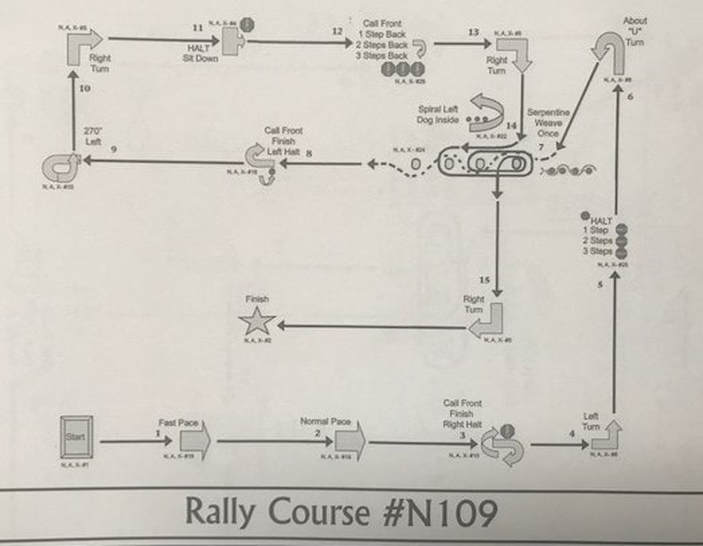
1. Fast Pace
2. Normal Pace
3. Call Front Finish Right Halt
4. Left Turn
5. Halt 1,2,3 Steps
6. About "U" Turn
7. Serpentine Weave Once
8. Call Front Finish Left Halt
9. 270 Degree Left
10. Right Turn
11. Halt Sit Down
12. Call Front 1,2,3 Steps Back
13. Right Turn
14. Spiral Left Dog Inside
15. Right Turn
2. Normal Pace
3. Call Front Finish Right Halt
4. Left Turn
5. Halt 1,2,3 Steps
6. About "U" Turn
7. Serpentine Weave Once
8. Call Front Finish Left Halt
9. 270 Degree Left
10. Right Turn
11. Halt Sit Down
12. Call Front 1,2,3 Steps Back
13. Right Turn
14. Spiral Left Dog Inside
15. Right Turn
BREAKFAST BOWL - Skills Set #21:
|
Warmups - The Basics - Daily Reviews
Rapt Attention ("watch me") - gradually add more and more distractions
Nose Targeting (and/or Target stick) -Hold clicker and treats in RH. Hold out your empty LH in an inviting manner (2 or 3 fingers straight to form a "target stick" of sorts). Most dogs will sniff it out of curiosity. Click and treat with your RH as soon as dog sniffs or touches your left hand. Repeat a bunch of times. Then switch hands. Make it into a fun game, holding your hand low to ground or high so dog has to jump. Say "touch". Use the target stick in the same way. (You can start to bring your LH back behind you in preparation for teaching the left finish, or your RH back behind you for the right finish.) Target Pad/Board - "Magnetize" the target pad - click and treat anytime dog gets all 4 feet on target bad ...... position target pad/handler into "front" "side" "heel" ,,,, positions then give commands for stand/sit/down ..... work on puppy pushups ....-practice moving into positions (into finish or into front after sit/down stay and "come". You will use this to perfect stands, different types of downs and sits, to aide with positions (heel, side, front), for stays and all sorts of things. To be truly "magnetized" the dog will run to get on the target pad as soon as you drop it on the ground. VELCRO DOG (Teaching Heel): Train off leash. Walk around briskly, left arm on your stomach, elbow tucked in, head and shoulders straight. (Show your dog the 'right" picture). Don't say anything, just start walking. The instant your dog comes anywhere near heel position, click and treat and then change directions. Repeat this exercise for a few minutes at a time in many different locations for about 1-2 weeks. Run around - be silly. Once your dog is staying with you and you couldn't get rid of him eve if you tried, you may go onto the next step. Change of Pace (SIGNS #17-19) Slow, Fast, Normal, Slow pace: Slow means you move slowly enough that your dog is walking; Normal is when your dog is trotting comfortably; Fast means you jog so dog is running or at least trotting at a very fast pace. Practice heeling to a metronome. Make sure you are rolling your foot, standing in the correct posture, and that your stride is the same with each beat. For the slow pace, make your stride a little smaller and stand up a little straighter (and breathe slower!). For the fast pace, use a somewhat longer stride with your torso tilted a bit forward. No matter the pace, always do the heel/center/toe roll with your feet with left hand up at your waist, elbow tucked in. Fronts and Finishes: Call Front Finish Left Halt; Call Front Finish Right Halt; Call Front Finish Left Forward. Can still include Recall Games for fun - optional Sit STAY in Heel Position (use target pad to left of handler -- use a wall/fence for straight sits ... gradually increase duration of sit before click/treat. Start to take a step or 2 - goal = "walk around") Down STAY in Heel Position (use target pad to left of handler -- use a wall/fence for straight sits ... gradually increase duration of down before click/treat. Start to take a step or 2 - goal = "walk around") (Eventually raise criteria for all of these skills (make dog hold attention longer before click/treat; change venue and practice in parking lots, fields, schoolyards, parks, stores, downtown. Dog should be able to do pretty well after a couple of weeks of daily attention work but it is important to reinforce lifelong.) Signs: "5 New - 5 review" Upcoming Signs - Choose 5: 1. Serpentine Weave Once 2. About Turn Right 3. Spiral Right Dog Outside 4. Slow Pace 5. Normal Pace 6. Halt Sit 7. 270 Degree Left 8. Straight Figure 8 Weave Twice 9. Call Front Finish Left Forward 10. Halt Down Walk Around Dog 11. Right Turn 12. Left About Turn 13. Left Turn 14. About " U" Turn 15. Halt Walk Around Dog Choose 5 Additional Review Signs: |
Course for NEXT Session:
1. Serpentine Weave Once
2. About Turn Right 3. Spiral Right Dog Outside 4. Slow Pace 5. Normal Pace 6. Halt Sit 7. 270 Degree Left 8. Straight Figure 8 Weave Twice 9. Call Front Finish Left Forward 10. Halt Down Walk Around Dog 11. Right Turn 12. Left About Turn 13. Left Turn 14. About " U" Turn 15. Halt Walk Around Dog |
1. 360 Degree Right
2. Serpentine Weave Once
3. 270 Degree Left
4. Fast Pace
5. Normal Pace
6. 270 Degree Left
7. Right Turn
8. Halt Sit Down
9. Call Front Finish Left Halt
10. Spiral Left Dog Inside
11. 260 Degree Left
12. Halt 1,2,3 Steps
13. Right Turn
13. 270 Degree Left
2. Serpentine Weave Once
3. 270 Degree Left
4. Fast Pace
5. Normal Pace
6. 270 Degree Left
7. Right Turn
8. Halt Sit Down
9. Call Front Finish Left Halt
10. Spiral Left Dog Inside
11. 260 Degree Left
12. Halt 1,2,3 Steps
13. Right Turn
13. 270 Degree Left
NEW LEASH ON LIFE! - Skills Set #22:
|
Warmups - The Basics - Daily Reviews
Rapt Attention ("watch me") - gradually add more and more distractions
Nose Targeting (and/or Target stick) -Hold clicker and treats in RH. Hold out your empty LH in an inviting manner (2 or 3 fingers straight to form a "target stick" of sorts). Most dogs will sniff it out of curiosity. Click and treat with your RH as soon as dog sniffs or touches your left hand. Repeat a bunch of times. Then switch hands. Make it into a fun game, holding your hand low to ground or high so dog has to jump. Say "touch". Use the target stick in the same way. (You can start to bring your LH back behind you in preparation for teaching the left finish, or your RH back behind you for the right finish.) Target Pad/Board - "Magnetize" the target pad - click and treat anytime dog gets all 4 feet on target bad ...... position target pad/handler into "front" "side" "heel" ,,,, positions then give commands for stand/sit/down ..... work on puppy pushups ....-practice moving into positions (into finish or into front after sit/down stay and "come". You will use this to perfect stands, different types of downs and sits, to aide with positions (heel, side, front), for stays and all sorts of things. To be truly "magnetized" the dog will run to get on the target pad as soon as you drop it on the ground. VELCRO DOG (Teaching Heel): Train off leash. Walk around briskly, left arm on your stomach, elbow tucked in, head and shoulders straight. (Show your dog the 'right" picture). Don't say anything, just start walking. The instant your dog comes anywhere near heel position, click and treat and then change directions. Repeat this exercise for a few minutes at a time in many different locations for about 1-2 weeks. Run around - be silly. Once your dog is staying with you and you couldn't get rid of him eve if you tried, you may go onto the next step. Change of Pace (SIGNS #17-19) Slow, Fast, Normal, Slow pace: Slow means you move slowly enough that your dog is walking; Normal is when your dog is trotting comfortably; Fast means you jog so dog is running or at least trotting at a very fast pace. Practice heeling to a metronome. Make sure you are rolling your foot, standing in the correct posture, and that your stride is the same with each beat. For the slow pace, make your stride a little smaller and stand up a little straighter (and breathe slower!). For the fast pace, use a somewhat longer stride with your torso tilted a bit forward. No matter the pace, always do the heel/center/toe roll with your feet with left hand up at your waist, elbow tucked in. Fronts and Finishes: Call Front Finish Left Halt; Call Front Finish Right Halt; Call Front Finish Left Forward. Can still include Recall Games for fun - optional Sit STAY in Heel Position (use target pad to left of handler -- use a wall/fence for straight sits ... gradually increase duration of sit before click/treat. Start to take a step or 2 - goal = "walk around") Down STAY in Heel Position (use target pad to left of handler -- use a wall/fence for straight sits ... gradually increase duration of down before click/treat. Start to take a step or 2 - goal = "walk around") Signs: "5 New - 5 review" |
Course for NEXT Session:
|
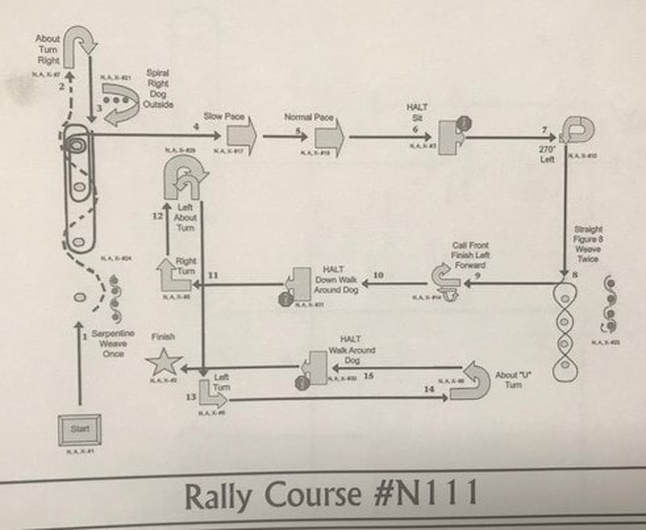
1. Serpentine Weave Once
2. About Turn Right
3. Spiral Right Dog Outside
4. Slow Pace
5. Normal Pace
6. Halt Sit
7. 270 Degree Left
8. Straight Figure 8 Weave Twice
9. Call Front Finish Left Forward
10. Halt Down Walk Around Dog
11. Right Turn
12. Left About Turn
13. Left Turn
14. About " U" Turn
15. Halt Walk Around Dog
2. About Turn Right
3. Spiral Right Dog Outside
4. Slow Pace
5. Normal Pace
6. Halt Sit
7. 270 Degree Left
8. Straight Figure 8 Weave Twice
9. Call Front Finish Left Forward
10. Halt Down Walk Around Dog
11. Right Turn
12. Left About Turn
13. Left Turn
14. About " U" Turn
15. Halt Walk Around Dog
Snuggle Time - Skills Set #23:
|
Warmups - The Basics - Daily Reviews
Rapt Attention ("watch me") - gradually add more and more distractions
Nose Targeting (and/or Target stick) -Hold clicker and treats in RH. Hold out your empty LH in an inviting manner (2 or 3 fingers straight to form a "target stick" of sorts). Most dogs will sniff it out of curiosity. Click and treat with your RH as soon as dog sniffs or touches your left hand. Repeat a bunch of times. Then switch hands. Make it into a fun game, holding your hand low to ground or high so dog has to jump. Say "touch". Use the target stick in the same way. (You can start to bring your LH back behind you in preparation for teaching the left finish, or your RH back behind you for the right finish.) Target Pad/Board - "Magnetize" the target pad - click and treat anytime dog gets all 4 feet on target bad ...... position target pad/handler into "front" "side" "heel" ,,,, positions then give commands for stand/sit/down ..... work on puppy pushups ....-practice moving into positions (into finish or into front after sit/down stay and "come". You will use this to perfect stands, different types of downs and sits, to aide with positions (heel, side, front), for stays and all sorts of things. To be truly "magnetized" the dog will run to get on the target pad as soon as you drop it on the ground. VELCRO DOG (Teaching Heel): Train off leash. Walk around briskly, left arm on your stomach, elbow tucked in, head and shoulders straight. (Show your dog the 'right" picture). Don't say anything, just start walking. The instant your dog comes anywhere near heel position, click and treat and then change directions. Repeat this exercise for a few minutes at a time in many different locations for about 1-2 weeks. Run around - be silly. Once your dog is staying with you and you couldn't get rid of him eve if you tried, you may go onto the next step. Change of Pace (SIGNS #17-19) Slow, Fast, Normal, Slow pace: Slow means you move slowly enough that your dog is walking; Normal is when your dog is trotting comfortably; Fast means you jog so dog is running or at least trotting at a very fast pace. Practice heeling to a metronome. Make sure you are rolling your foot, standing in the correct posture, and that your stride is the same with each beat. For the slow pace, make your stride a little smaller and stand up a little straighter (and breathe slower!). For the fast pace, use a somewhat longer stride with your torso tilted a bit forward. No matter the pace, always do the heel/center/toe roll with your feet with left hand up at your waist, elbow tucked in. Fronts and Finishes: Call Front Finish Left Halt; Call Front Finish Right Halt; Call Front Finish Left Forward. Can still include Recall Games for fun - optional Sit STAY in Heel Position (use target pad to left of handler -- use a wall/fence for straight sits ... gradually increase duration of sit before click/treat. Start to take a step or 2 - goal = "walk around") Down STAY in Heel Position (use target pad to left of handler -- use a wall/fence for straight sits ... gradually increase duration of down before click/treat. Start to take a step or 2 - goal = "walk around") Signs: "5 New - 5 review" |
Course for NEXT Session: Pickwick's Post Course TBA coming soon . . . . . |
SWEET POTATO TREATS - Skills Set #24:
|
Warmups - The Basics - Daily Reviews
Rapt Attention ("watch me") - gradually add more and more distractions
Nose Targeting (and/or Target stick) -Hold clicker and treats in RH. Hold out your empty LH in an inviting manner (2 or 3 fingers straight to form a "target stick" of sorts). Most dogs will sniff it out of curiosity. Click and treat with your RH as soon as dog sniffs or touches your left hand. Repeat a bunch of times. Then switch hands. Make it into a fun game, holding your hand low to ground or high so dog has to jump. Say "touch". Use the target stick in the same way. (You can start to bring your LH back behind you in preparation for teaching the left finish, or your RH back behind you for the right finish.) Target Pad/Board - "Magnetize" the target pad - click and treat anytime dog gets all 4 feet on target bad ...... position target pad/handler into "front" "side" "heel" ,,,, positions then give commands for stand/sit/down ..... work on puppy pushups ....-practice moving into positions (into finish or into front after sit/down stay and "come". You will use this to perfect stands, different types of downs and sits, to aide with positions (heel, side, front), for stays and all sorts of things. To be truly "magnetized" the dog will run to get on the target pad as soon as you drop it on the ground. VELCRO DOG (Teaching Heel): Train off leash. Walk around briskly, left arm on your stomach, elbow tucked in, head and shoulders straight. (Show your dog the 'right" picture). Don't say anything, just start walking. The instant your dog comes anywhere near heel position, click and treat and then change directions. Repeat this exercise for a few minutes at a time in many different locations for about 1-2 weeks. Run around - be silly. Once your dog is staying with you and you couldn't get rid of him eve if you tried, you may go onto the next step. Change of Pace (SIGNS #17-19) Slow, Fast, Normal, Slow pace: Slow means you move slowly enough that your dog is walking; Normal is when your dog is trotting comfortably; Fast means you jog so dog is running or at least trotting at a very fast pace. Practice heeling to a metronome. Make sure you are rolling your foot, standing in the correct posture, and that your stride is the same with each beat. For the slow pace, make your stride a little smaller and stand up a little straighter (and breathe slower!). For the fast pace, use a somewhat longer stride with your torso tilted a bit forward. No matter the pace, always do the heel/center/toe roll with your feet with left hand up at your waist, elbow tucked in. Fronts and Finishes: Call Front Finish Left Halt; Call Front Finish Right Halt; Call Front Finish Left Forward. Can still include Recall Games for fun - optional Sit STAY in Heel Position (use target pad to left of handler -- use a wall/fence for straight sits ... gradually increase duration of sit before click/treat. Start to take a step or 2 - goal = "walk around") Down STAY in Heel Position (use target pad to left of handler -- use a wall/fence for straight sits ... gradually increase duration of down before click/treat. Start to take a step or 2 - goal = "walk around") (Eventually raise criteria for all of these skills (make dog hold attention longer before click/treat; change venue and practice in parking lots, fields, schoolyards, parks, stores, downtown. Dog should be able to do pretty well after a couple of weeks of daily attention work but it is important to reinforce lifelong.) Signs: "5 New - 5 review" 5 New Signs: 5 Review Signs: Course: Rally Course Pickwick's Post Course TBA End with playtime and lots of attention |
Course for NEXT Session (Judge Nancy Watson's Course)
|
GO FOR THE GOLD - Final Course Challenges (Actual Courses Designed by AKC Judges)
Trial Course A - Skills Set #25
|
Warmups - The Basics - Daily Reviews
Rapt Attention ("watch me") - gradually add more and more distractions
Nose Targeting (and/or Target stick) -Hold clicker and treats in RH. Hold out your empty LH in an inviting manner (2 or 3 fingers straight to form a "target stick" of sorts). Most dogs will sniff it out of curiosity. Click and treat with your RH as soon as dog sniffs or touches your left hand. Repeat a bunch of times. Then switch hands. Make it into a fun game, holding your hand low to ground or high so dog has to jump. Say "touch". Use the target stick in the same way. (You can start to bring your LH back behind you in preparation for teaching the left finish, or your RH back behind you for the right finish.) Target Pad/Board - "Magnetize" the target pad - click and treat anytime dog gets all 4 feet on target bad ...... position target pad/handler into "front" "side" "heel" ,,,, positions then give commands for stand/sit/down ..... work on puppy pushups ....-practice moving into positions (into finish or into front after sit/down stay and "come". You will use this to perfect stands, different types of downs and sits, to aide with positions (heel, side, front), for stays and all sorts of things. To be truly "magnetized" the dog will run to get on the target pad as soon as you drop it on the ground. VELCRO DOG (Teaching Heel): Train off leash. Walk around briskly, left arm on your stomach, elbow tucked in, head and shoulders straight. (Show your dog the 'right" picture). Don't say anything, just start walking. The instant your dog comes anywhere near heel position, click and treat and then change directions. Repeat this exercise for a few minutes at a time in many different locations for about 1-2 weeks. Run around - be silly. Once your dog is staying with you and you couldn't get rid of him eve if you tried, you may go onto the next step. Change of Pace (SIGNS #17-19) Slow, Fast, Normal, Slow pace: Slow means you move slowly enough that your dog is walking; Normal is when your dog is trotting comfortably; Fast means you jog so dog is running or at least trotting at a very fast pace. Practice heeling to a metronome. Make sure you are rolling your foot, standing in the correct posture, and that your stride is the same with each beat. For the slow pace, make your stride a little smaller and stand up a little straighter (and breathe slower!). For the fast pace, use a somewhat longer stride with your torso tilted a bit forward. No matter the pace, always do the heel/center/toe roll with your feet with left hand up at your waist, elbow tucked in. Fronts and Finishes: Call Front Finish Left Halt; Call Front Finish Right Halt; Call Front Finish Left Forward. Can still include Recall Games for fun - optional Sit STAY in Heel Position (use target pad to left of handler -- use a wall/fence for straight sits ... gradually increase duration of sit before click/treat. Start to take a step or 2 - goal = "walk around") Down STAY in Heel Position (use target pad to left of handler -- use a wall/fence for straight sits ... gradually increase duration of down before click/treat. Start to take a step or 2 - goal = "walk around") Signs: "5 New - 5 review" |
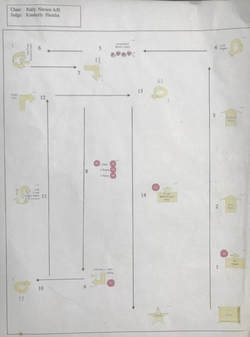
Course for NEXT Session
|
GO FOR THE GOLD - Final Course Challenges (Actual Courses Designed by AKC Judges)
Trial Course B - Skills Set #26
|
Warmups - The Basics - Daily Reviews
Rapt Attention ("watch me") - gradually add more and more distractions
Nose Targeting (and/or Target stick) -Hold clicker and treats in RH. Hold out your empty LH in an inviting manner (2 or 3 fingers straight to form a "target stick" of sorts). Most dogs will sniff it out of curiosity. Click and treat with your RH as soon as dog sniffs or touches your left hand. Repeat a bunch of times. Then switch hands. Make it into a fun game, holding your hand low to ground or high so dog has to jump. Say "touch". Use the target stick in the same way. (You can start to bring your LH back behind you in preparation for teaching the left finish, or your RH back behind you for the right finish.) Target Pad/Board - "Magnetize" the target pad - click and treat anytime dog gets all 4 feet on target bad ...... position target pad/handler into "front" "side" "heel" ,,,, positions then give commands for stand/sit/down ..... work on puppy pushups ....-practice moving into positions (into finish or into front after sit/down stay and "come". You will use this to perfect stands, different types of downs and sits, to aide with positions (heel, side, front), for stays and all sorts of things. To be truly "magnetized" the dog will run to get on the target pad as soon as you drop it on the ground. VELCRO DOG (Teaching Heel): Train off leash. Walk around briskly, left arm on your stomach, elbow tucked in, head and shoulders straight. (Show your dog the 'right" picture). Don't say anything, just start walking. The instant your dog comes anywhere near heel position, click and treat and then change directions. Repeat this exercise for a few minutes at a time in many different locations for about 1-2 weeks. Run around - be silly. Once your dog is staying with you and you couldn't get rid of him eve if you tried, you may go onto the next step. Change of Pace (SIGNS #17-19) Slow, Fast, Normal, Slow pace: Slow means you move slowly enough that your dog is walking; Normal is when your dog is trotting comfortably; Fast means you jog so dog is running or at least trotting at a very fast pace. Practice heeling to a metronome. Make sure you are rolling your foot, standing in the correct posture, and that your stride is the same with each beat. For the slow pace, make your stride a little smaller and stand up a little straighter (and breathe slower!). For the fast pace, use a somewhat longer stride with your torso tilted a bit forward. No matter the pace, always do the heel/center/toe roll with your feet with left hand up at your waist, elbow tucked in. Fronts and Finishes: Call Front Finish Left Halt; Call Front Finish Right Halt; Call Front Finish Left Forward. Can still include Recall Games for fun - optional Sit STAY in Heel Position (use target pad to left of handler -- use a wall/fence for straight sits ... gradually increase duration of sit before click/treat. Start to take a step or 2 - goal = "walk around") Down STAY in Heel Position (use target pad to left of handler -- use a wall/fence for straight sits ... gradually increase duration of down before click/treat. Start to take a step or 2 - goal = "walk around") (Eventually raise criteria for all of these skills (make dog hold attention longer before click/treat; change venue and practice in parking lots, fields, schoolyards, parks, stores, downtown. Dog should be able to do pretty well after a couple of weeks of daily attention work but it is important to reinforce lifelong.) Signs: "5 New - 5 review" |
Course for NEXT Session:
|
GO FOR THE GOLD - Final Course Challenges (Actual Courses Designed by AKC Judges)
Trial Course C - Skills Set #27
|
Warmups - The Basics - Daily Reviews
Rapt Attention ("watch me") - gradually add more and more distractions
Nose Targeting (and/or Target stick) -Hold clicker and treats in RH. Hold out your empty LH in an inviting manner (2 or 3 fingers straight to form a "target stick" of sorts). Most dogs will sniff it out of curiosity. Click and treat with your RH as soon as dog sniffs or touches your left hand. Repeat a bunch of times. Then switch hands. Make it into a fun game, holding your hand low to ground or high so dog has to jump. Say "touch". Use the target stick in the same way. (You can start to bring your LH back behind you in preparation for teaching the left finish, or your RH back behind you for the right finish.) Target Pad/Board - "Magnetize" the target pad - click and treat anytime dog gets all 4 feet on target bad ...... position target pad/handler into "front" "side" "heel" ,,,, positions then give commands for stand/sit/down ..... work on puppy pushups ....-practice moving into positions (into finish or into front after sit/down stay and "come". You will use this to perfect stands, different types of downs and sits, to aide with positions (heel, side, front), for stays and all sorts of things. To be truly "magnetized" the dog will run to get on the target pad as soon as you drop it on the ground. VELCRO DOG (Teaching Heel): Train off leash. Walk around briskly, left arm on your stomach, elbow tucked in, head and shoulders straight. (Show your dog the 'right" picture). Don't say anything, just start walking. The instant your dog comes anywhere near heel position, click and treat and then change directions. Repeat this exercise for a few minutes at a time in many different locations for about 1-2 weeks. Run around - be silly. Once your dog is staying with you and you couldn't get rid of him eve if you tried, you may go onto the next step. Change of Pace (SIGNS #17-19) Slow, Fast, Normal, Slow pace: Slow means you move slowly enough that your dog is walking; Normal is when your dog is trotting comfortably; Fast means you jog so dog is running or at least trotting at a very fast pace. Practice heeling to a metronome. Make sure you are rolling your foot, standing in the correct posture, and that your stride is the same with each beat. For the slow pace, make your stride a little smaller and stand up a little straighter (and breathe slower!). For the fast pace, use a somewhat longer stride with your torso tilted a bit forward. No matter the pace, always do the heel/center/toe roll with your feet with left hand up at your waist, elbow tucked in. Fronts and Finishes: Call Front Finish Left Halt; Call Front Finish Right Halt; Call Front Finish Left Forward. Can still include Recall Games for fun - optional Sit STAY in Heel Position (use target pad to left of handler -- use a wall/fence for straight sits ... gradually increase duration of sit before click/treat. Start to take a step or 2 - goal = "walk around") Down STAY in Heel Position (use target pad to left of handler -- use a wall/fence for straight sits ... gradually increase duration of down before click/treat. Start to take a step or 2 - goal = "walk around") Signs: "5 New - 5 review" |
Course for NEXT Session:
(TBA - Doodle By Design with NEW signs incorporated) |
PICKWICK'S DOODLE (TBA ) - Set #28
CREATE A COURSE CHOOSING FROM FOLLOWING SIGNS (include at least 3 of the new ones, SIGNS #37-42; 2 CONES; 2 FINISHES; 1 CHALLENGE; 2 FINISHES)
Coming Soon ....
Coming Soon ....
PICKWICK'S DOODLE (TBA ) - Set #29
|
PICKWICK'S DOODLE (TBA ) - Set #30
|
1) START
2) FINISH
3) Halt-Sit - (While heeling, the handler halts and the dog sits in heel position.)
4) Halt-Sit-Down - (While heeling, the handler halts and the dog sits in heel position. The dog must then down in heel position.)
5) Right Turn - (90° turn to the right)
6) Left Turn - (90° turn to the left)
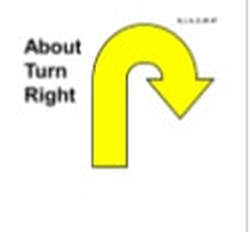
7) About Turn - (Right - 180° turn to the right)
8) About “U” Turn - (180° turn to the left)
9) 270° Right Turn - (While heeling, the dog and handler make a tight 270° turn to the right)
10) 270° Left Turn - (While heeling, the dog and handler make a tight 270° turn to the left)
11) 360° Right Turn - (While heeling, the dog and handler make a tight 360° turn to the right)
12) 360° Left Turn - (While heeling, the dog and handler make a tight 360° turn to the left)
13) Call Front – (Finish Right – Forward – While heeling, the handler stops forward motion and calls the dog to front. The handler may take several steps backward. The dog must come and sit in front. Without the handler moving their feet, the dog must finish to the right. As the dog clears the handler’s path, the handler will heel forward before the dog returns to heel position)
14) Call Front – Finish Left – Forward – (While heeling, the handler stops forward motion and calls the dog to front. The handler may take several steps backward. The dog must come and sit in front. Without the handler moving their feet, the dog must finish to the left. As the dog clears the handler’s path, the handler will heel forward before the dog returns to heel position)
15) Call Front – Finish Right – Sit –(While heeling, the handler stops forward motion and calls the dog to front. The handler may take several steps backward. The dog must come and sit in front. Without the handler moving their feet, the dog must finish to the right and sit in heel position)
15) Call Front – Finish Right – Sit –(While heeling, the handler stops forward motion and calls the dog to front. The handler may take several steps backward. The dog must come and sit in front. Without the handler moving their feet, the dog must finish to the right and sit in heel position)
16) Call Front – Finish Left – Sit – (While heeling, the handler stops forward motion and calls the dog to front. The handler may take several steps backward. The dog must come and sit in front. Without the handler moving their feet, the dog must finish to the left and sit in heel position)
17) Slow Pace - (The dog and handler must slow down noticeably. This must be followed by a normal pace sign unless it is the last station on the course.)
18) Fast Pace - (The dog and handler must speed up noticeably. This must be followed by a normal pace sign.)
19) Normal Pace - (The dog and handler walk briskly. This sign is only used after a slow or fast pace sign.)
20) Moving Side Step Right – (While heeling, the handler takes one step to the right, leading with the right foot, and continues heeling along the newly established line. The dog must move with the handler. This sign will be placed directly in line of the team’s path requiring the handler and dog to sidestep to the right to pass the sign.)
21) Spiral Right - Dog Outside - (This sign requires three pylons placed in a straight line with spaces between them of approximately 6-8 feet. The dog and handler must turn to the right to move around each of the pylons.)
22) Spiral Left - Dog Inside - (This sign requires three pylons placed in a straight line with spaces between them of approximately 6-8 feet. The dog and handler must turn to the left to move around each of the pylons.)
23) Straight Figure 8 Weave Twice - (This sign requires four pylons placed in a straight line with spaces between them of approximately 6-8 feet. The dog and handler will enter into the weave with the first pylon on their left side. They must complete the entire weave twice.)
24) Serpentine Weave Once - (This sign requires four pylons placed in a straight line with spaces between them of approximately 6-8 feet. The dog and handler will enter into the weave with the first pylon on their left side. They must complete the entire weave once.)
25) HALT - 1, 2 and 3 Steps - (While heeling, the handler halts and the dog sits in heel position. The handler takes one step forward, halts and the dog sits in heel position. The handler takes two steps forward, halts and the dog sits in heel position and then three steps forward, halts and the dog sits in heel position. The dog moves with the handler each time.)
26) Call Front – 1, 2 and 3 Steps Backward - Forward - (While heeling, the handler stops forward motion and calls the dog to front. The handler may take several steps backward. The dog must come and sit in front. The handler takes one step backward and halts. The dog must move with the handler and sit in front as the handler halts. The handler takes two steps backward and halts. The dog must move with the handler and sit in front as the handler halts. The handler takes three steps backward and halts. The dog must move with the handler and sit in front as the handler halts. The handler may command/signal the dog to finish. As the dog clears the handler’s path, the handler will heel forward before the dog returns to heel position.)
27) Stop and Down – (While heeling, the handler stops forward motion and the dog downs in heel position. The dog must stay down until the handler moves forward.)
28) HALT – Fast Forward from Sit – (While heeling, the handler halts and the dog sits in heel position. The dog and handler then heel forward at a fast pace. This must be followed by a normal pace sign)
29) Left About Turn – (While heeling, the handler will make an about turn to the left, while at the same time the dog must move around the handler to the right and into heel position.)
30) HALT - Walk Around – (While heeling, the handler halts and the dog sits in heel position. The dog must stay while the handler walks around behind the dog, returns to heel position and pauses. The handler must pause before heeling forward.)
31) HALT – Down – Walk Around - (While heeling, the handler halts and the dog sits in heel position. The dog must then down and stay while the handler walks around behind the dog, returns to heel position and pauses. The dog and handler then heel forward)
32) Figure 8 – No Distractions - (This sign requires two pylons spaced approximately 6-8 feet apart. The Figure 8 may be entered with the pylons on either the left or right side. The dog and handler will perform a complete figure 8 around the pylons, crossing the center line three time)
33) HALT – Right Turn – Forward - (While heeling, the handler halts and the dog sits in heel position. The handler and dog turn right together and heel forward)
34) HALT – Left Turn – Forward - (While heeling, the handler halts and the dog sits in heel position. The handler and dog turn left together and heel forward)
35) Call Front – Return to Heel – (While heeling, the handler stops forward motion and may command/signal the dog to front. The handler may take several steps backward. The dog must come and sit in front. The dog must stay while the handler walks around behind the dog to return to heel position. The handler must pause before heeling forward)
36) HALT – Slow Forward From Sit – (While heeling, the handler halts and the dog sits in heel position. The dog and handler then heel forward at a slow pace. This must be followed by a normal pace sign unless it is the last sign on the course.)
37) Loop Right - (While heeling, the dog and handler loop right crossing over the original path )
38) Loop Left - (While heeling, the dog and handler loop left crossing over the original path.)
39) Diagonal Right – (While heeling, the dog and handler make an open angle turn to the right. The dog must move with the handler. This sign will be placed directly in line of the team’s path)
40) Diagonal Left – (While heeling, the dog and handler make an open angle turn to the left. The dog must move with the handler. This sign will be placed directly in line of the team’s path)
41) Offset Serpentine Right - (This sign requires three pylons. The center pylon will be offset to the left by 3-4 feet with the other two spaced approximately 6-8 feet apart. The dog and handler will enter into the weave with the first pylon on their right side. They must complete the entire serpentine together)
42) Offset Serpentine Left - (This sign requires three pylons. The center pylon will be offset to the left by 3-4 feet with the other two spaced approximately 6-8 feet apart. The dog and handler will enter into the weave with the first pylon on their left side. They must complete the entire serpentine together)
